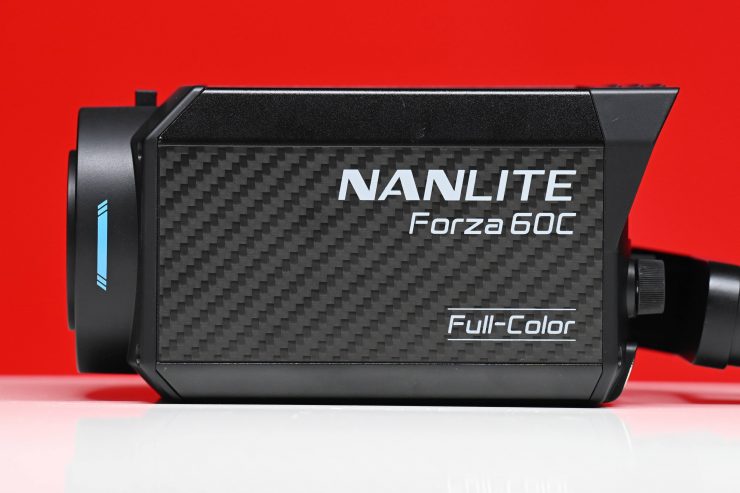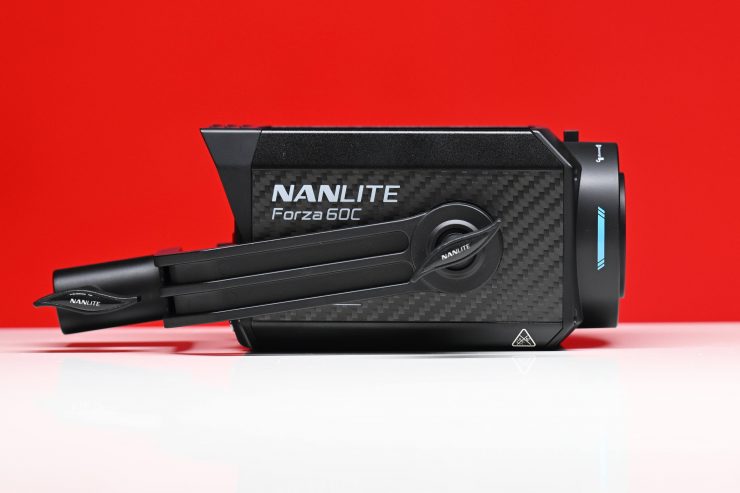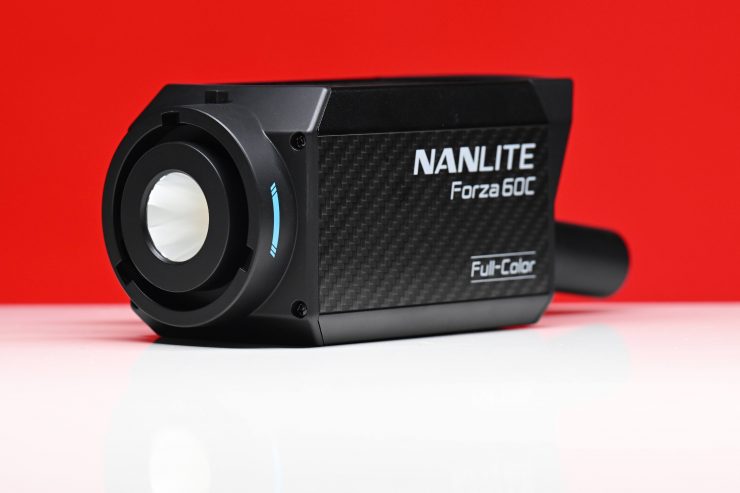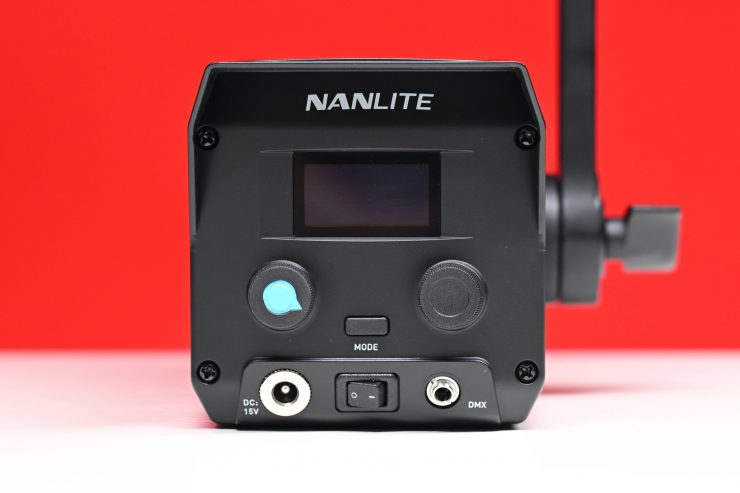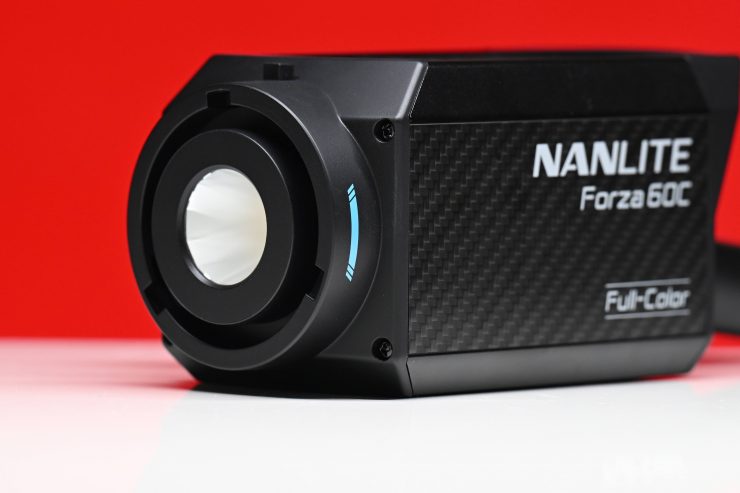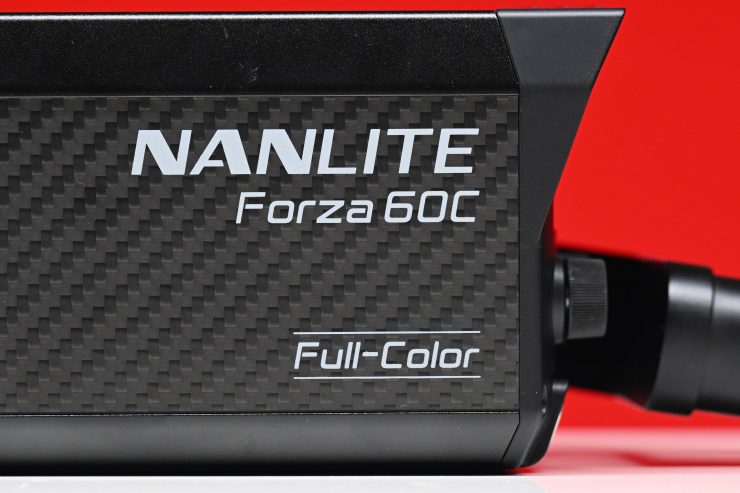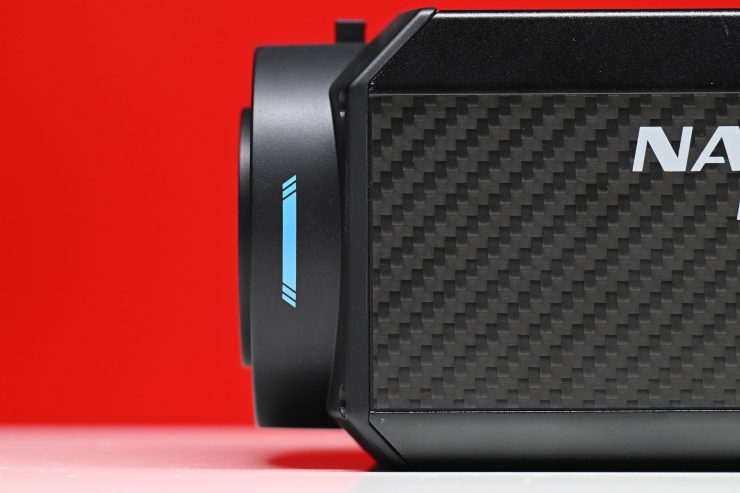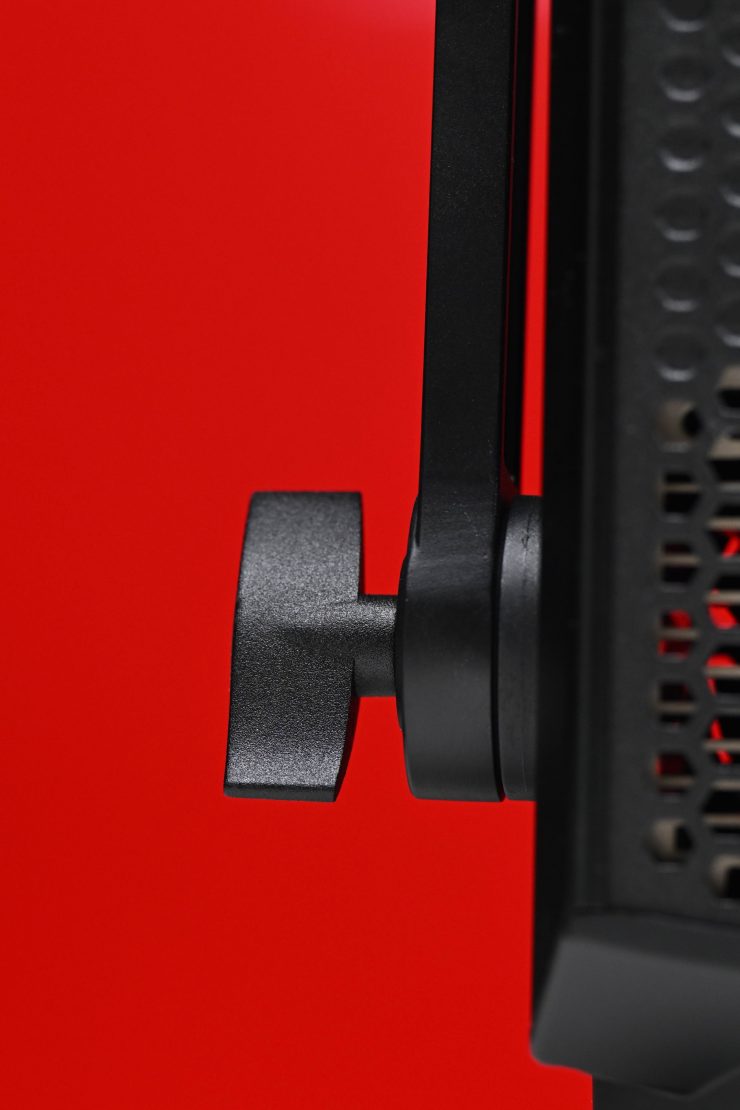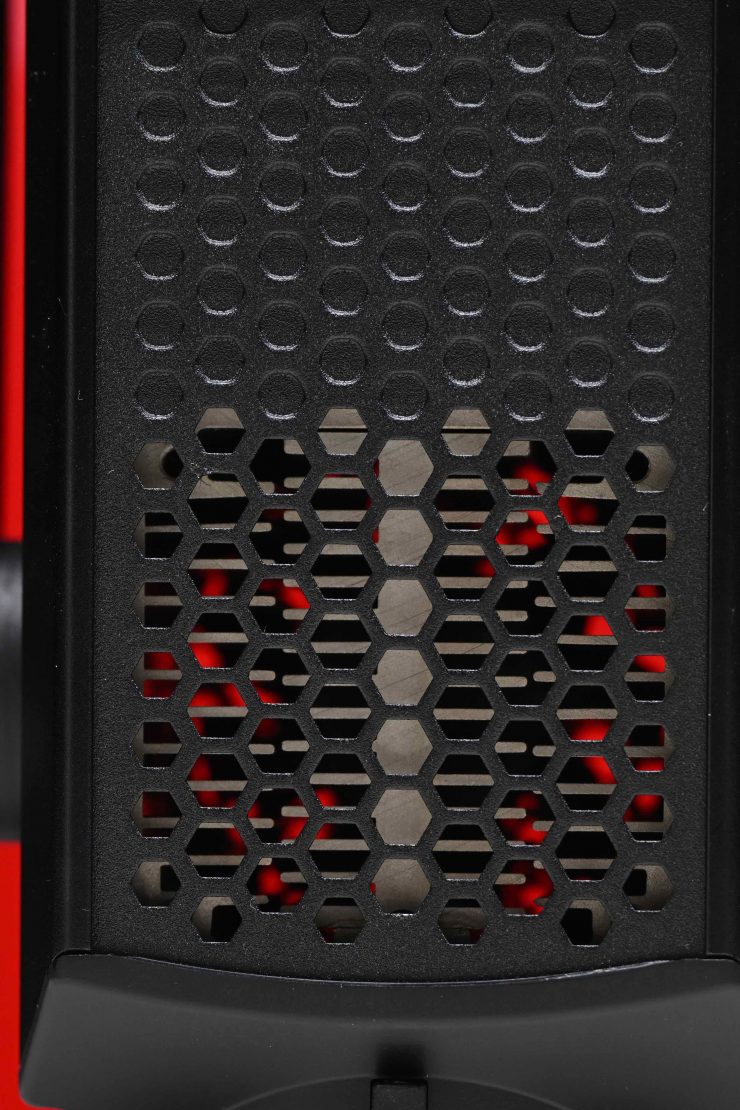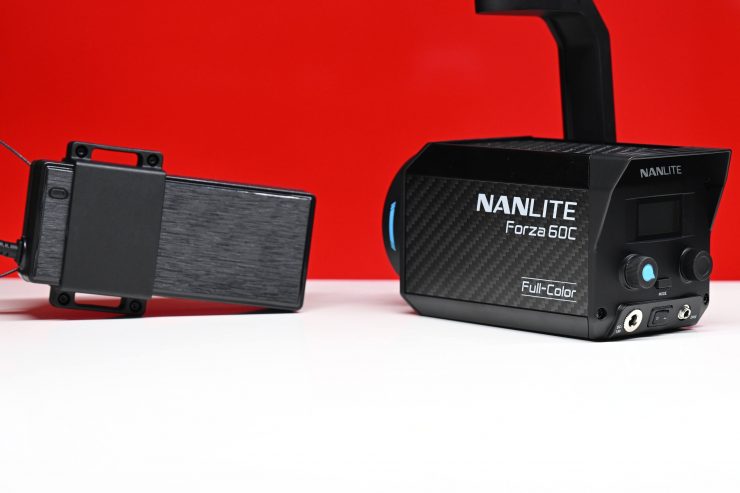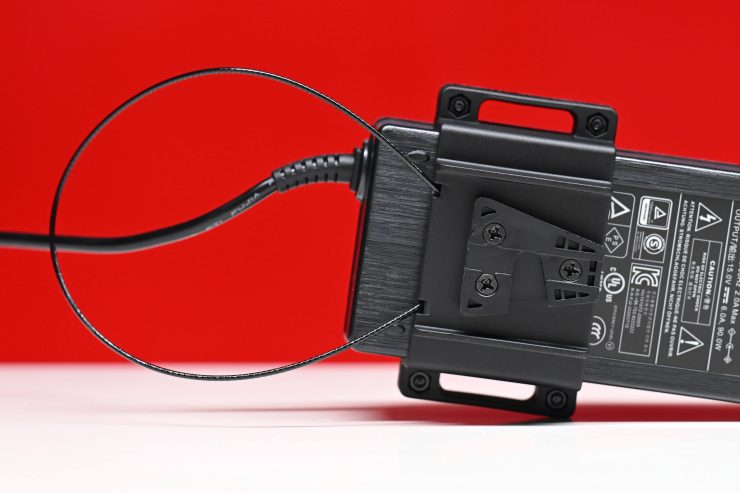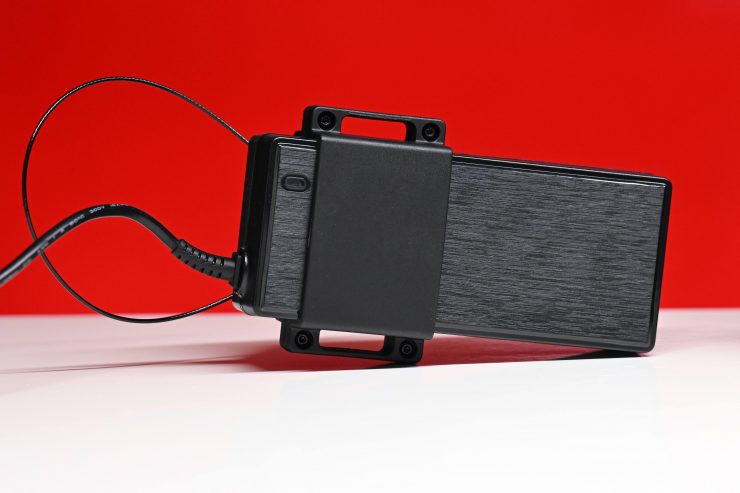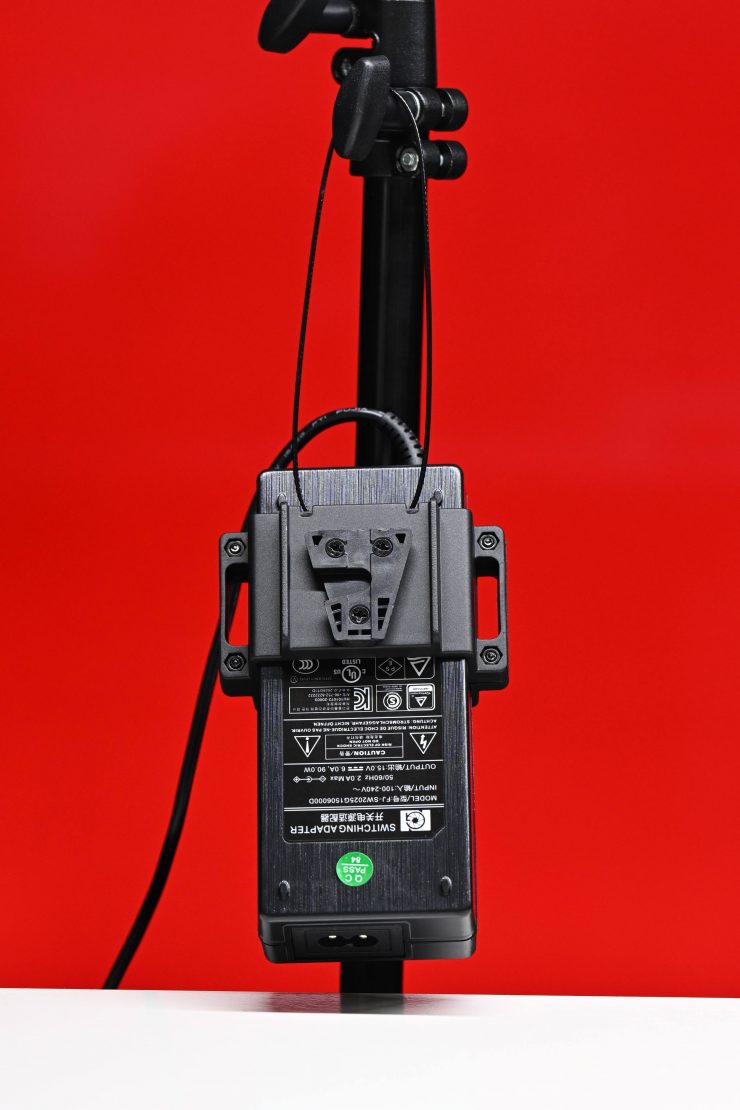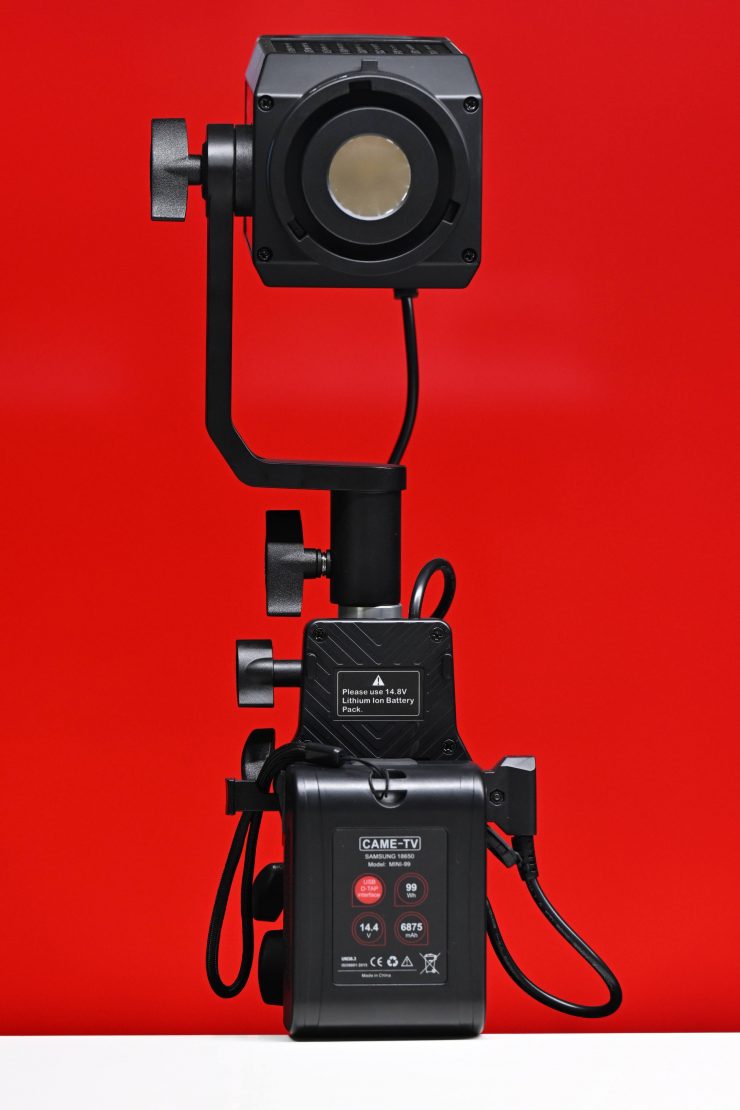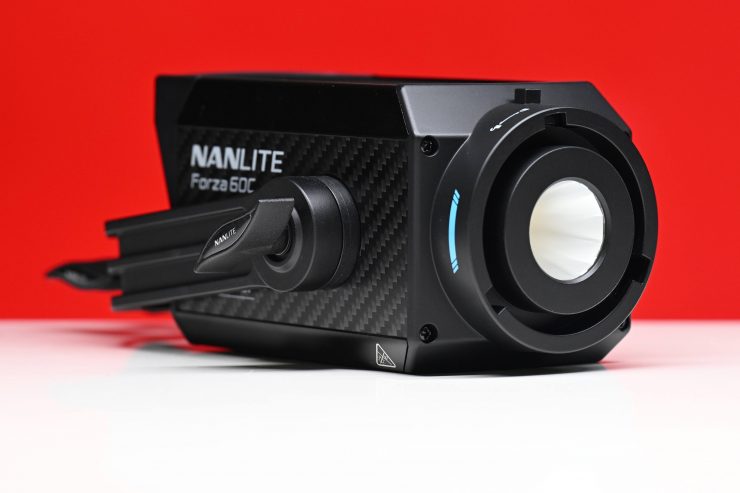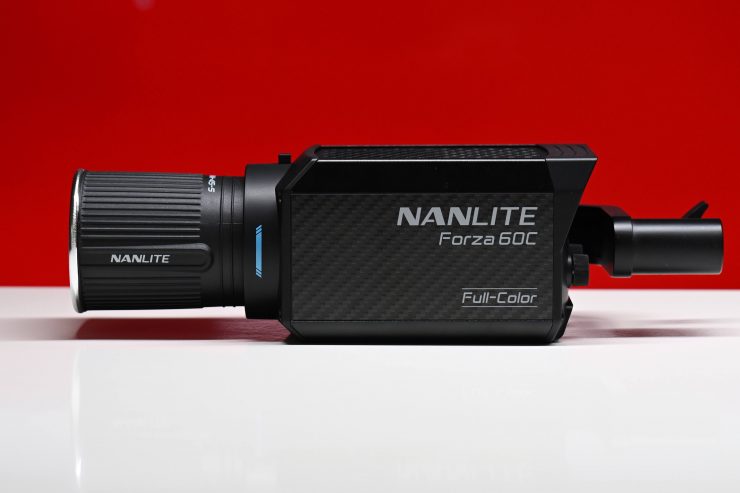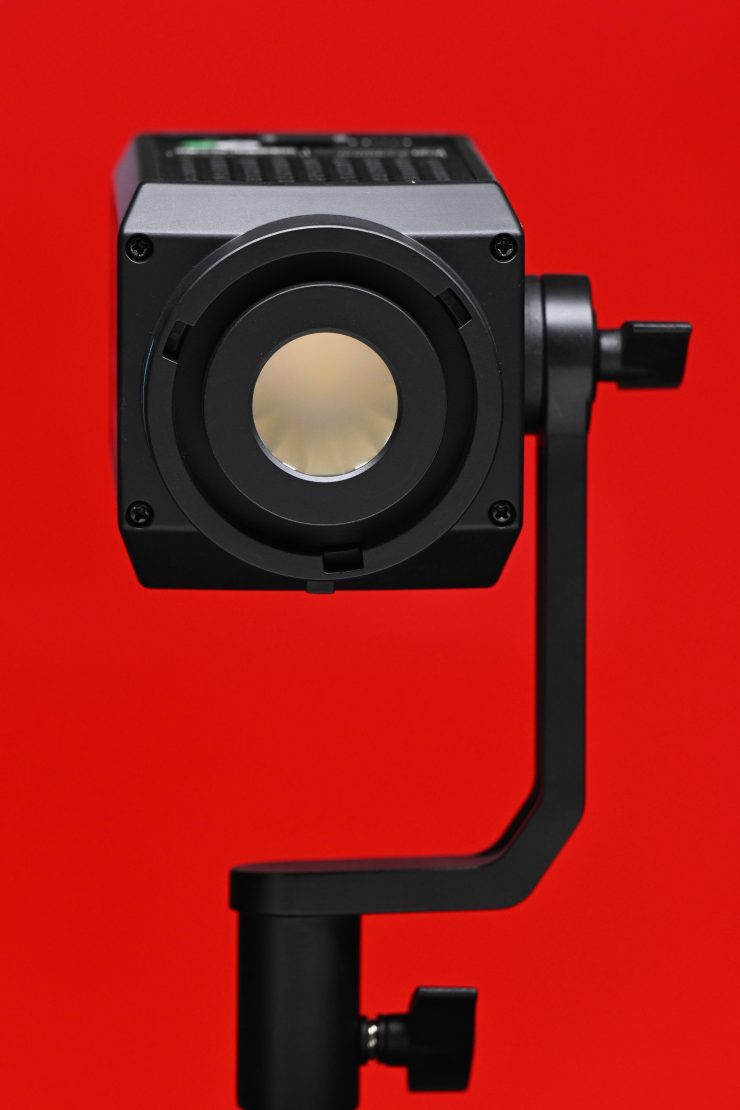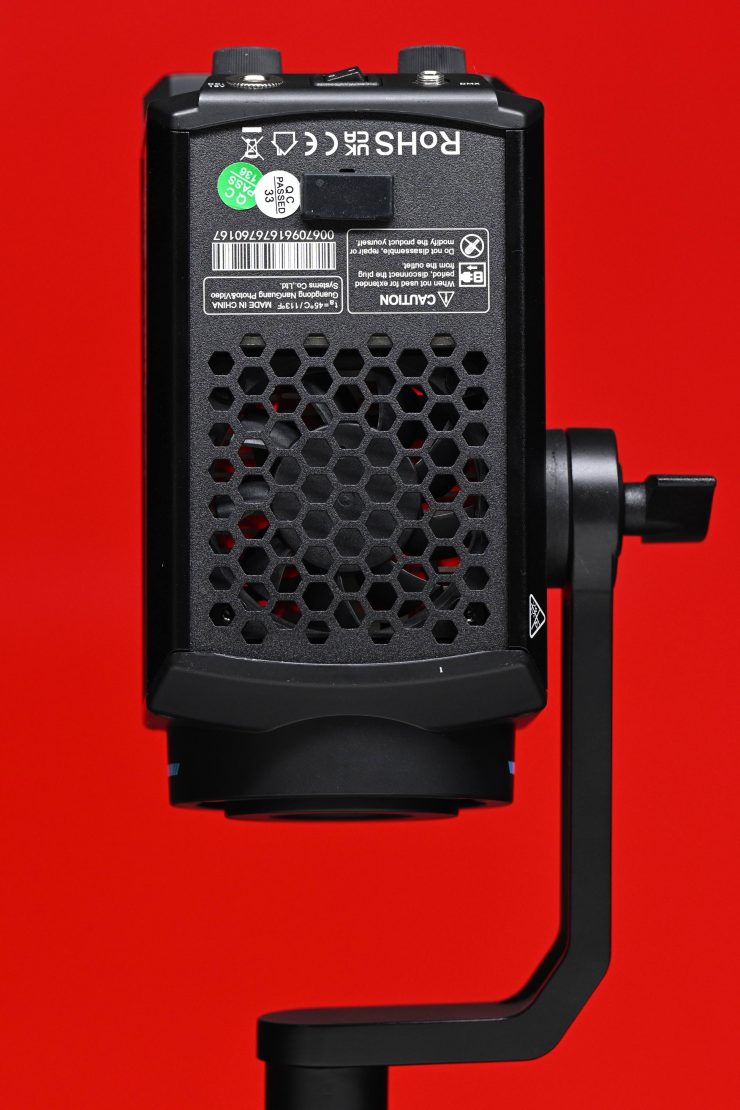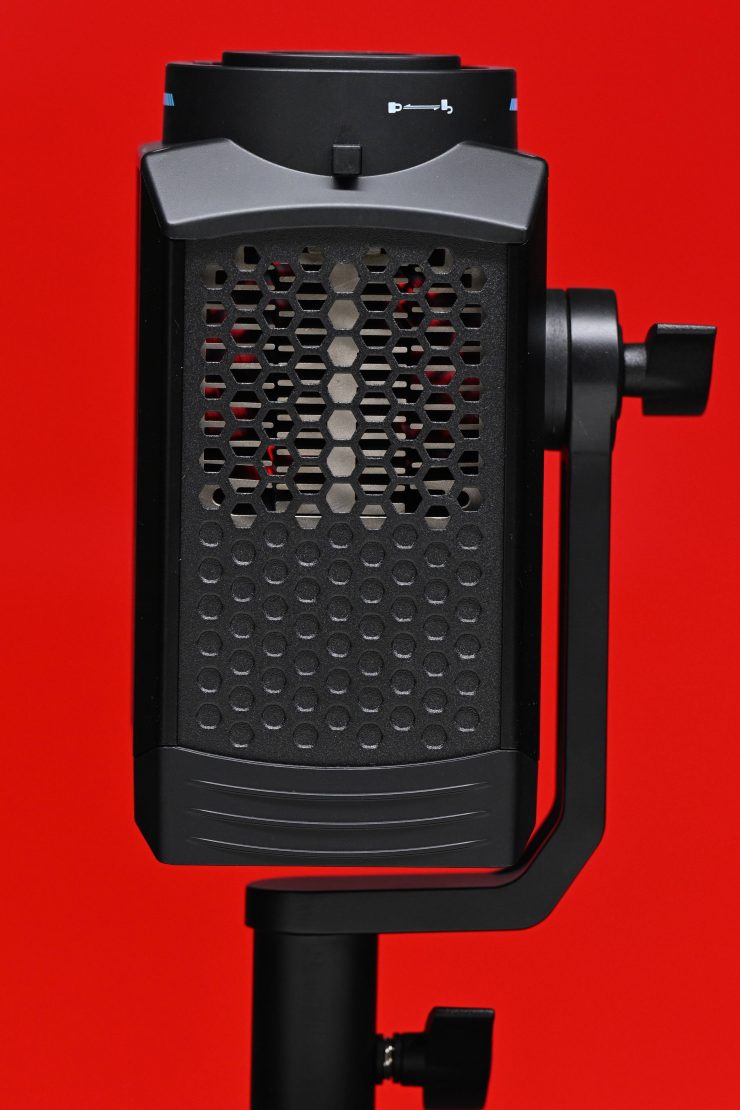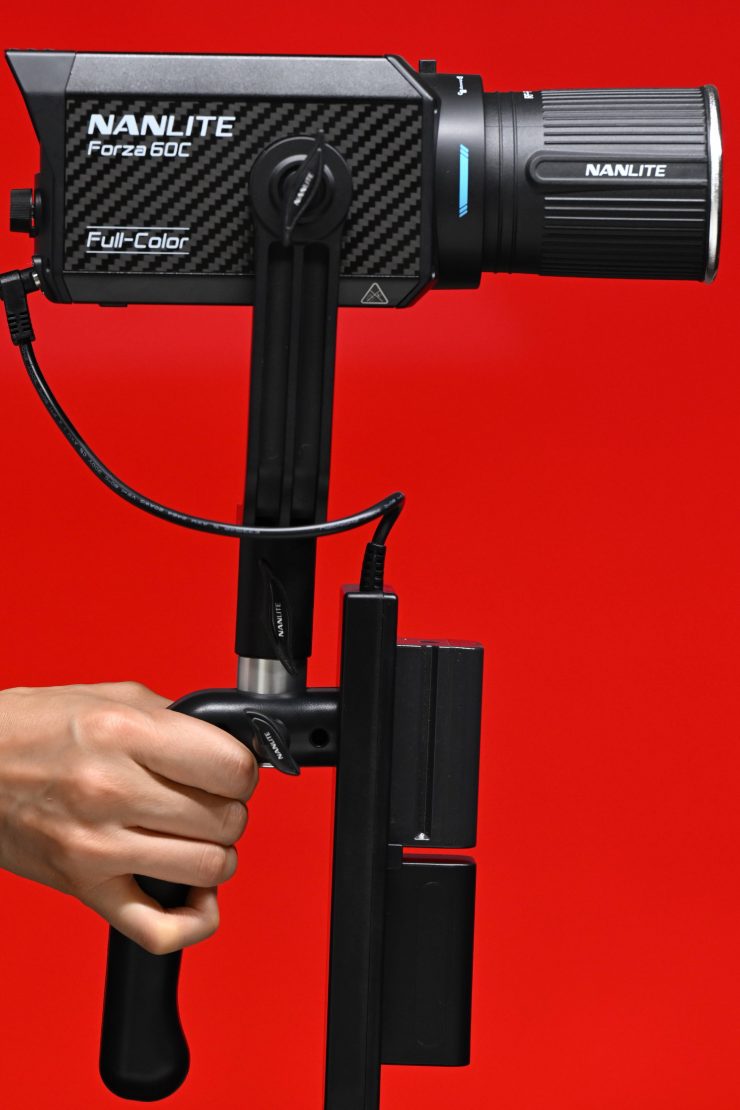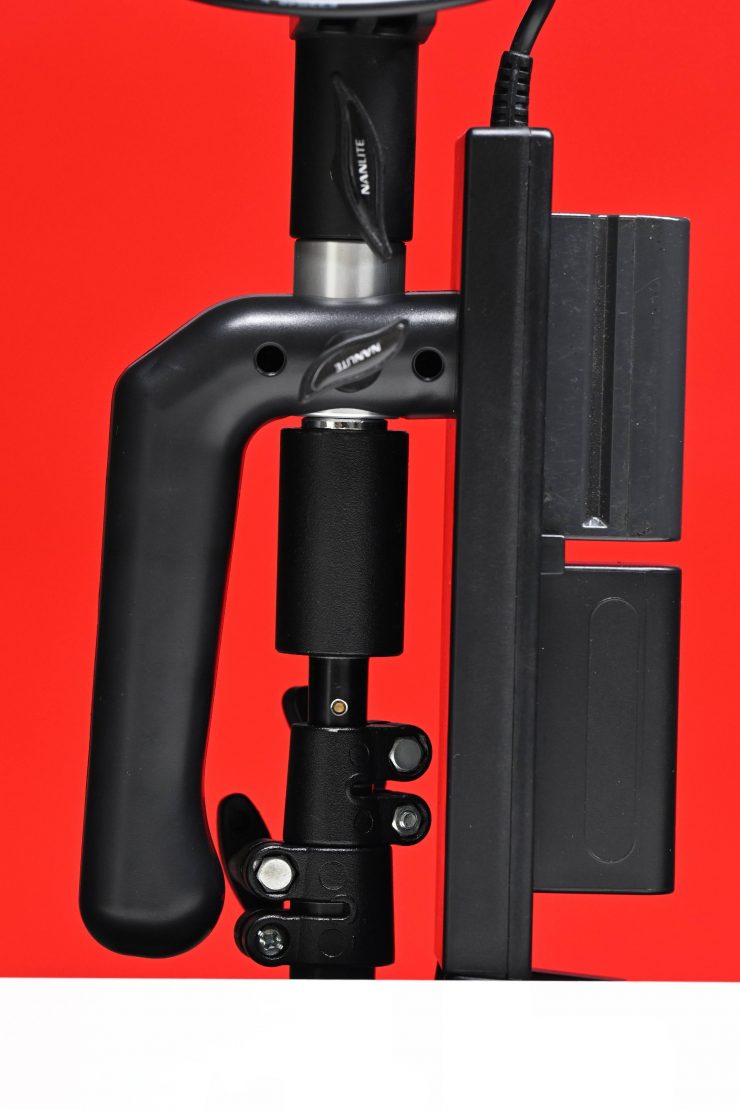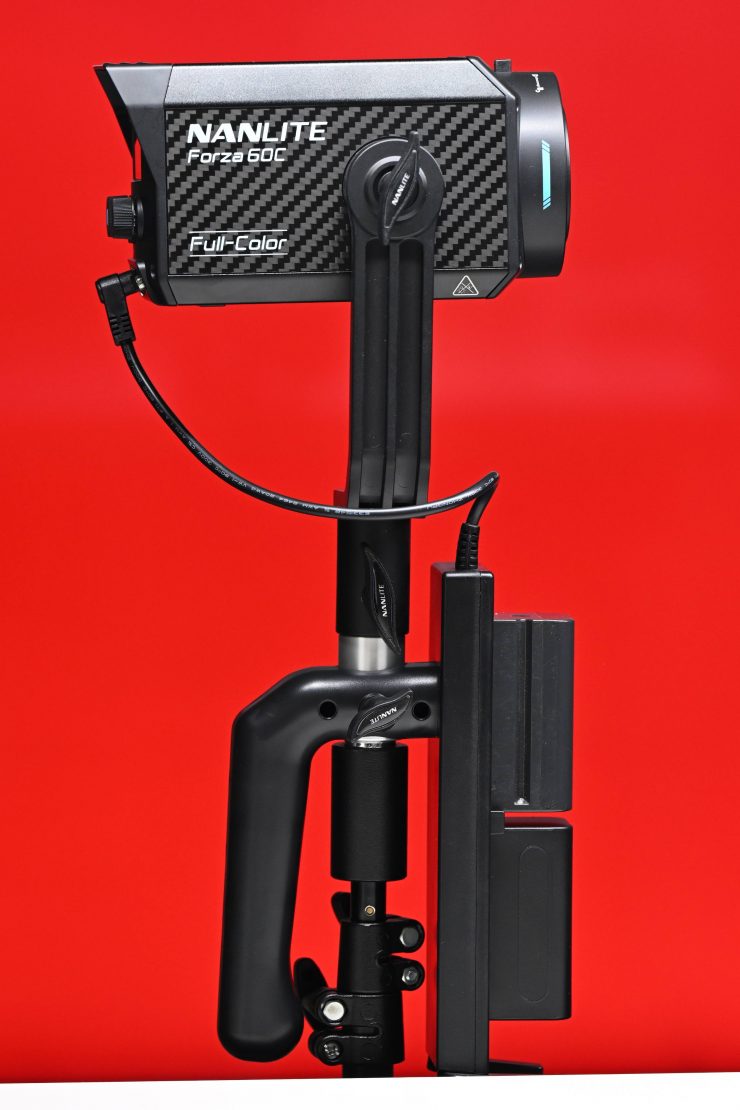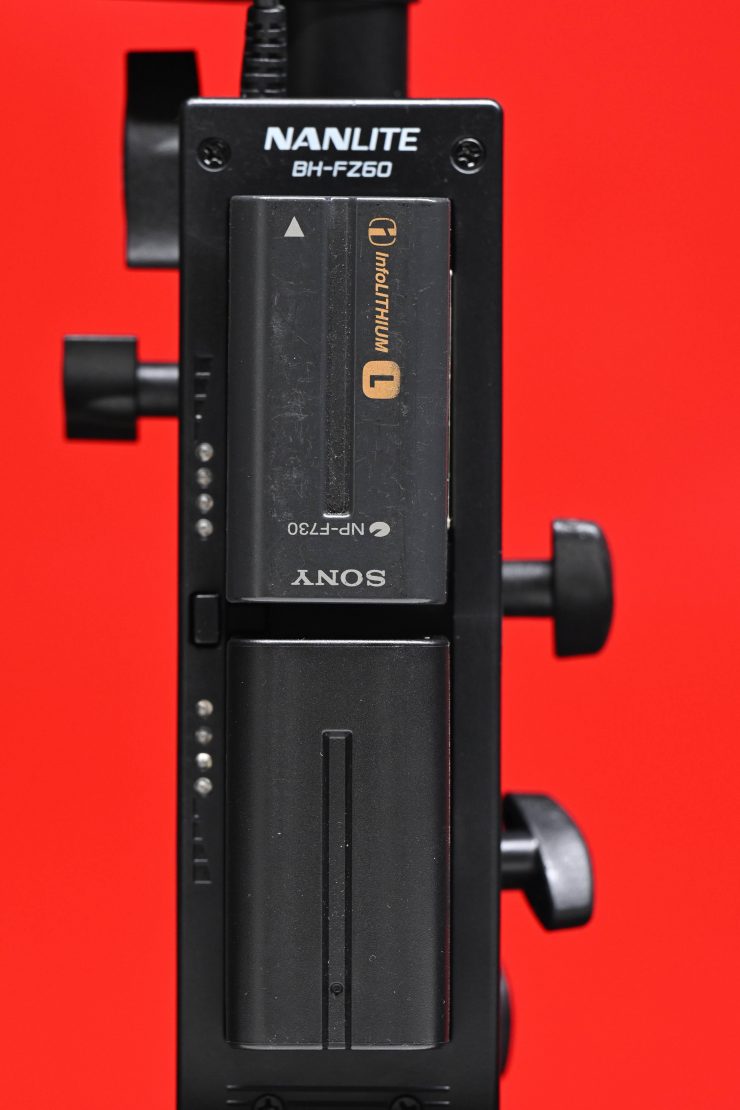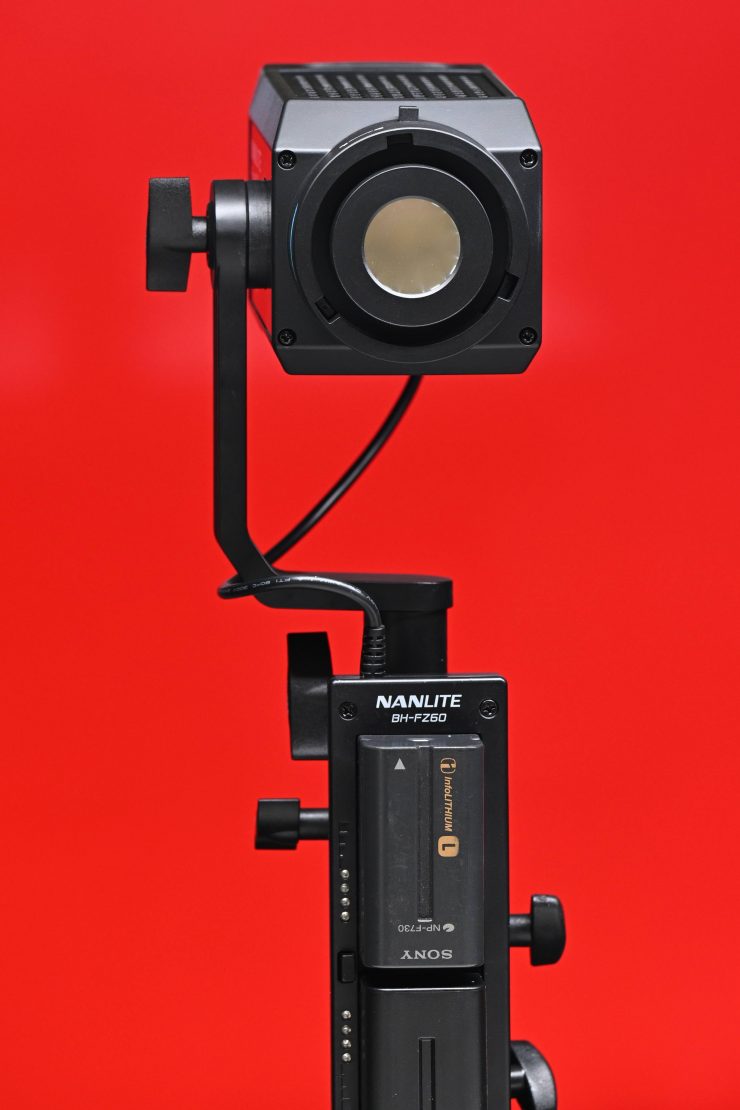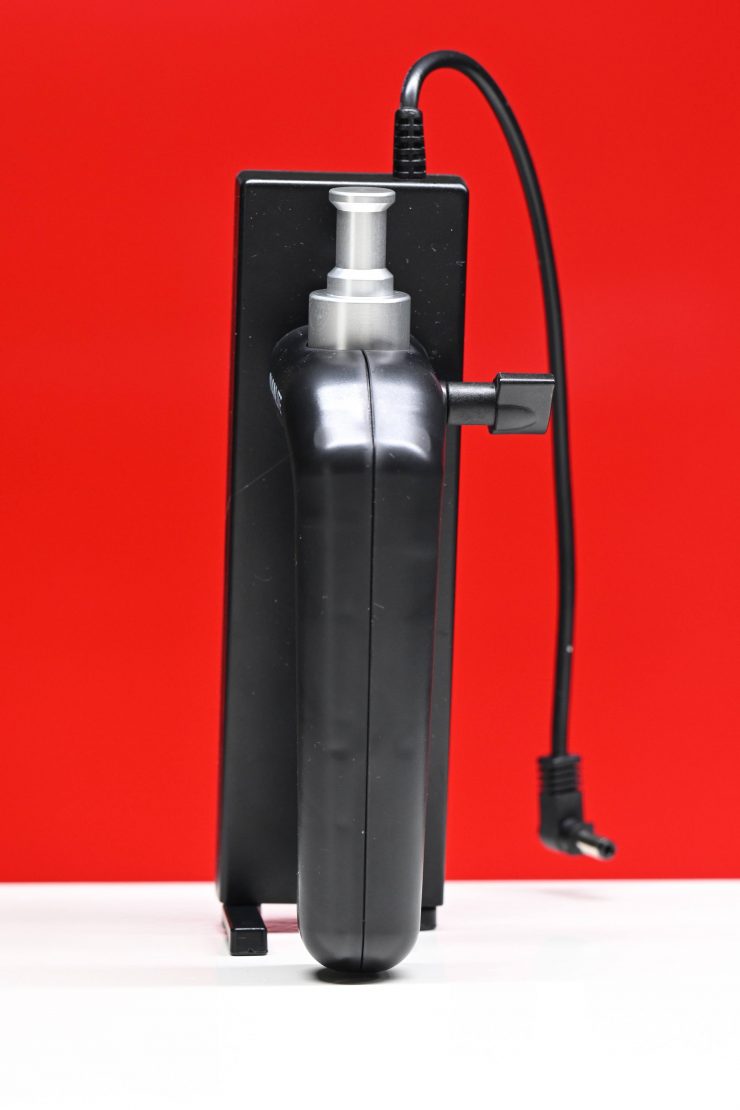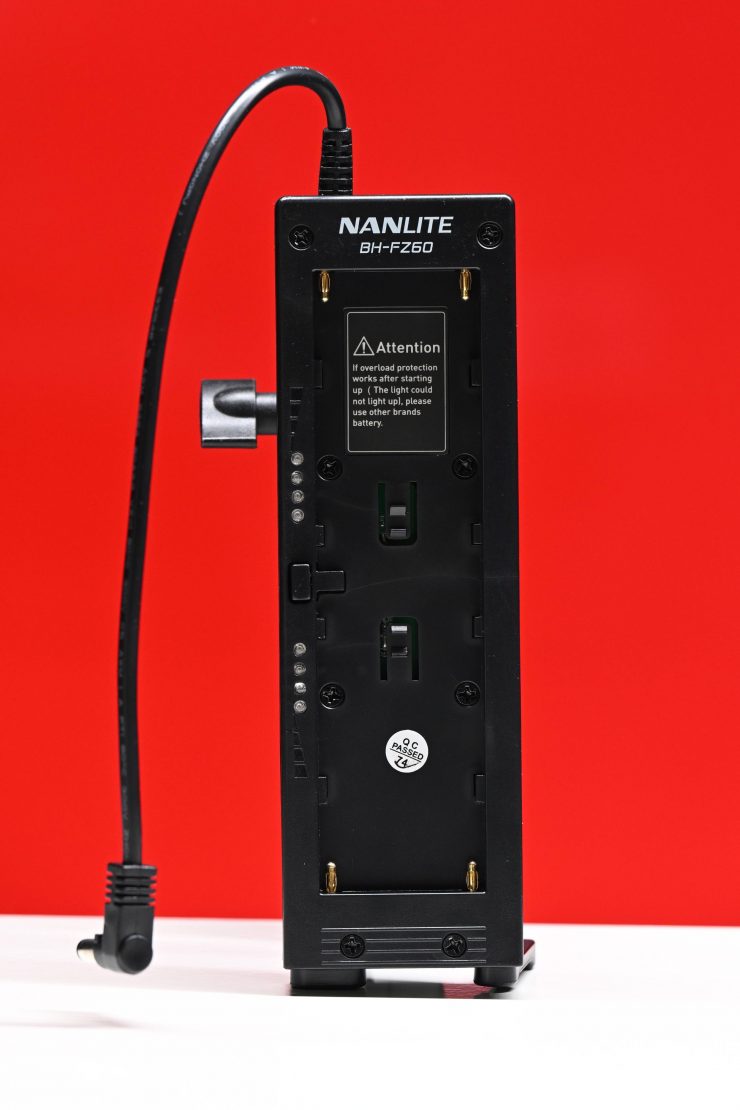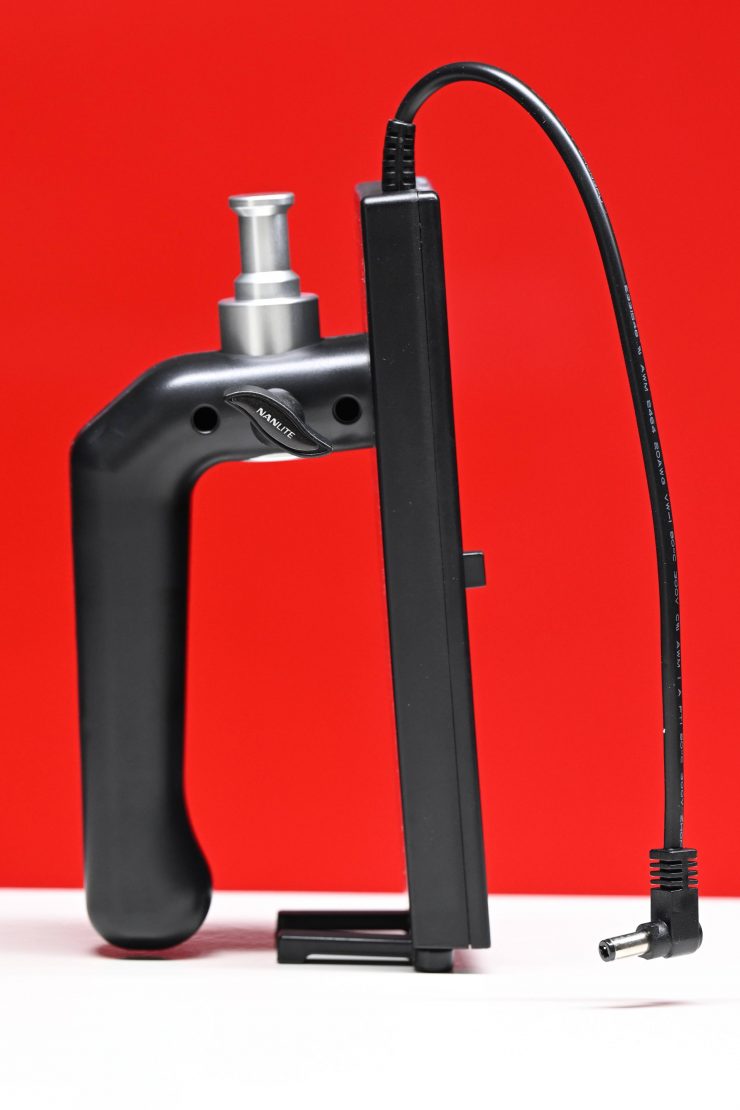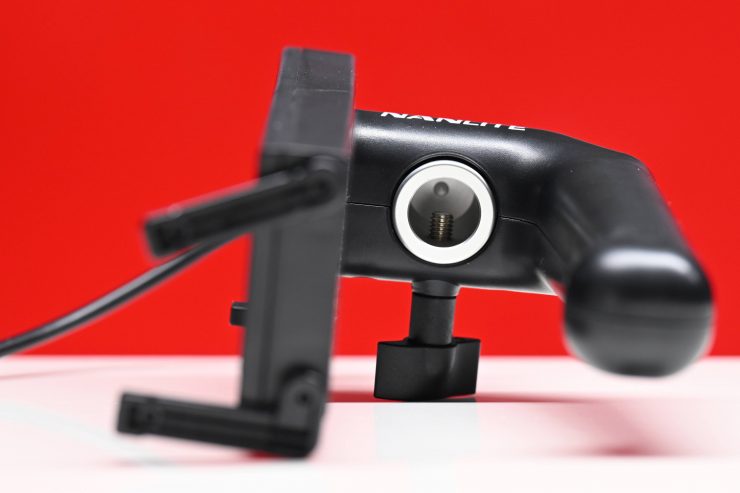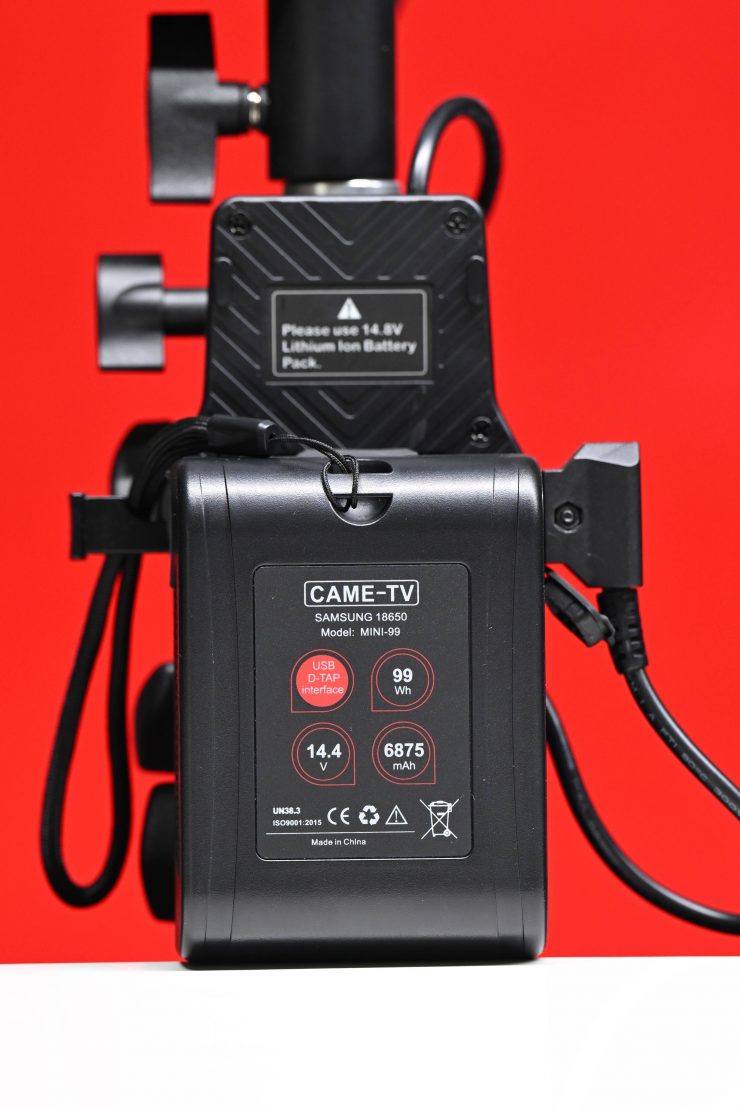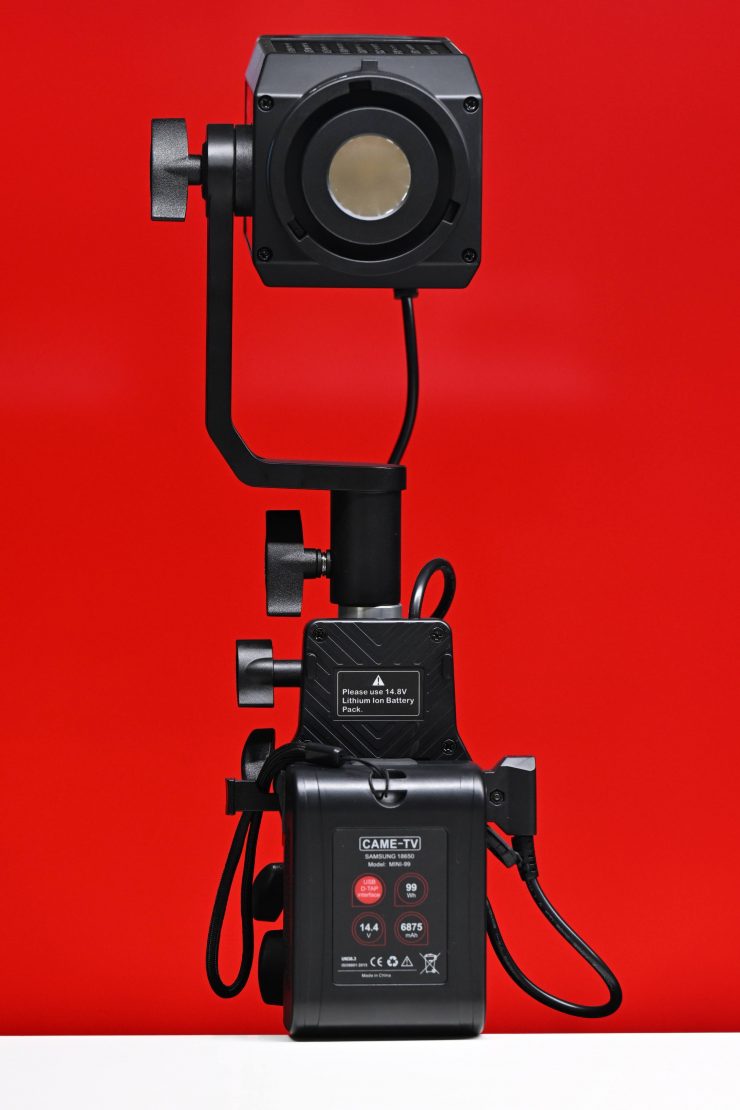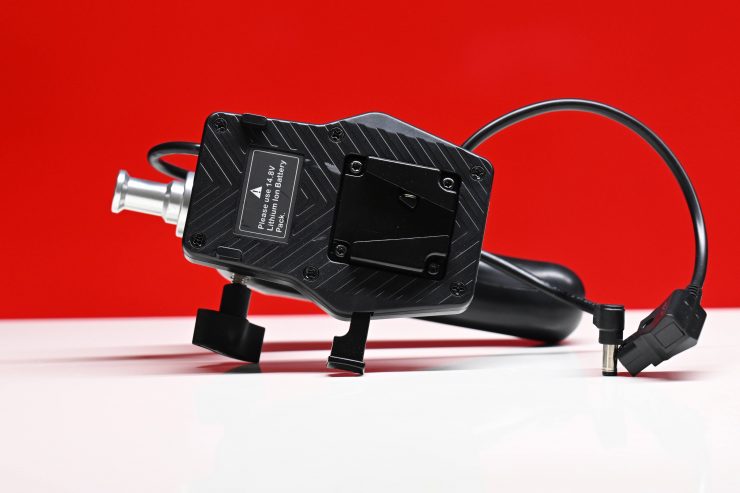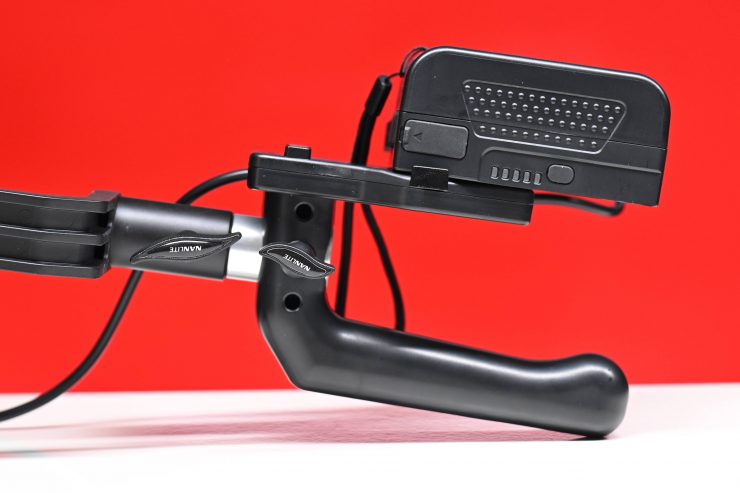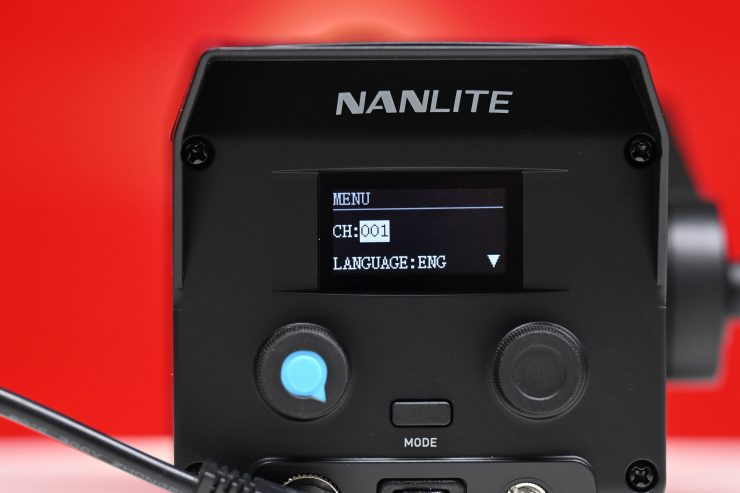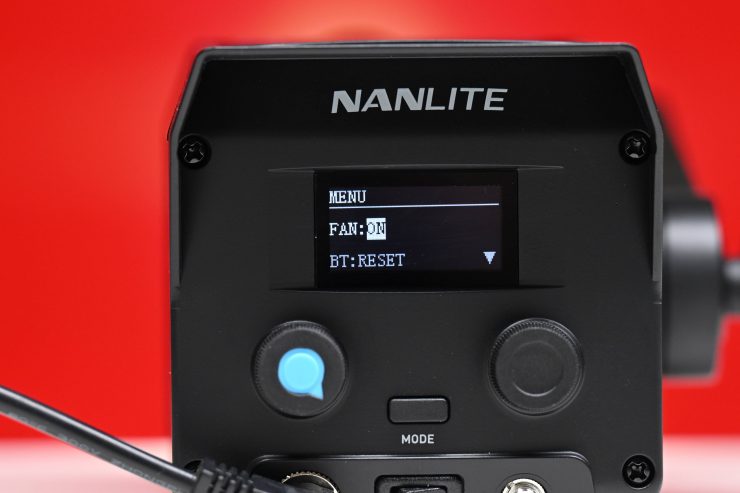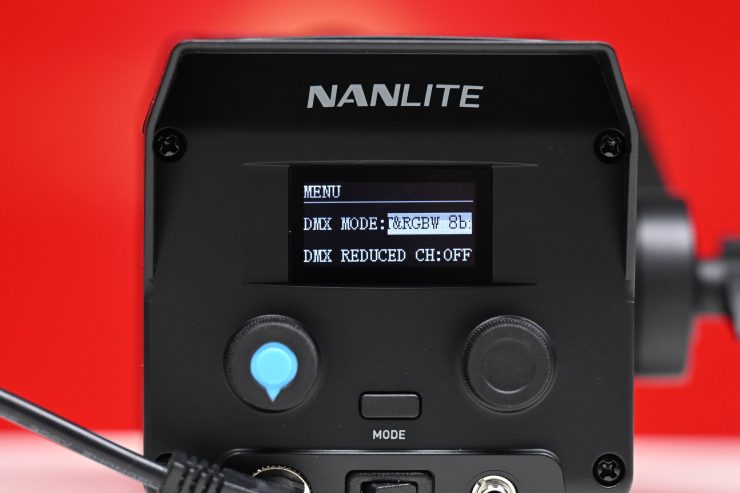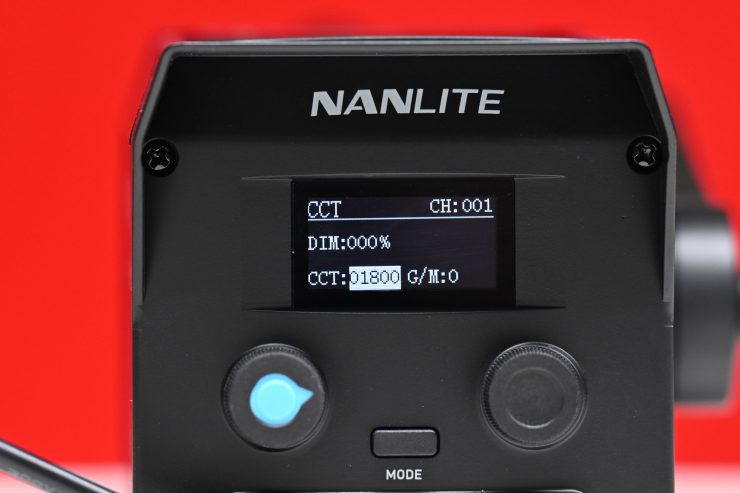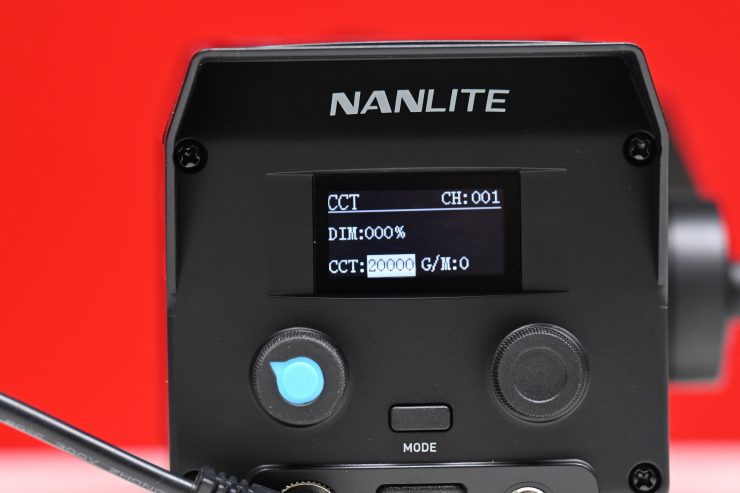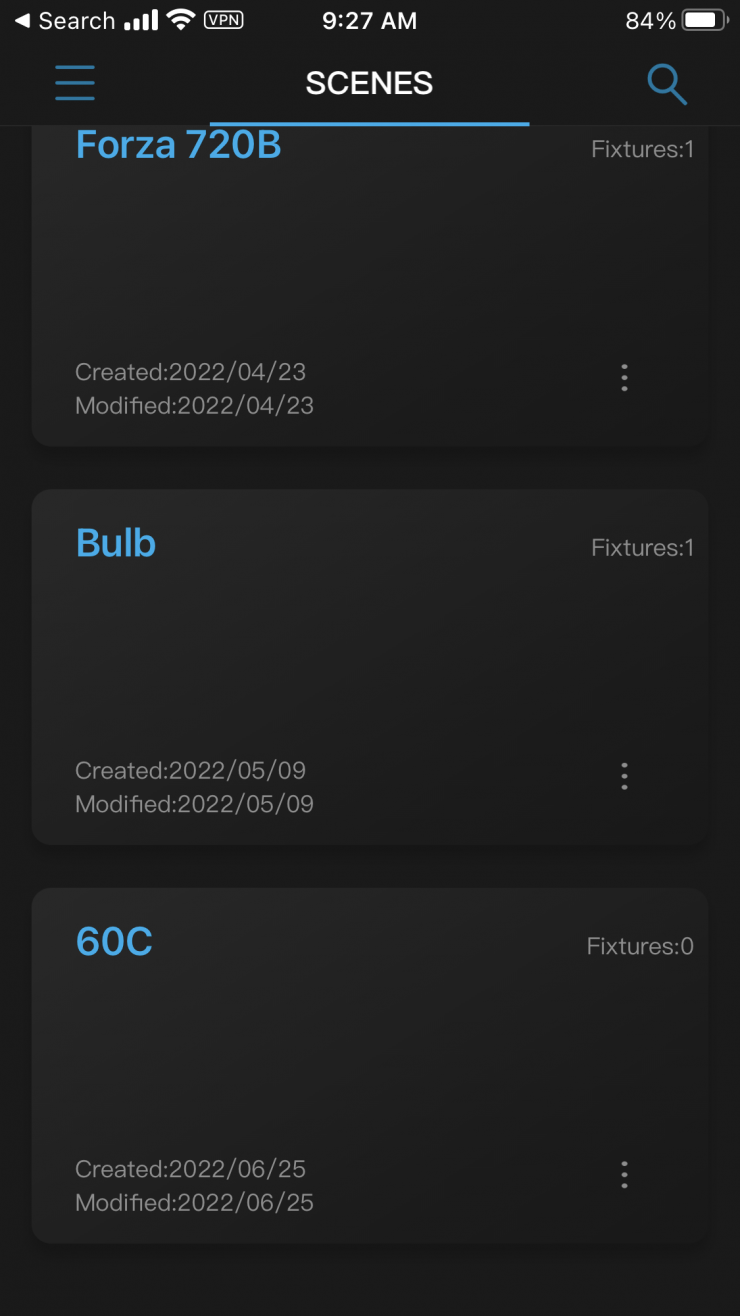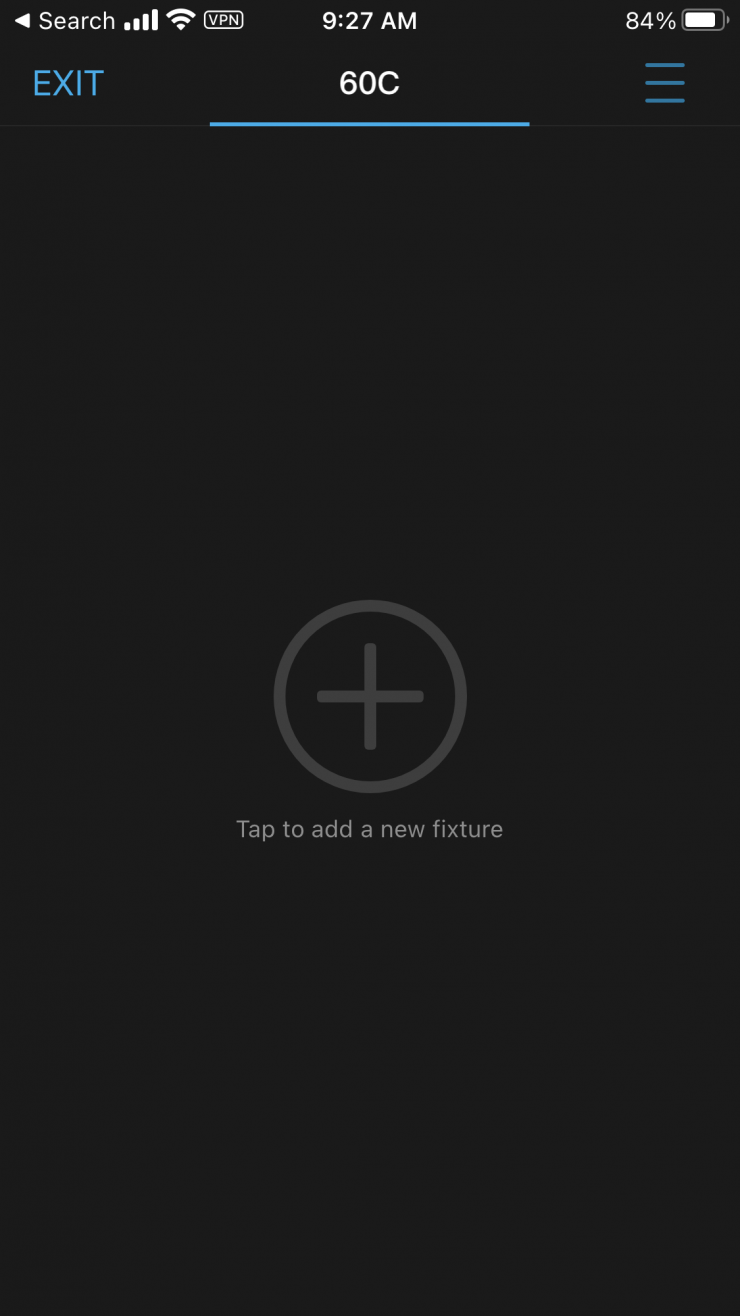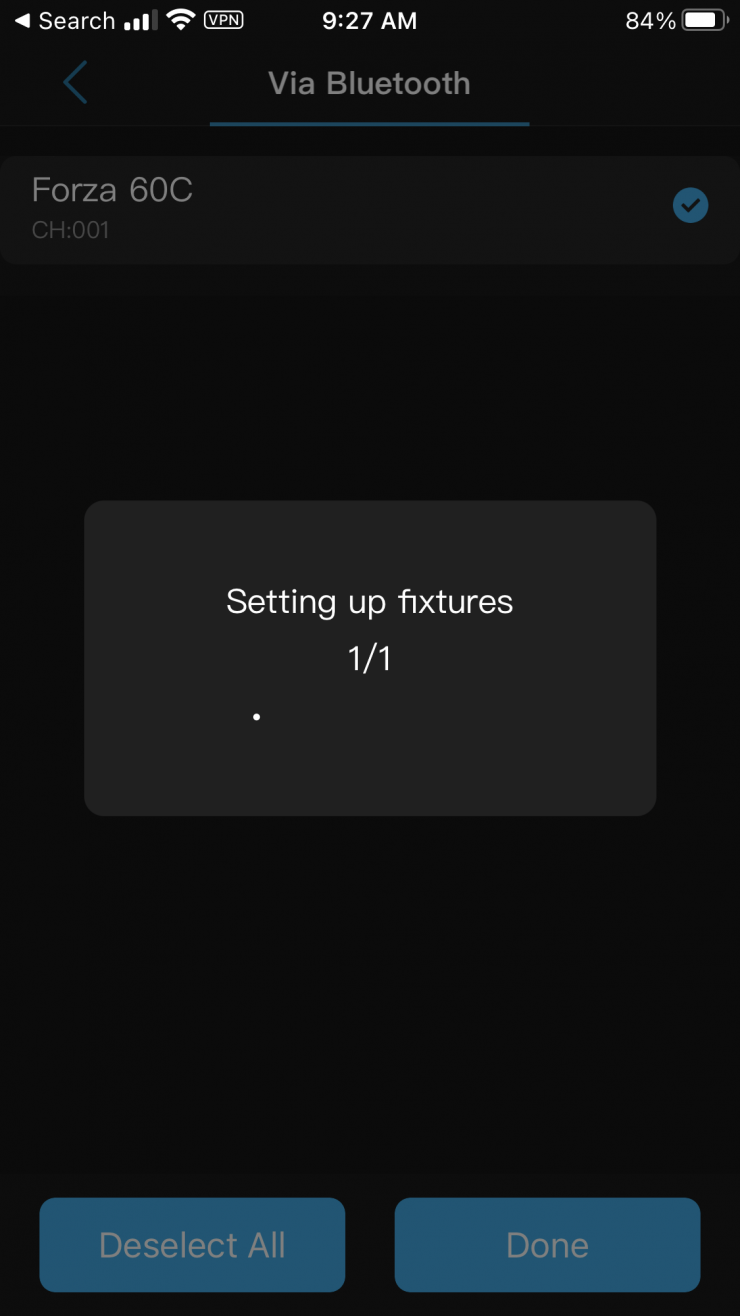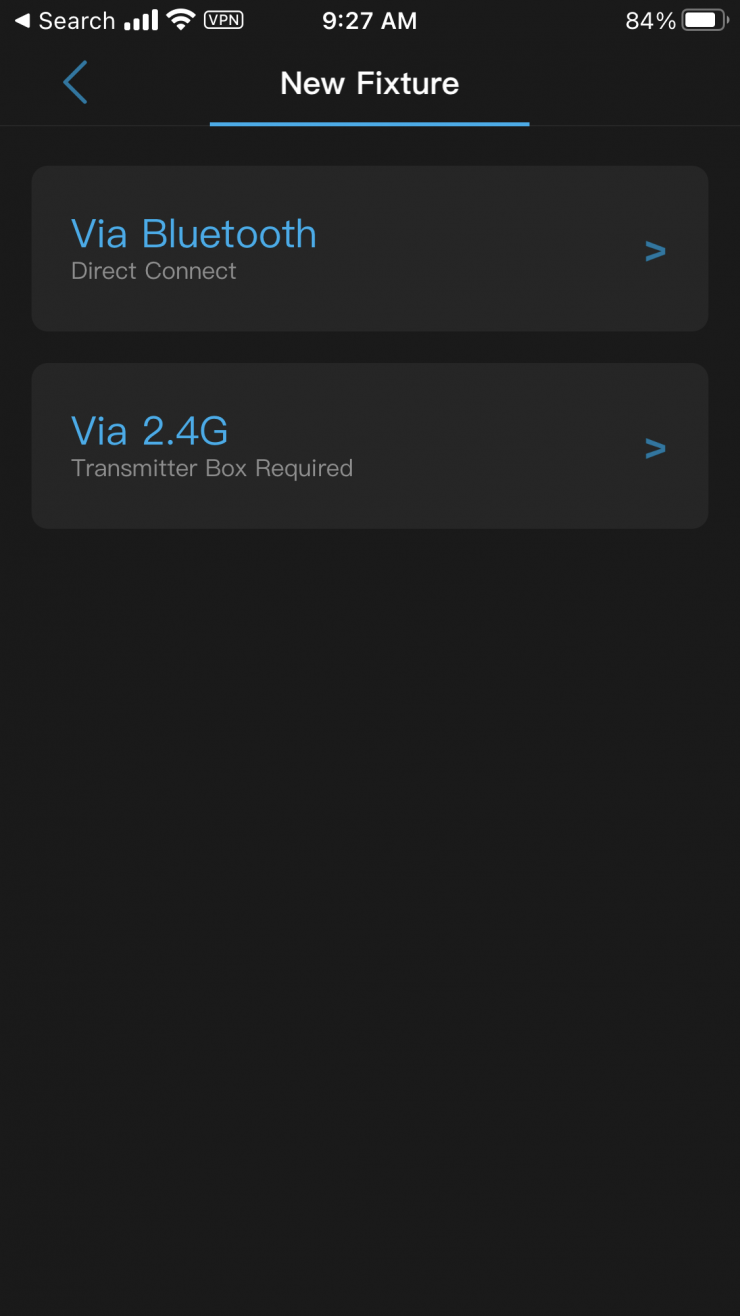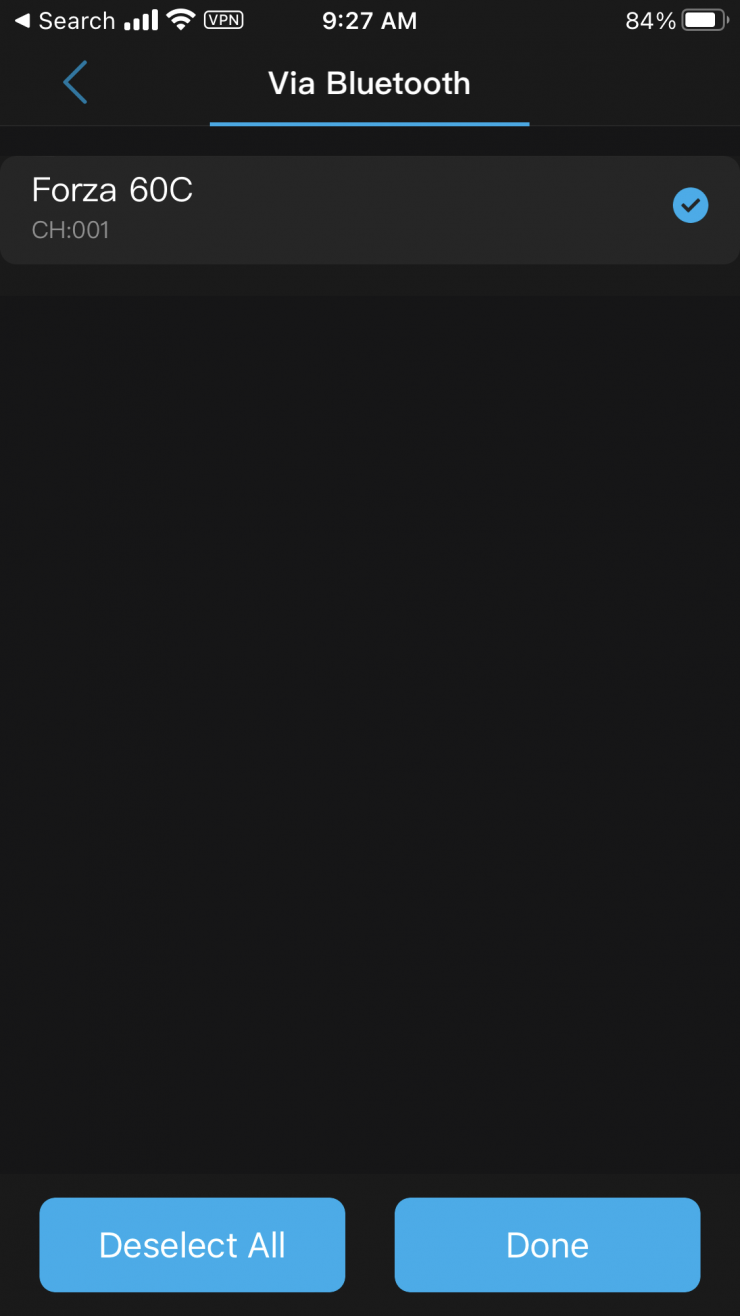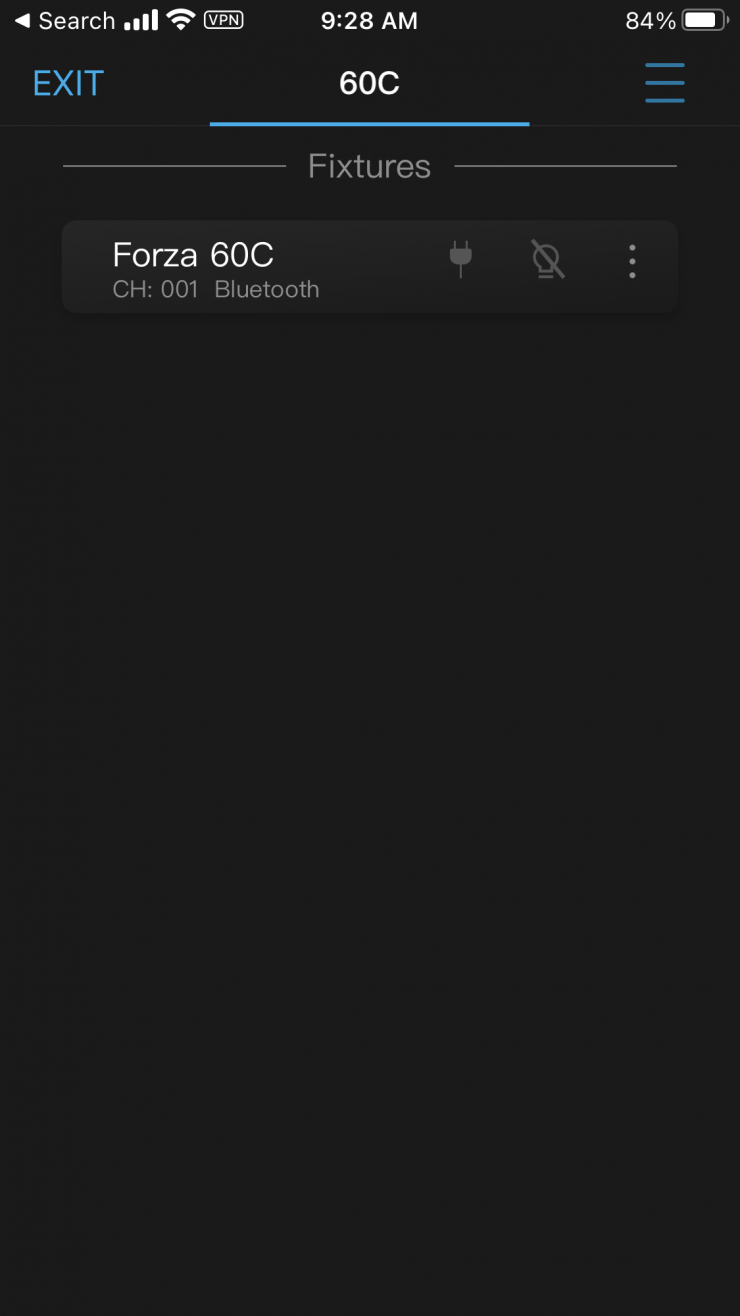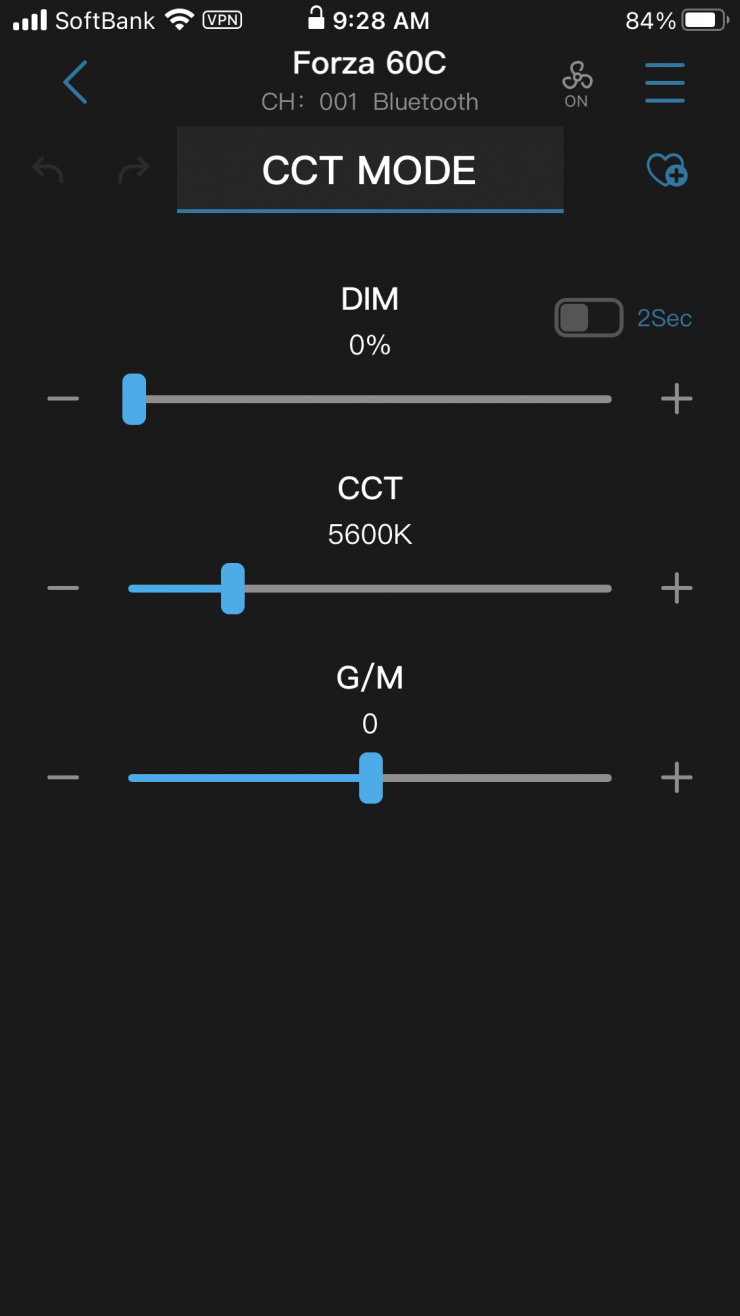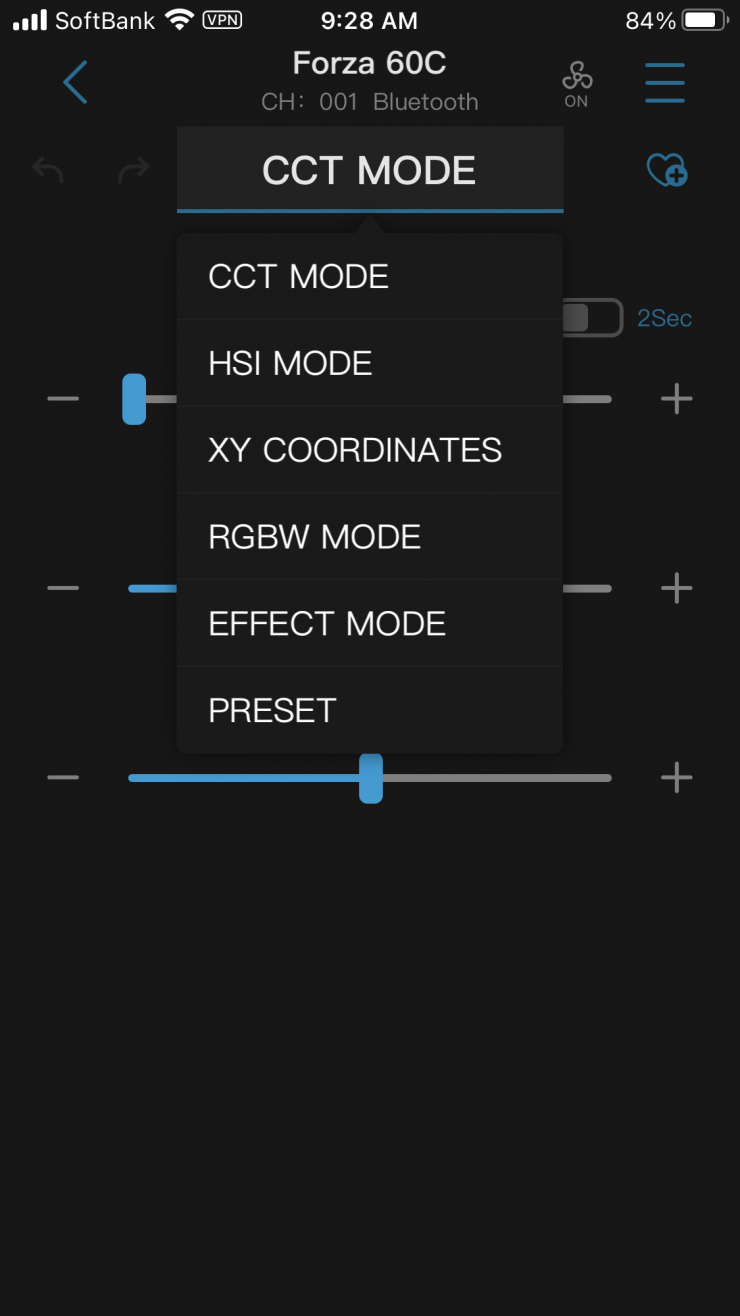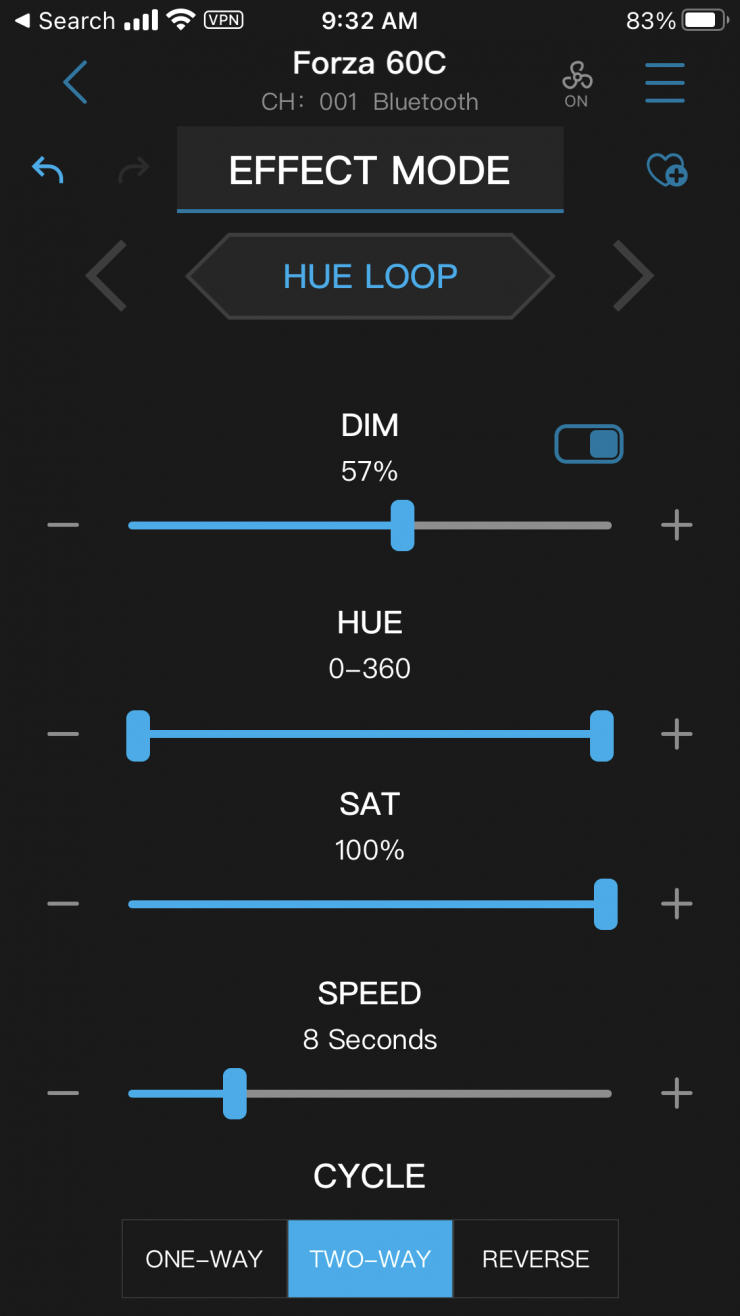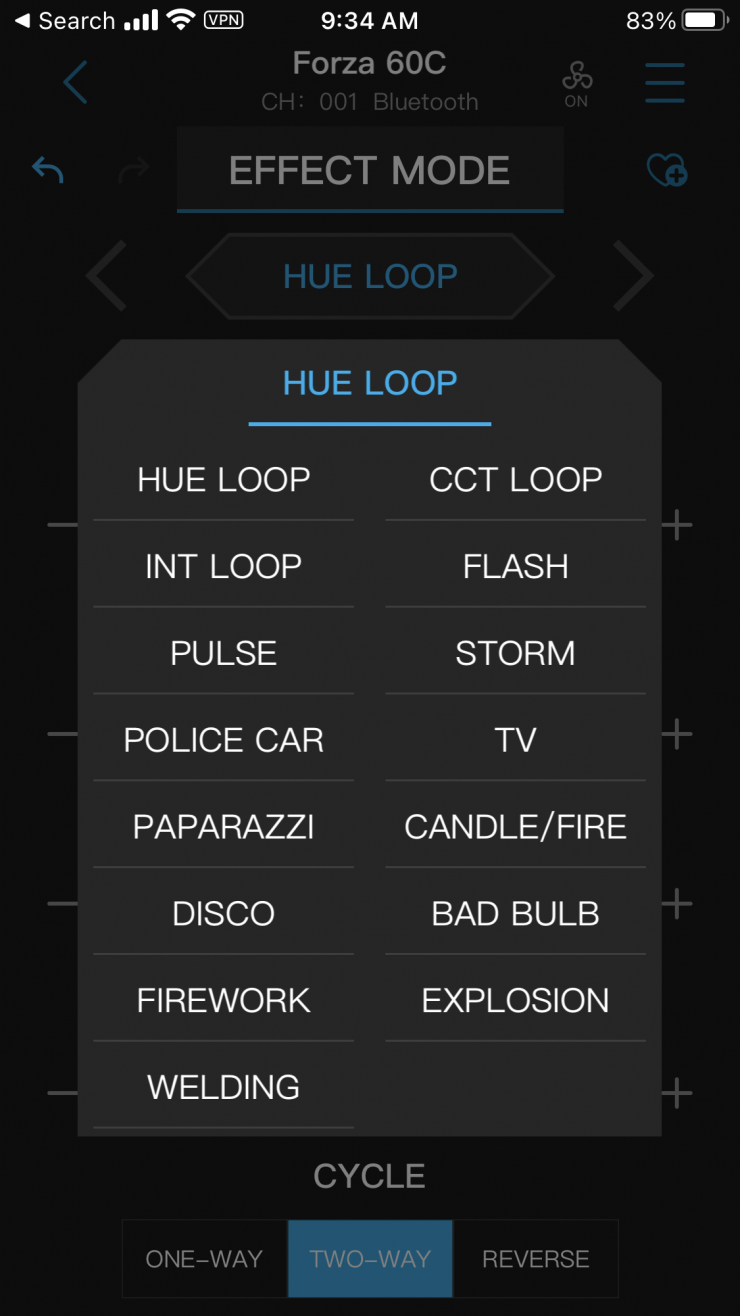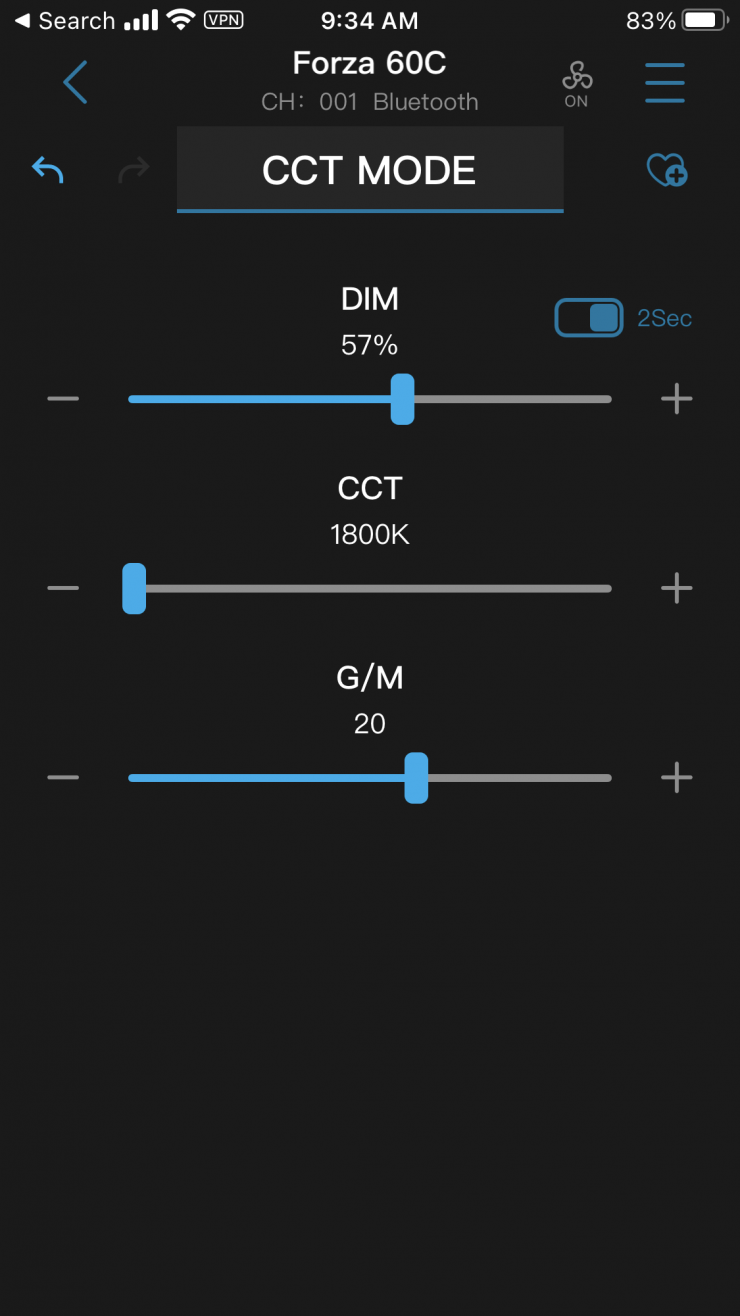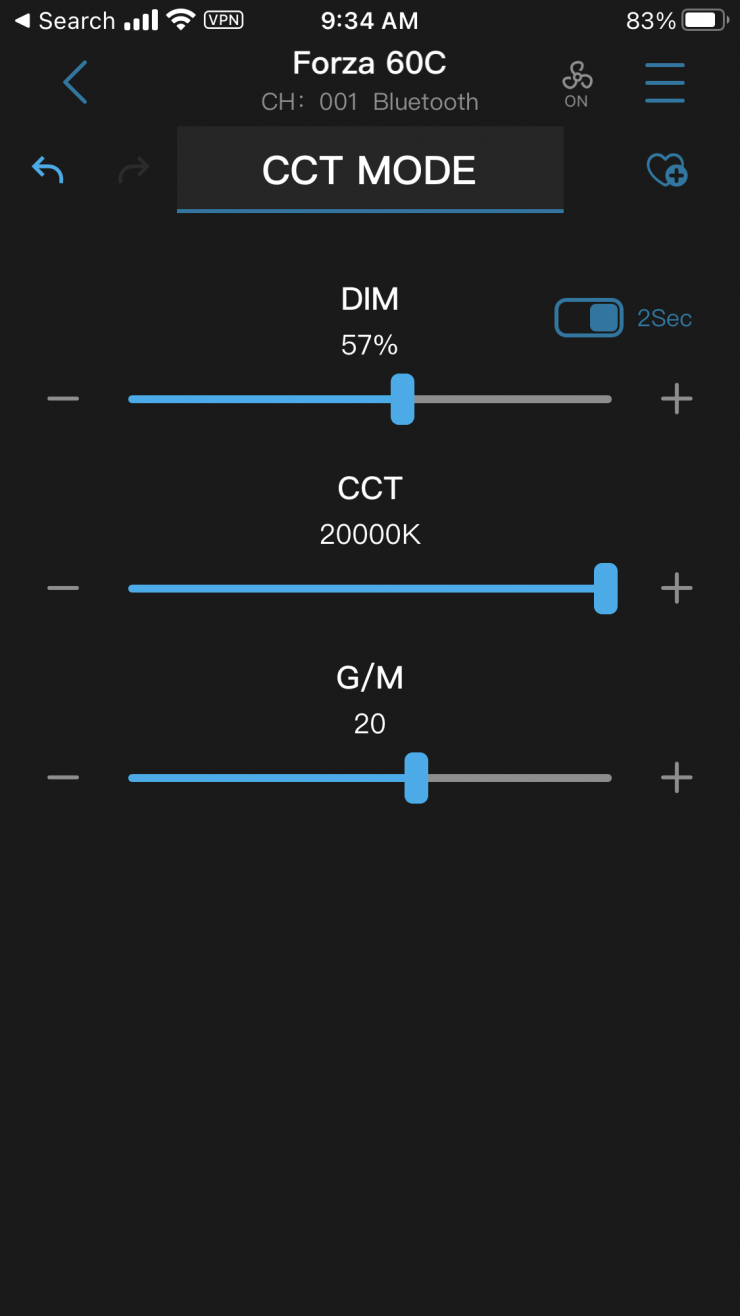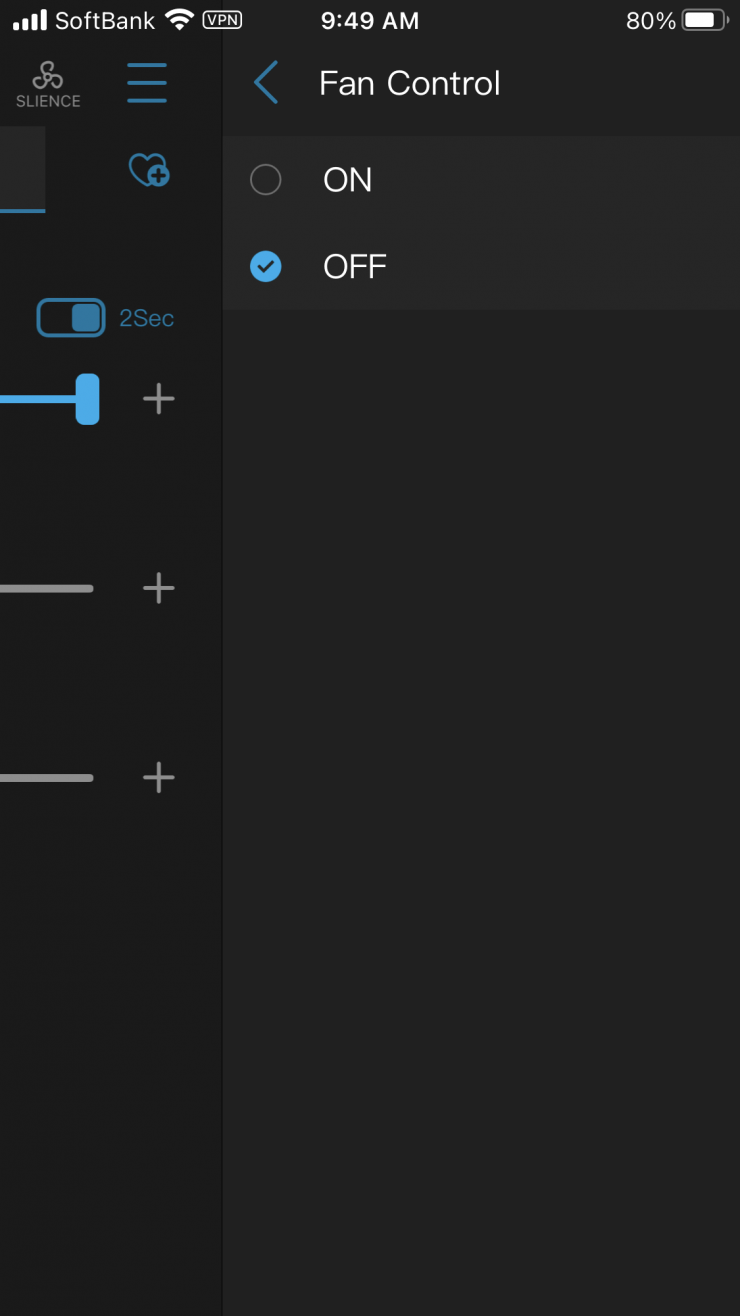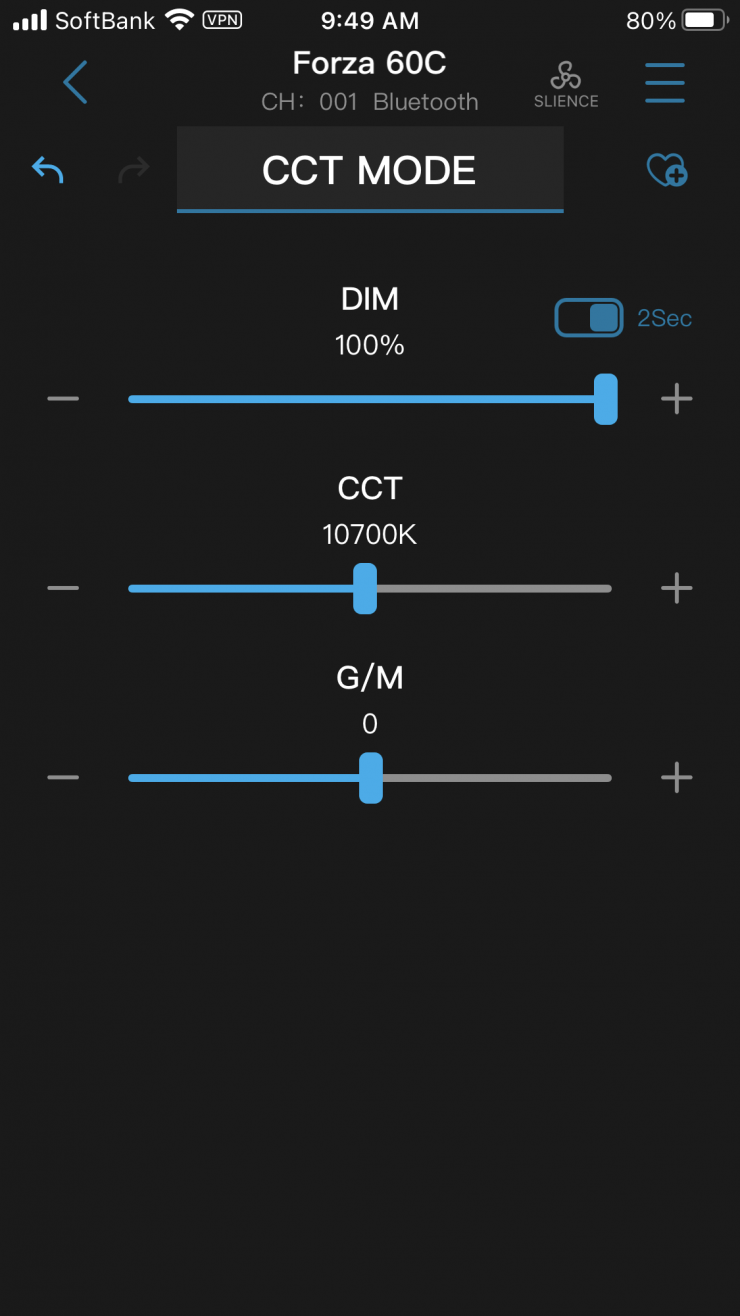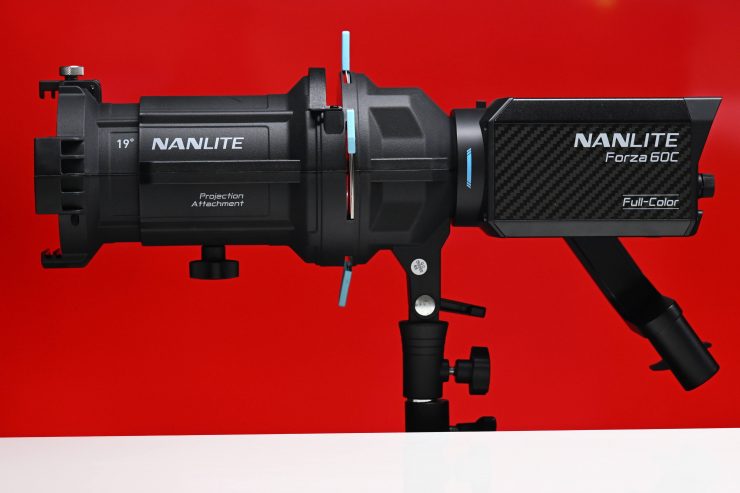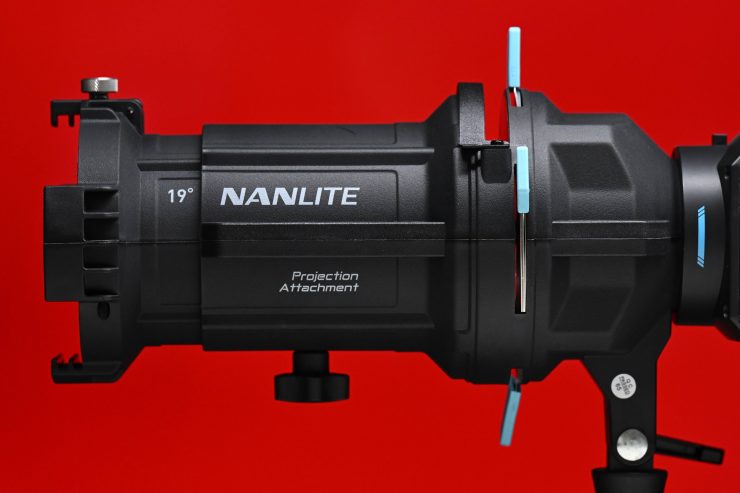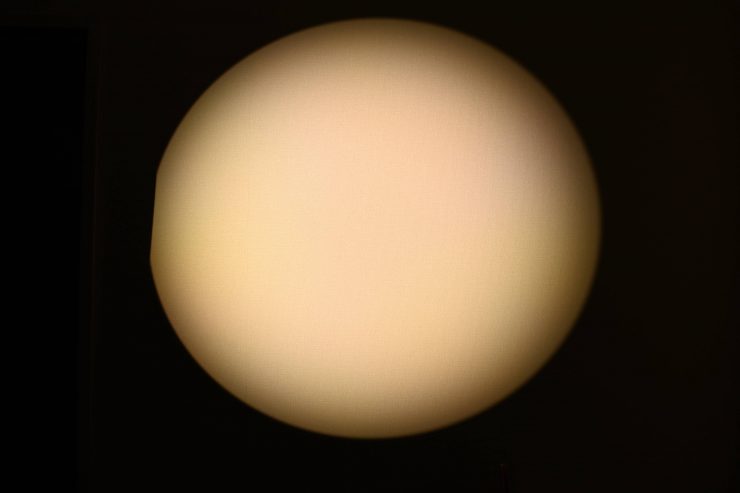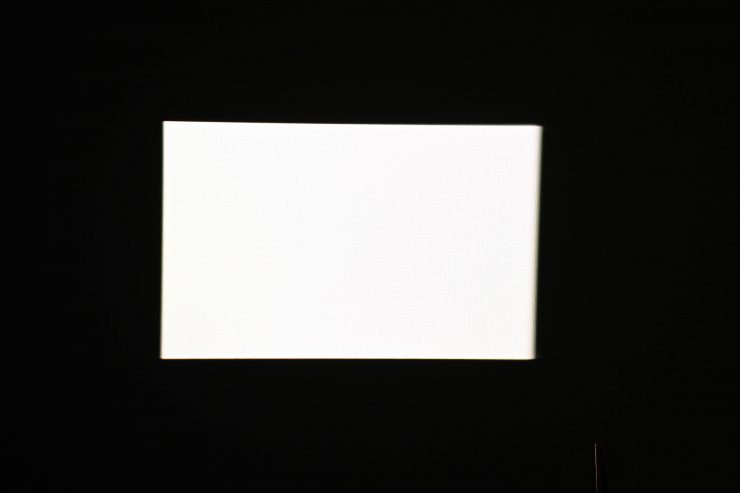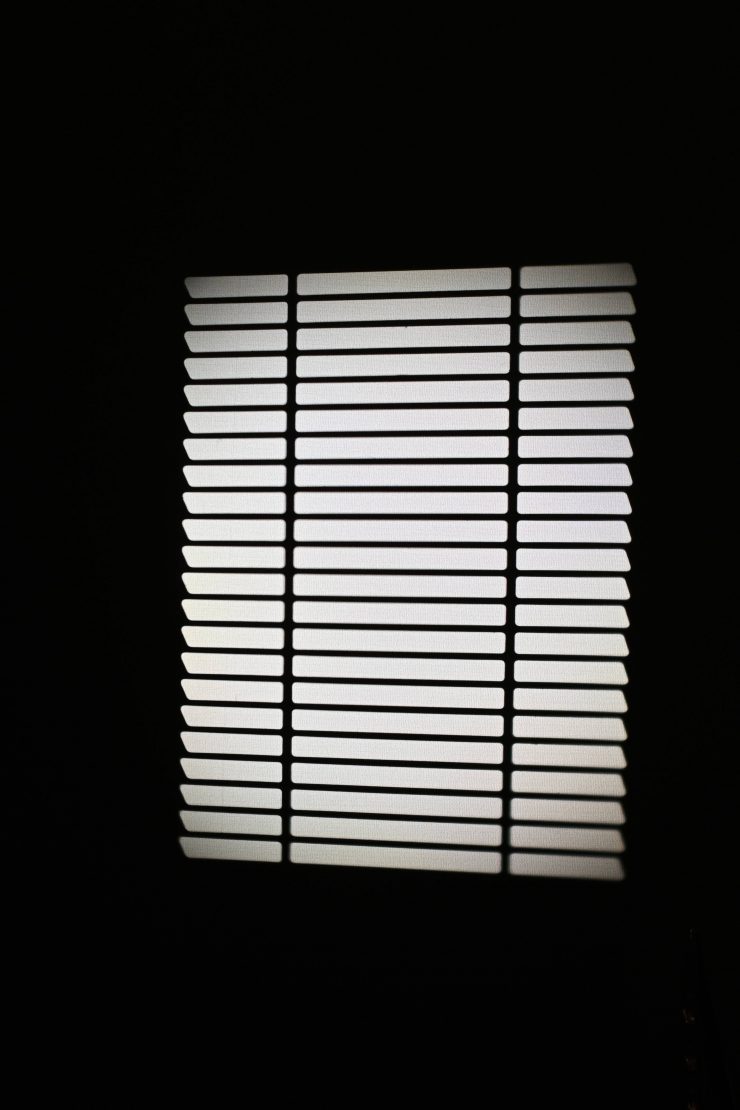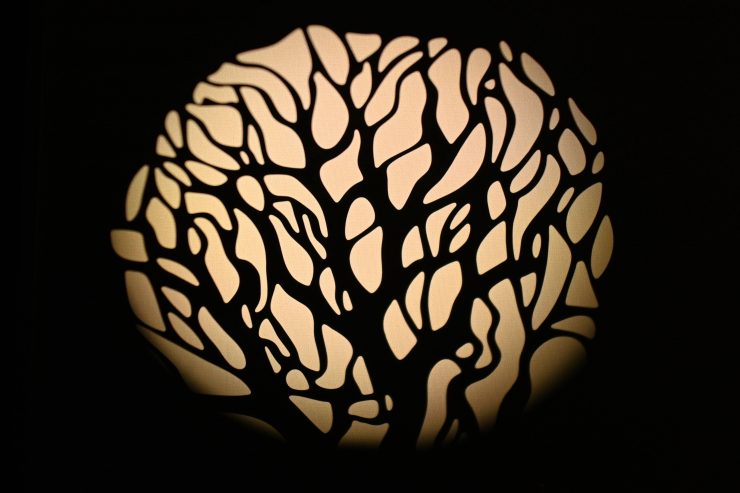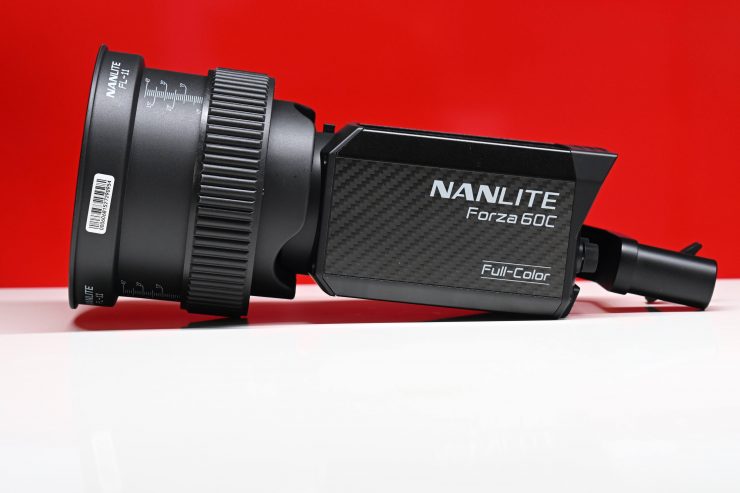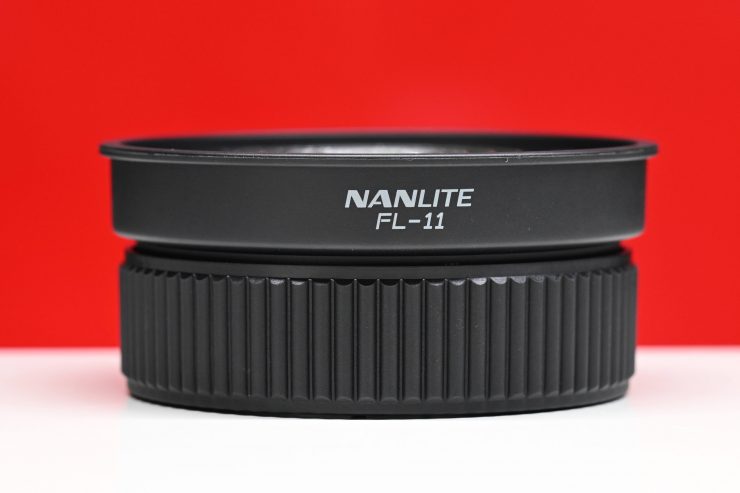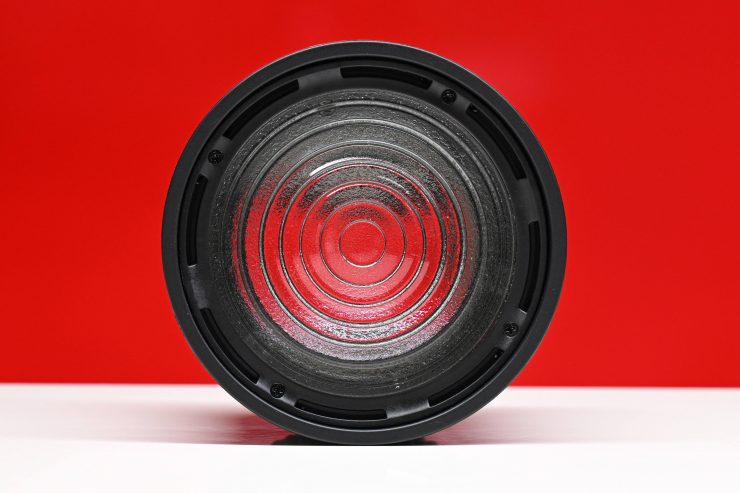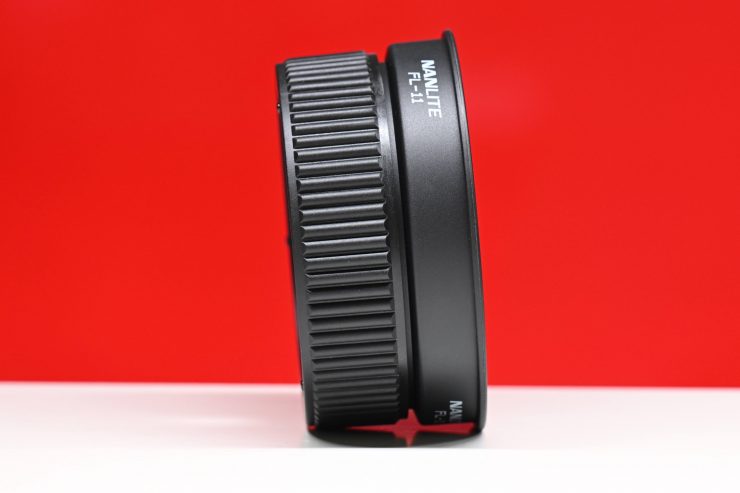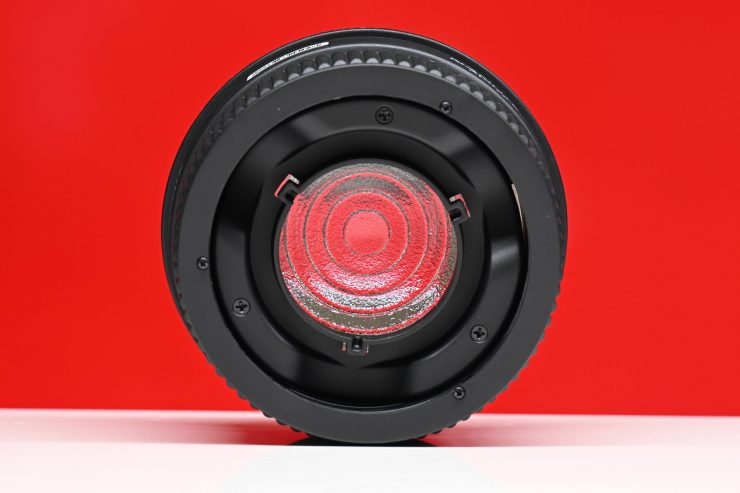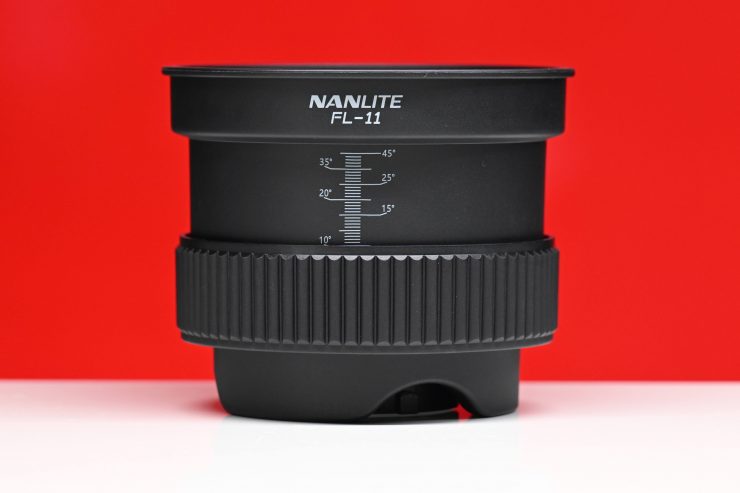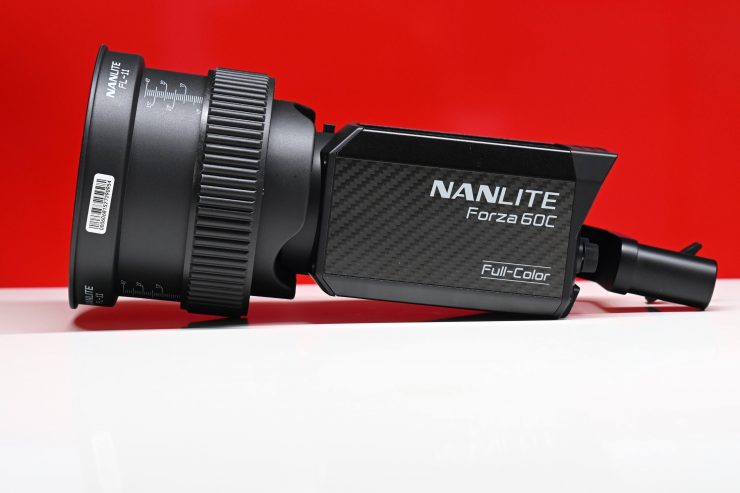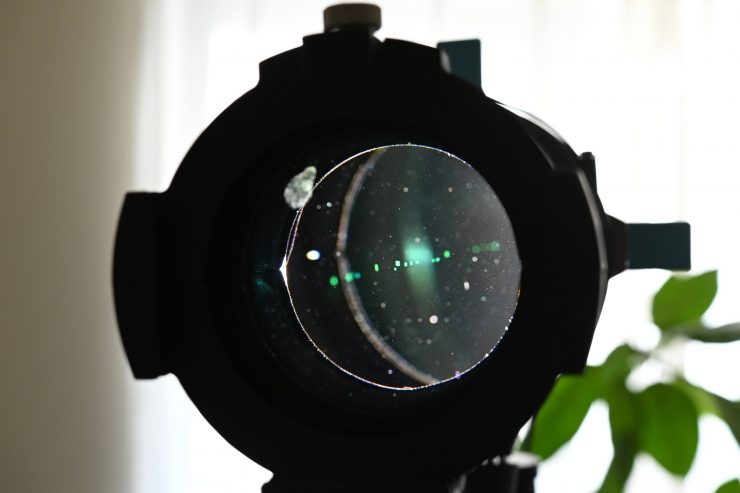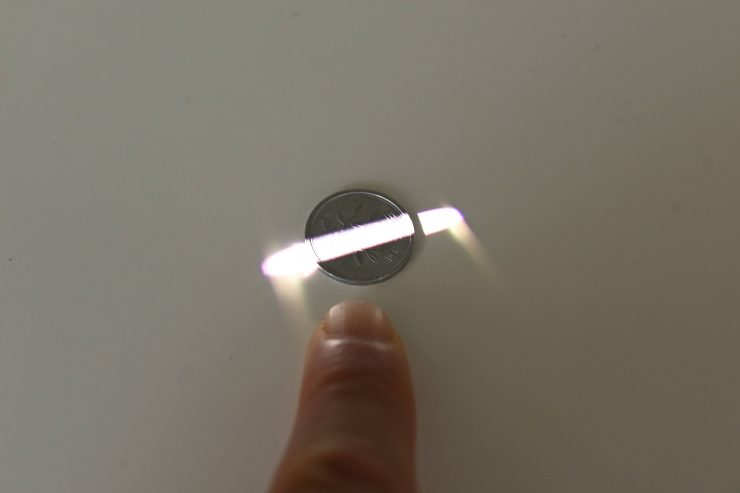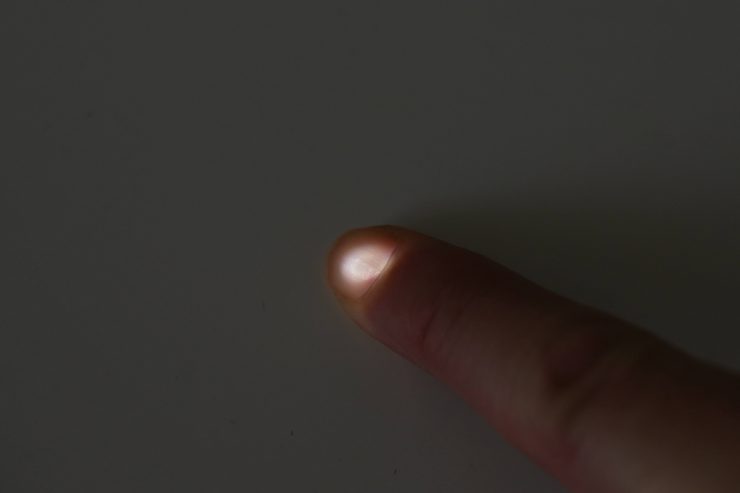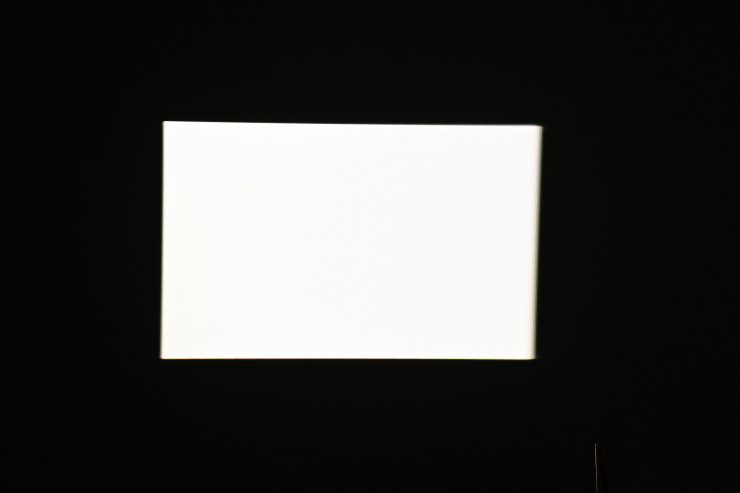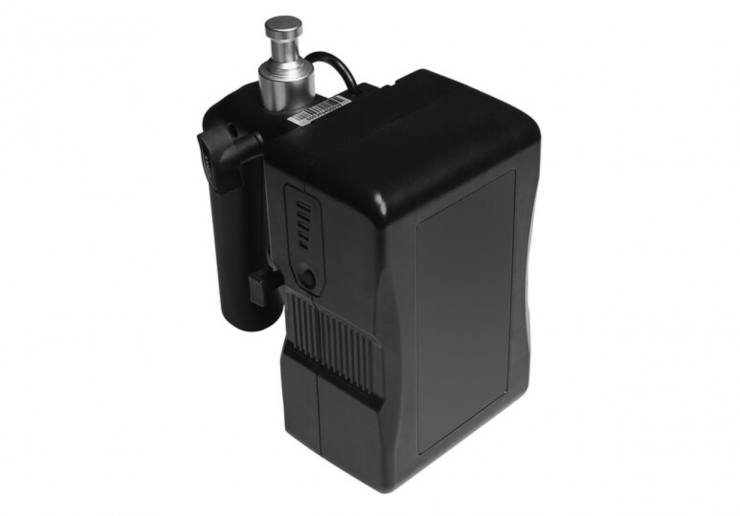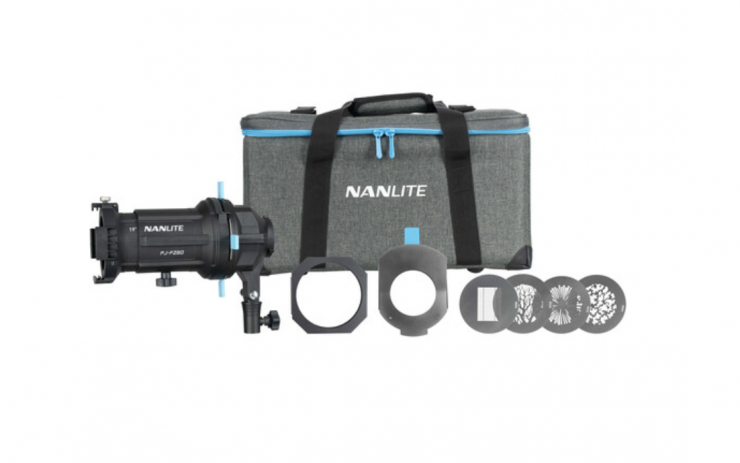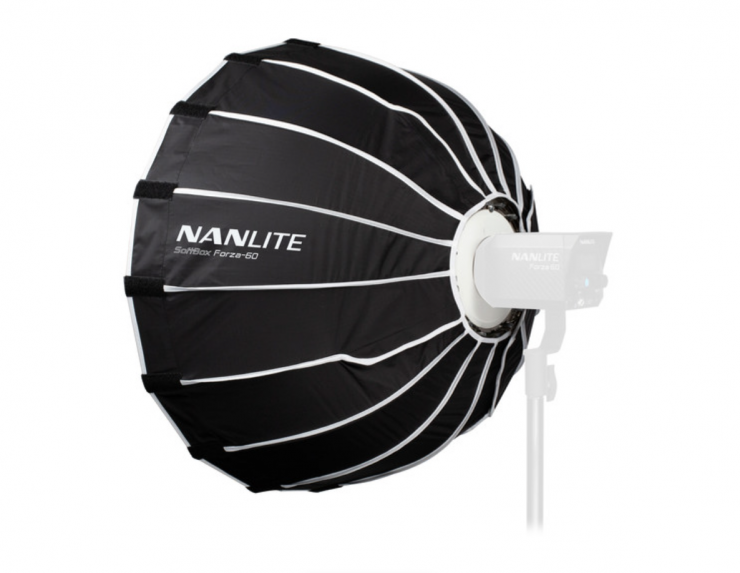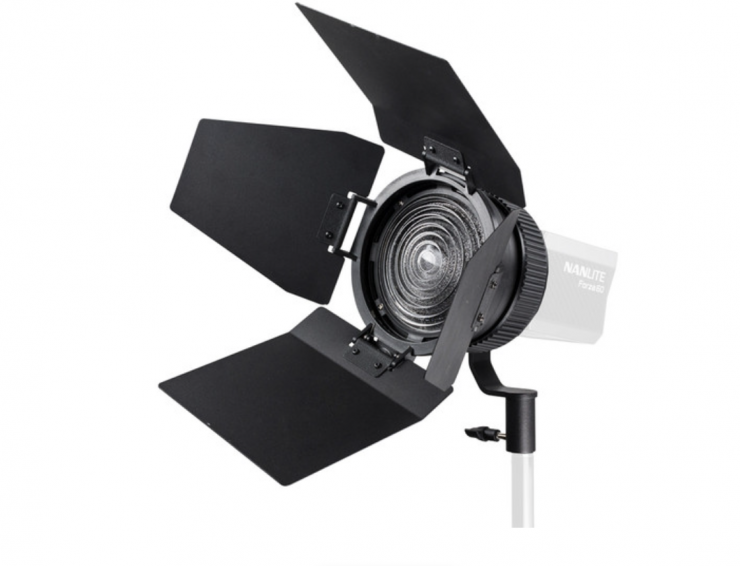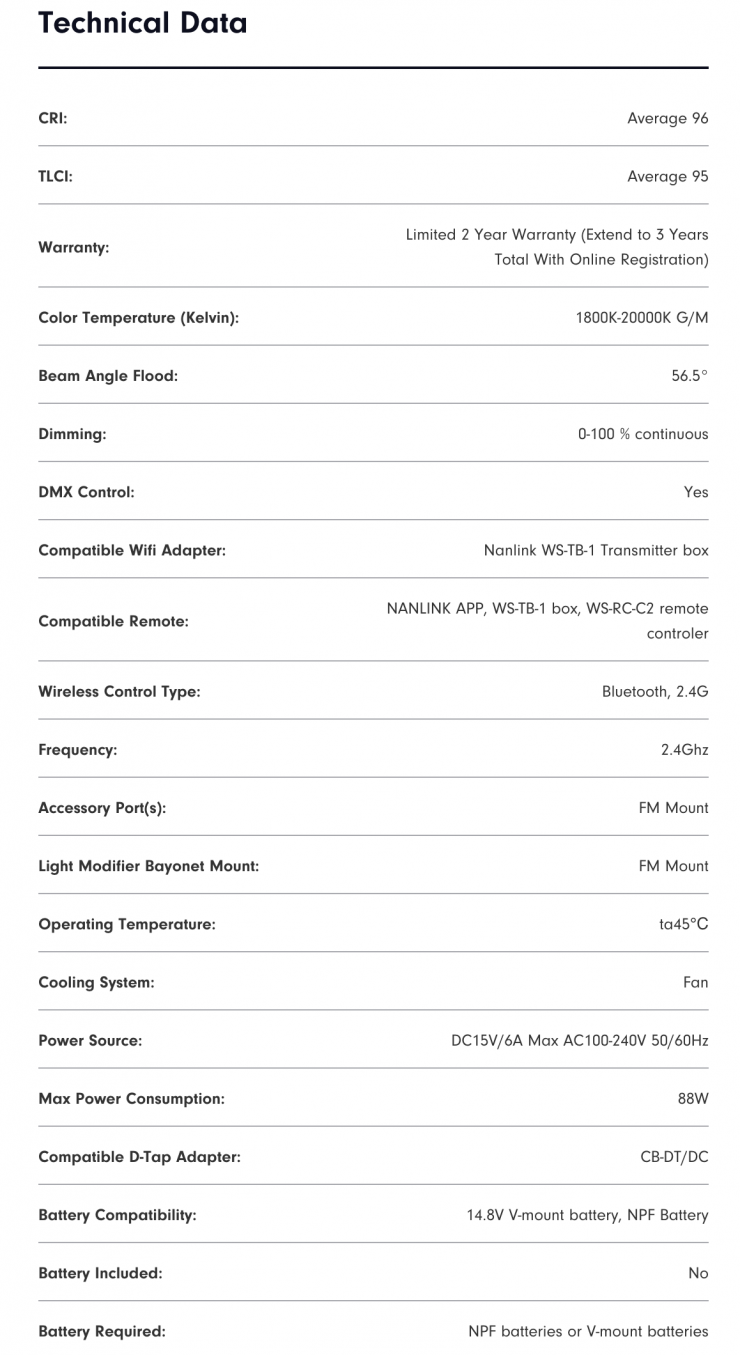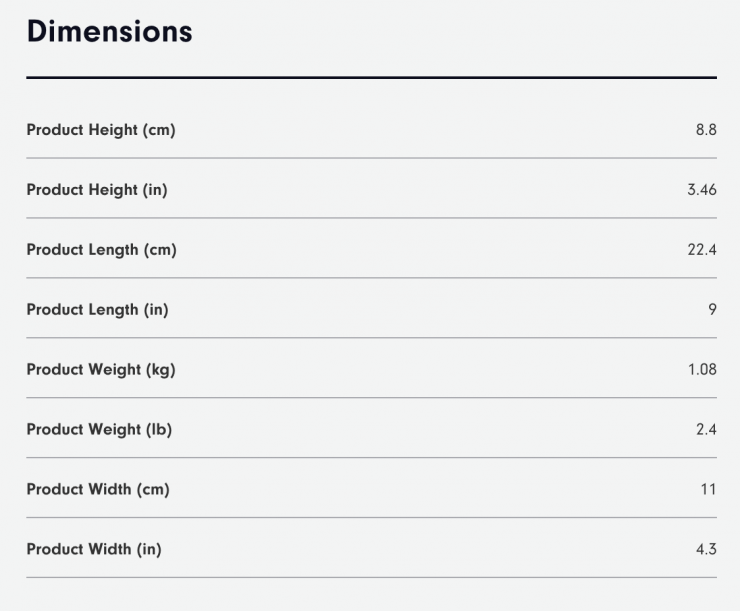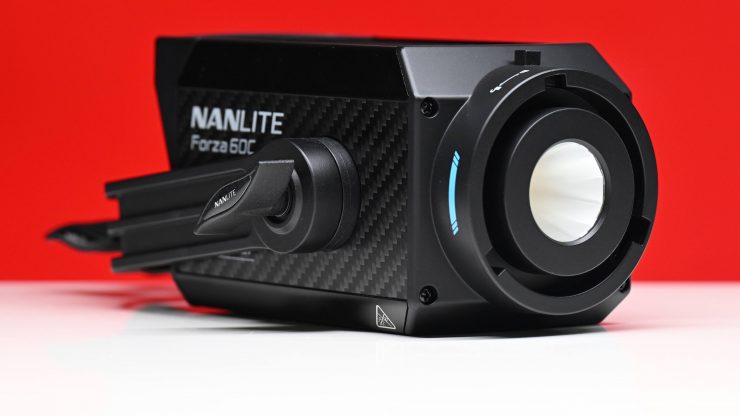
The Nanlite Forza 60C is a full-color LED spotlight with an RGBLAC six-color system that is compact, lightweight, and can be run off batteries.
One of the biggest draw cards of the 60C is that it can provide consistent output across its wide Kelvin color temperature range and it has the ability to output rich, saturated colors.
Versatile COB lights in this form factor have become increasingly popular due to their swiss army knife style abilities, which enable them to be used for a variety of lighting scenarios. This is why we have seen so many of them being introduced over the last few years.
The Nanlite Forza 60C looks to be an interesting light given its feature set and capabilities. So without further ado, let’s get on with the review.
Forza 60C Key features
- RGBLAC six-color system adding Lime/Amber/Cyan LED beads with RG
- Lightweight lamp head weighs just 1.08KG with claimed illuminance up to (12,810 Lux@1M)
- Calibrated distribution of power for each LED bead without illuminance discrepancy in colors
- Ultra-wide CCT range of 1,800K-20,000K and ±100 G/M adjustment.
- Claimed color rendition, CRI/TLCI score of average 96/95 and TM-30 Rf average 94 / Rg average 100
- FM mount with option to integrate into the Bowens mount ecosystem
- Professional options of HSI / RGBW / XY modes for color calibration
- AC & DC power options with a battery grip for on-the-go shooting
- An intelligent fan that automatically adjusts according to ambient temperature
- Multiple control methods, including onboard, 2.4G, NANLINK APP, and DMX/RDM controls
- Firmware upgradeable via the USB-A port on the fixture body
Concept
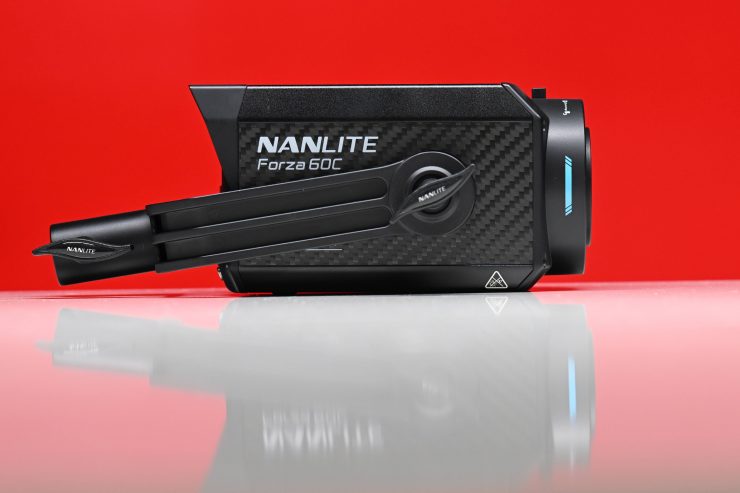
The concept behind all of these LED spot lights, whether they are daylight, bi-color, or full color, is to make a very flexible, fully-featured lighting source that won’t empty someone’s wallet. The only problem with this concept, is that so many lighting companies are doing the exact same thing, so how do you make your product stand out? What Nanlite has done which is very interesting is that they have gone down the same route as ARRI and Prolychyt by using RGBLAC/RGBACL LEDs instead of traditional RGBWW that are found in most affordable spot lights like this. I will talk more about RGBLAC further down in the review. The caveat with a full color, as opposed to daylight or bi-color fixture, is that they are generally going to cost you a lot more money. The Nanlite 60C is more than double the cost of the Nanlite 60D.
Nanlite also has a ton of very affordable lighting modifiers such as the F-11 Fresnel and the Projector Mount for Forza 60 and 60B LED Monolights (19°). These affordable options certainly increase the versatility of the Forza 60C.
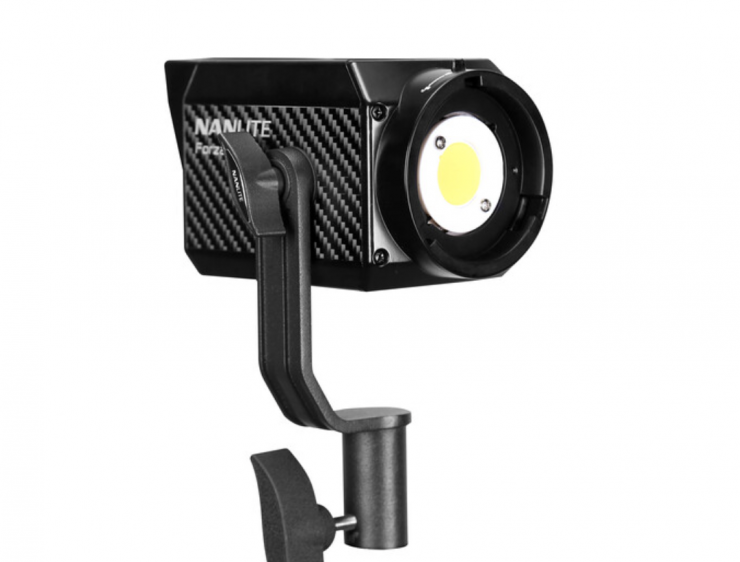
Nanlite Forza 60C 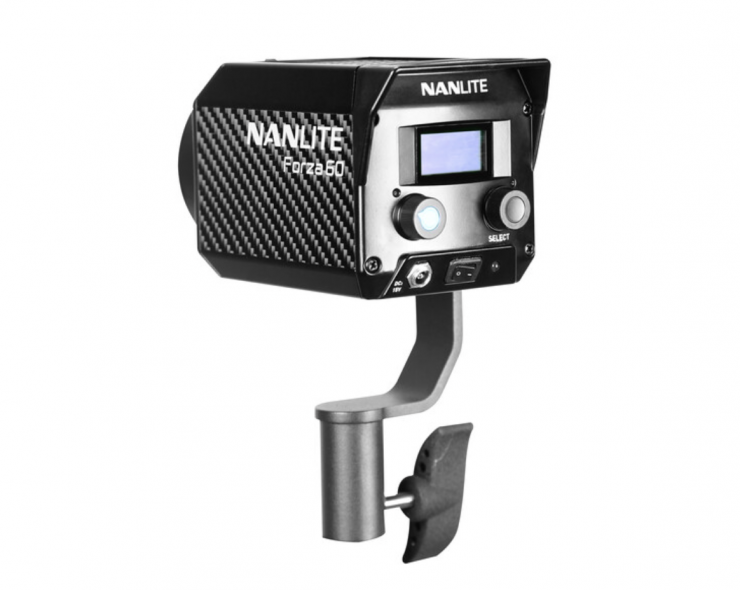
Nanlite Forza 60D 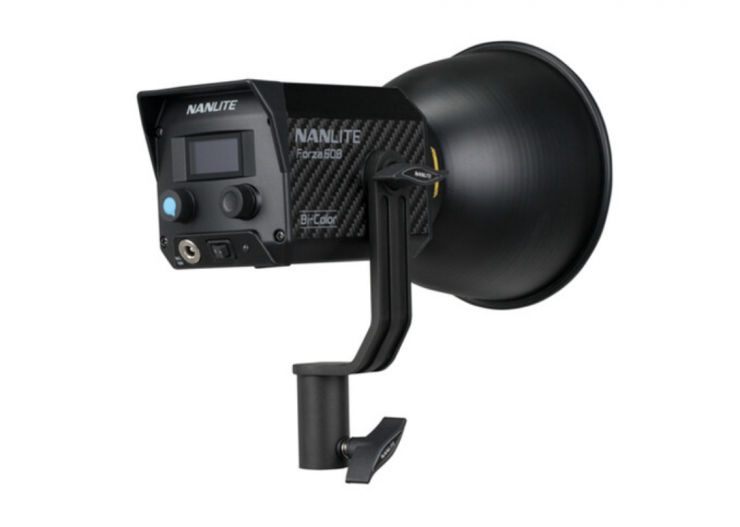
Nanlite Forza 60B
Appearance-wise, the Nanlite 60C looks very similar to Nalite’s own 60D and 60B fixtures.
Build Quality
The build quality of the Nanlite 60C is decent. The housing is reasonably robust and the yoke frame tightens securely.
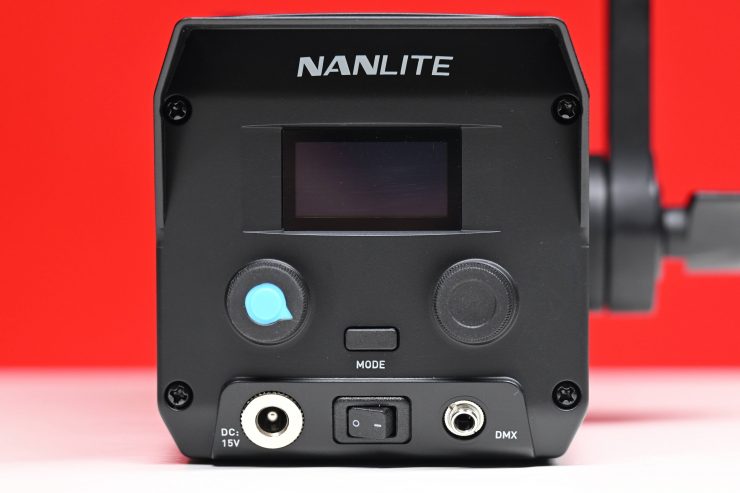
The power on/off button and the rest of the dials and buttons, at least in my opinion, do feel a little on the cheap side, especially for a light at this price point.
The controller is built into the light fixture, but there is a separate power supply.
There is a DC power cable that goes to the power supply. The cable isn’t very long but it has a lanyard loop on it so you can attach it to a lightstand.
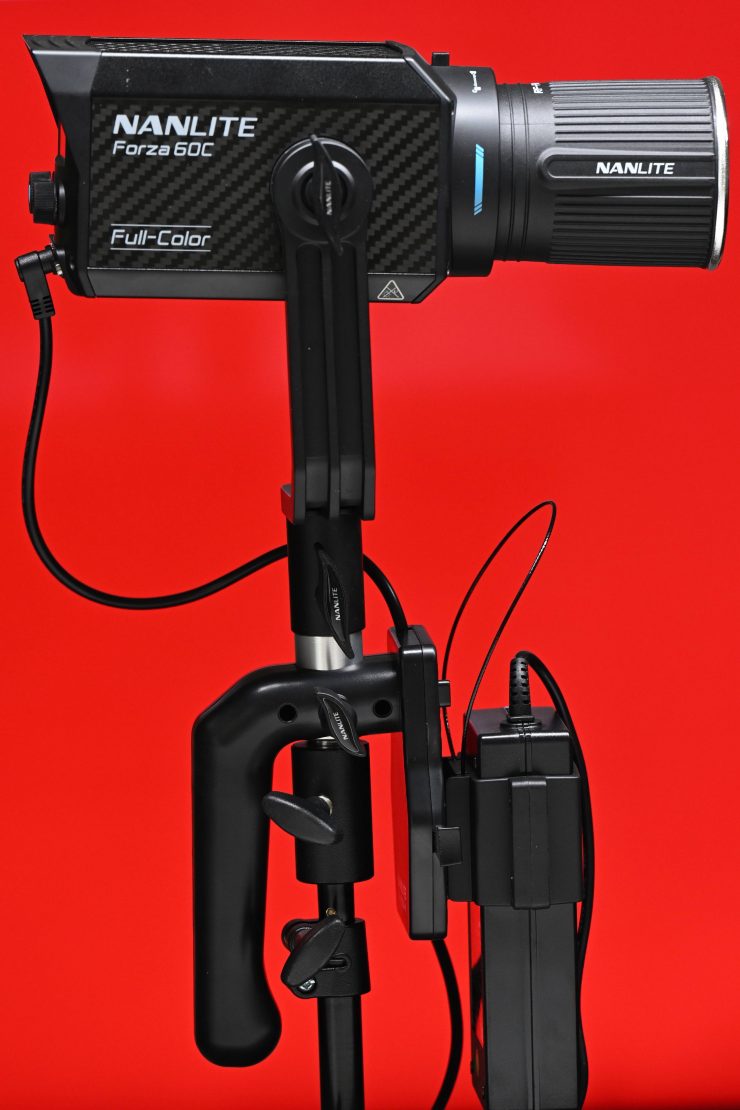
As the power supply also has a small v-mount on it that you can use it to attach to the optional Nanlite V-Mount Battery Grip for Forza 60/60B ($29 USD).
I would recommend purchasing if you already own some V-lock batteries because it is an easy way to power the light for long periods of time. What you clearly need to know about this accessory is that you need to use it with a V-lock battery that has a D-tap.
The light comes with a limited 2 Year Warranty which can be extended to 3 years by registering online.
COB Design
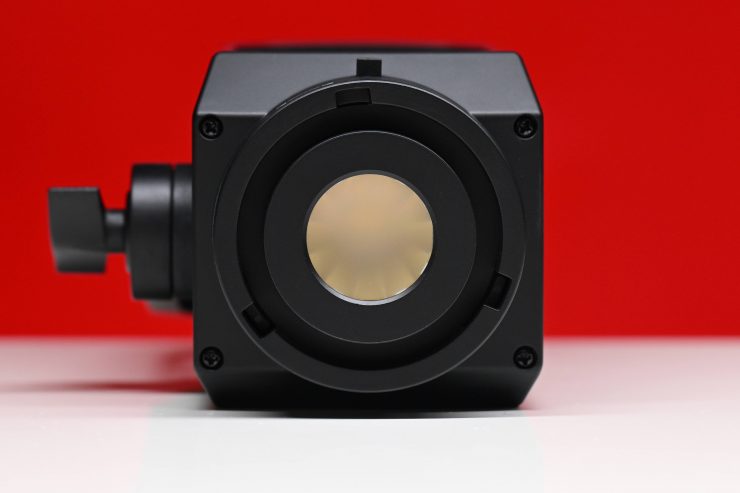
Lots of LED lights on the market, including the Nanlite Forza 60C are using COB technology. COB stands for “Chip On Board” where multiple LED chips are packaged together as one lighting module. The advantage of COB LEDs being multi-chip packaged is that the light-emitting area of a COB LED can contain many times more light sources in the same area that standard LEDs could occupy. This results in a greatly increased lumen output per square inch.
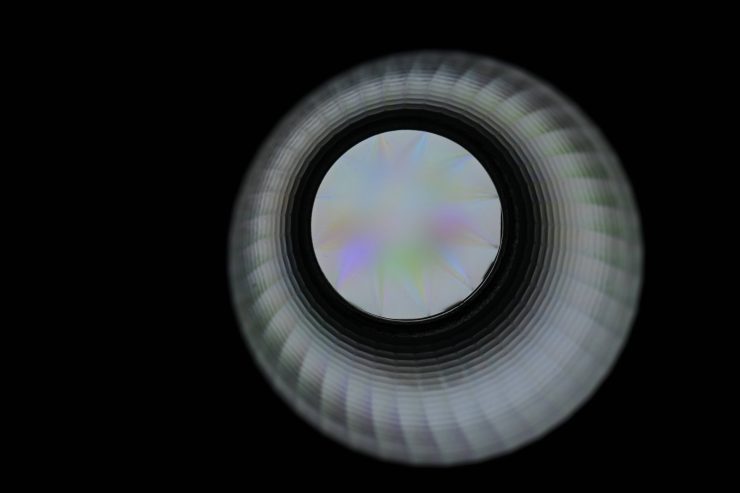
The Nanlite Forza 60C’s light engine sits right on the heatsink and the LEDs are actually sitting inside a mirrored reflector. This is different from how most COB LED lights are designed. The light actually gets projected through a diffused surface instead of just coming straight out like most COB spotlights. Why would you want to do this? Well, I am glad you asked. The whole idea is to create a single light source and by having the light projected through a diffused surface the Forza 60C works really well with projection attachments and it is really bright given its size and power draw. In fact, the 60C is brighter than the 60B bi-color unit despite being a full color light.
The caveat with projecting the light through a diffused surface and getting a concentrated source is that the beam angle is not overly wide on this light even when used open face. It certainly isn’t nearly as wide as most other COB lights when used open face as they tend to be around 120 degrees.
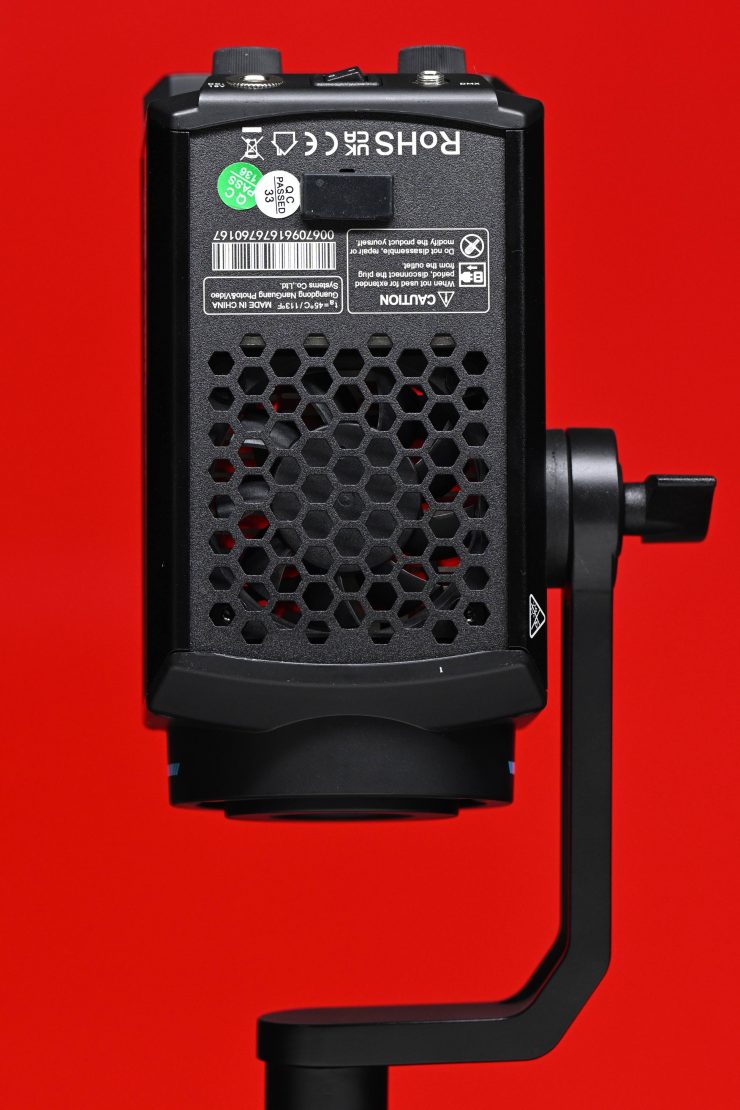
The fixture does feature a decent-sized fan that is on the underside of the light.
The biggest problem with COB LED lights is that unless you diffuse them they are very bright to look at and unsuitable for directly lighting talent.
Weight & Size
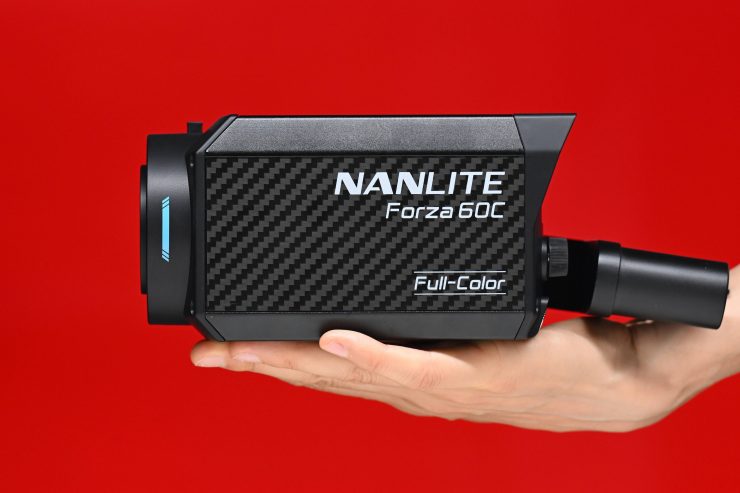
The Nanlite Forza 60C is pretty small and compact, so it won’t take up a lot of space in a bag.
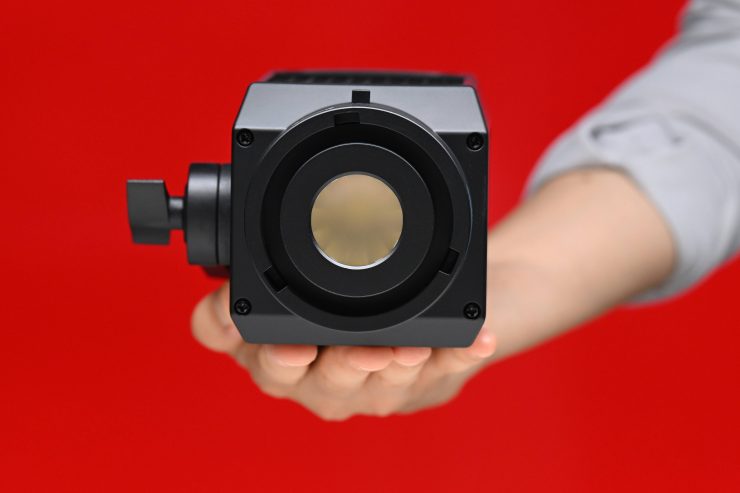
It weighs just 1.8 lb / 800g. The controller is built-in to the lamp head, however, there is a separate AC adapter. That weighs around 465g / 1.02 lb.
The nice aspect about the Nanlite is that you can use it with a relatively lightweight and compact light stand. This makes it a good option for anyone who needs to travel with minimal gear.
RGBACL
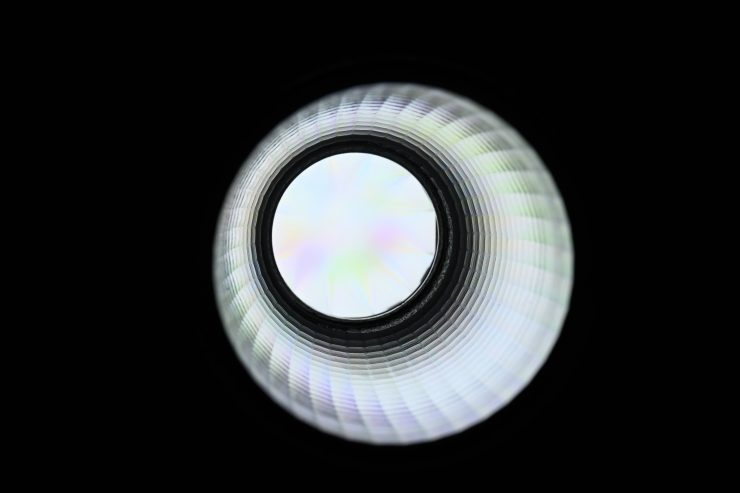
We are seeing a lot of lighting companies now using RGBWW technology. RGBWW stands for Red, Green, Blue & Warm White. There are, however, other types of RGB such as RGBAW and RGBACL.
The Nanlite 60C uses RGBLAC, just like the ARRI Orbiter and Prolycht Orion 300 FS and 675 FS (they are listed as RGBACL which is essentially the same thing). The Orion 300 FS/675 FS and Oribiter don’t use any white LEDs, instead, they are mixing all of those different color LEDs to produce white light. Hive Lighting has also been using 7 LED-chip blending, where instead of the traditional 3 colors, they use red, amber, lime, cyan, green, blue, and sapphire.
The advantage RGBACL/RGBLAC has over RGBWW is that it is capable of giving you a larger CCT range and it can produce certain saturated colors with more output. RGBWW lights tend to struggle to create saturated colors like yellow and they don’t always have as much output when generating saturated colors. They can also have a large drop-off in output at different CCT settings, especially at Kelvin color temperatures like 2500K or 10,000K.
RGBACL/RGBLAC light engines also have the added ability to produce a larger color gamut. Because of the additional ACL emitters, the light is able to produce a far wider array of colors than an RGBWW light. I think what you clearly need to know is that when creating, for example, a 5600K or 3200K source, there isn’t going to be a huge difference between RGBWW and RGBACL/RGBLAC despite what marketing departments want you to believe.
There is a lot of debate and argument over what is better. Aputure will tell you that RGBWW is better, while Prolycht will tell you that RGBACL is better. As I have said before, I don’t have any horses in this race, so I am not influenced by what lighting companies say. All my reviews are based on data and facts, and every light gets the same unbiased treatment regardless of who makes it or how much it costs. No manufacturer has any say over what gets published on this site. If you wonder why certain companies’ products are never reviewed on the site there is a reason why.
Beam Angle
The beam angle of the fixture, when used open face, is 56.5°. If you use it with the included reflector it is 45°. The nice aspect about the Forza 60C is that when used open face or with its reflector, it produces really crisp shadows.
This relatively narrow beam angle does mean that the light isn’t going to be suitable for certain lighting applications. I personally see this light as a good accent, and background light. It is not something I would probably use as a key light, however, if you coupled the light with Nanlite’s own softbox that is designed for the Forza 60 series you can achieve decent results.
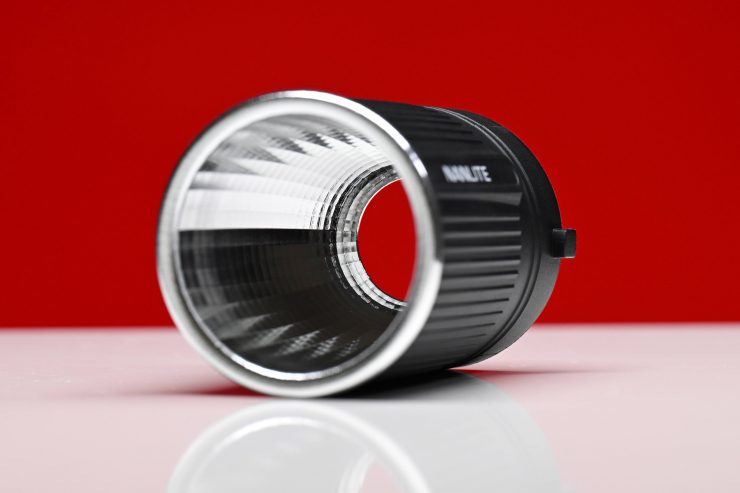
The included reflector is really small.
Mounting
TheNanlite Forza 60C comes with a one-sided yoke frame. As the light is relatively small and it doesn’t weigh much, the one-sided yoke frame does the job. There is plenty of clearance and you point the light straight up or straight down if need be without anything hitting the yoke frame.
Power Draw
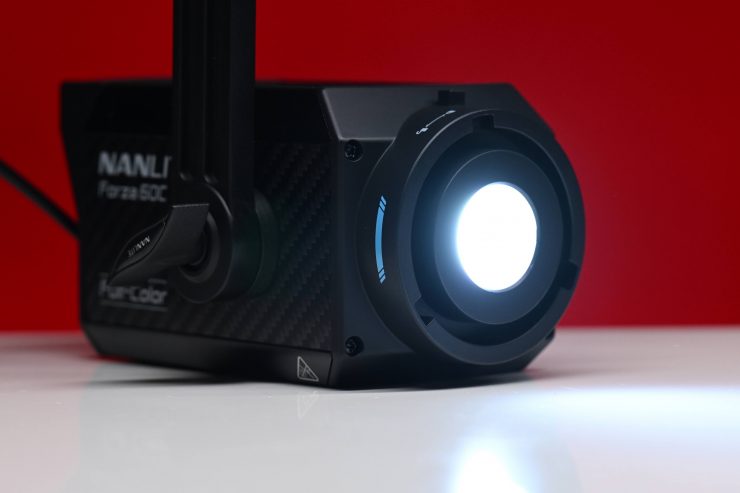
The power draw of the Forza 60C is 88W, which means it can be powered in a variety of different ways.
In the kit, you get an AC power supply, and a battery handgrip that has dual mounts for NP-F type batteries.
This battery handgrip can also be attached directly to a light stand. It also has little adjustable feet on it so you can place it directly on a flat surface.
Nanlite also has the optional Forza 60 & 60B V-Mount Battery Grip ($29.99 USD) that has a standard 5/8″ receiver mount for direct mounting on any standard light stand. This will take full-sized or mini V-lock batteries.
The ability to power the light in multiple ways is something that shouldn’t be overlooked. If you are traveling a lot or need to use lights in remote locations, being able to power them from batteries is a big deal. This also helps if you need to hide the light in the background and can’t run mains power.
The power cable that attaches to the light is just a standard barrel type and it would have been nice to have seen a locking mechanism instead. While I didn’t encounter any issues with the cable, at least in my opinion, it is always better to have a locking power connector on a light.
Mount
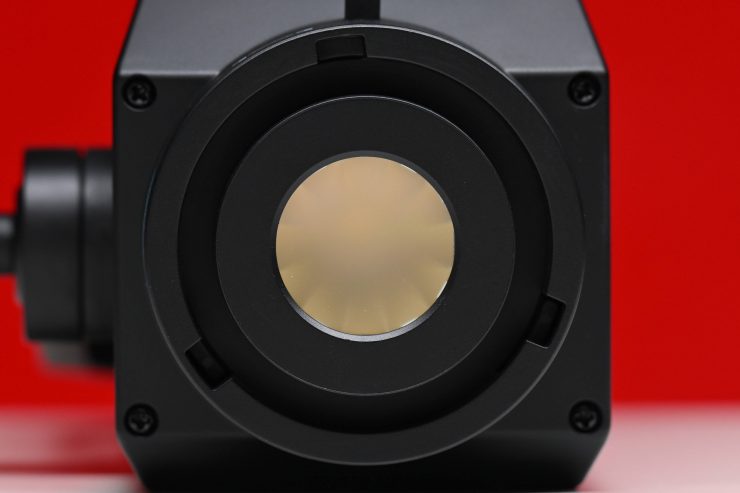
Unlike most COB spot lights, the Nanlite Forza 60C doesn’t utilize a Bowens mount, instead, it uses a proprietary FM mount. A native Bowens mount would be too large for this fixture, so what Nanlite has done is to include a Bowens mount adapter. This allows you to use readily available lighting modifiers and accessories that you may already own.
Controls & Menu System
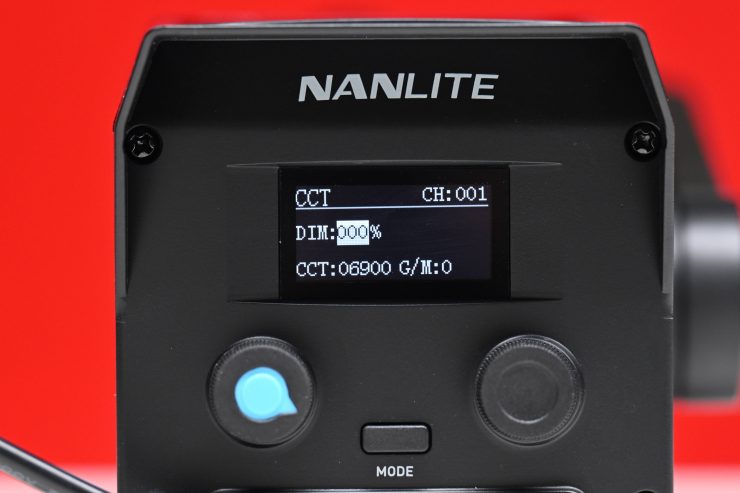
The rear LCD screen on the light looks similar to what you would find on most of the Nanlite products. Although it is fairly basic, it does show you key information about the lights operating modes, brightness, CCT, etc.
With a good light, you shouldn’t have to read a manual to work out how to operate it. You should be able to turn it on and use it straight away. With the Forza 60C that is exactly the case, it is straightforward and easy to operate.
In the menu, you can adjust quite a few settings, such as the DMX, fan, etc. The menu isn’t perhaps the most intuitive, but it is still easy enough to make changes to items that you will probably very rarely need to adjust.
As well as being able to adjust certain parameters and modes on the light itself, you can also use the NANLINK Bluetooth app. Additionally, 2.4GHz provides control through the separately-available WS-TB-1 transmitter box for more elaborate setups, or with hardware remotes like the NANLINK WS-RC-C2. DMX/RDM control is also supported for advanced users.
Operating Modes
The light has the following lighting modes that you can access from the fixture:
- CCT
- HSI
- EFFECT
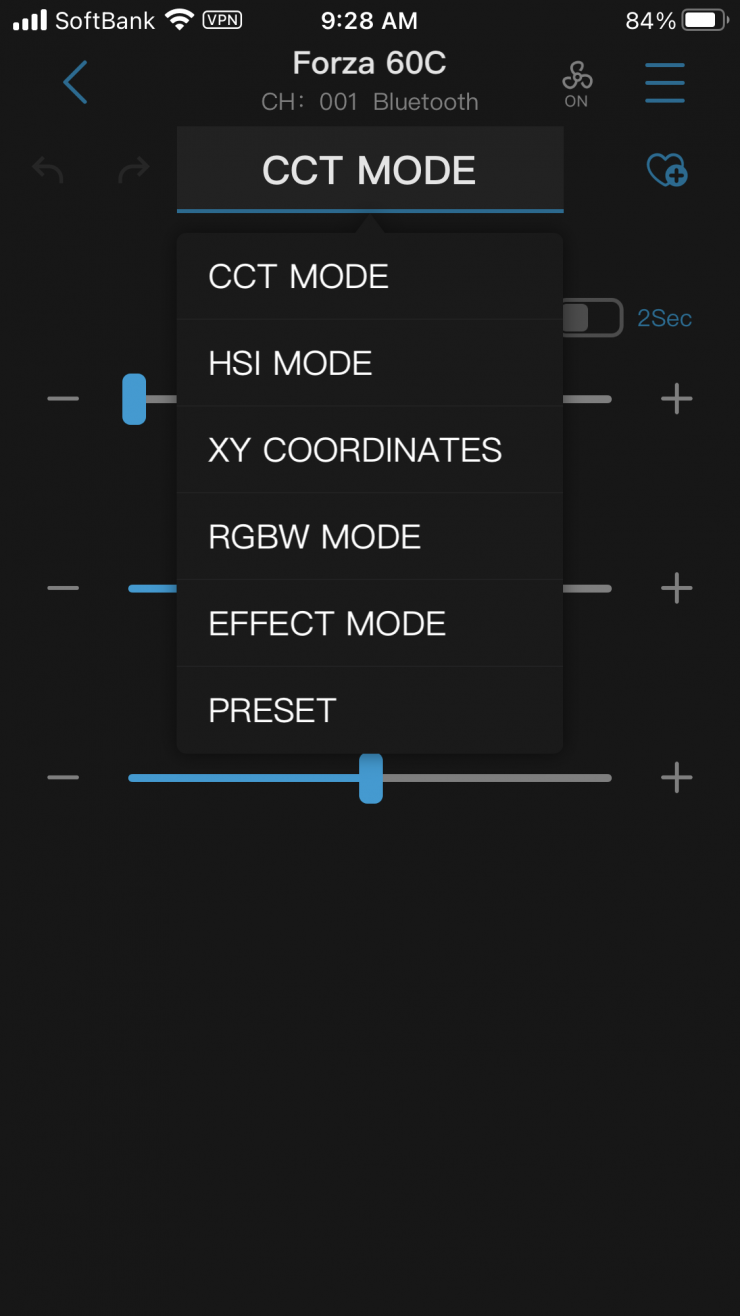
There are also some additional modes, but they can only be accessed through the app. These modes are:
- XY COORDINATES
- RGBW MODE
- EFFECT MODE (can also be accessed from the light)
- PRESET
Correlated Color Temperature (CCT)
In the CCT Mode, you have full access to making Kelvin color temperature adjustments between 1800-20,000K. This is a huge range and this is one of the advantages you get when using RGBLAC over RGBWW.
+/- Green adjustment
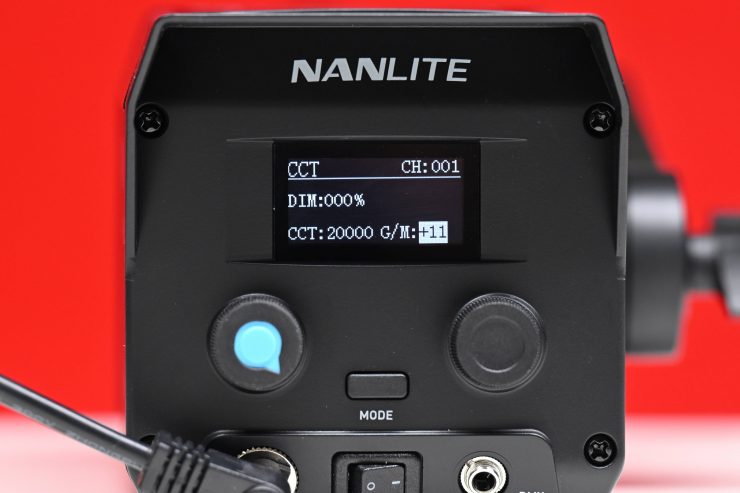
As the fixture includes +/- Green adjustment you can quite easily correct any tint.
Being able to dial in more or reduce the amount of green coming from your lighting source can make a huge difference. Different camera companies use different sensors in their cameras and they all react differently to light. Some camera sensors may lean towards magenta, and some, more towards green. By making CCT adjustments you can dial in the light so that it looks better for whatever camera system you are using. CCT adjustment also helps when you are trying to match lights from different manufacturers.
HSI
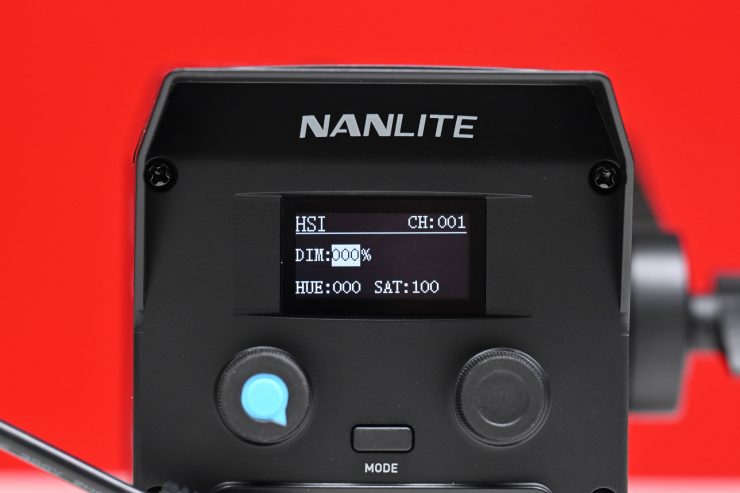
The HSI mode lets you create just about any color you can think of. It gives you full hue and saturation control as well as intensity. By manipulating, the hue and saturation you can create some really interesting colors that depending on the project you are working on can really add some creative flair. I quite like using this mode to create a lot of color separation between the foreground and background, or for recreating a really cold or warm-looking image.
The only complaint I have is that if you are adjusting HSI on the actual light itself you only see HUE listed as degrees from 0-360. Most other full color lights these days have a visual indicator that makes it a lot easier to see what type of color you are trying to create.
EFFECTS
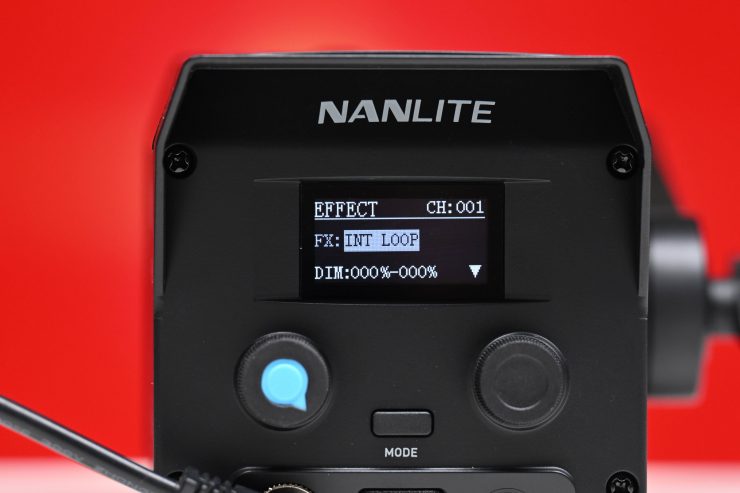
The EFFECTS mode lets you recreate a wide range of lighting effects that can be handy for certain scenarios. The effects include:
- HUE LOOP
- CCT LOOP
- INT LOOP
- FLASH
- PULSE
- STORM
- POLICE CAR
- TV
- PAPARAZZI
- CANDLE/FIRE
- DISCO
- BAB BULB
- FIREWORK
- EXPLOSION
- WELDING
All the effects modes can be individually adjusted, and you change the Hue, Saturation, Speed and Cycle. Again this is much easier to do on the app than on the back of the light.
No Gel Mode?
According to Nanlite, they will be adding a Gel Mode in a future firmware update.
Bluetooth App
The light can be controlled via Bluetooth using the NANLINK App.
There is a range of parameters that you can adjust using the app.
In the app you can control and make changes to the following modes:
- CCT
- HSI
- XY COORDINATES
- RGBW
- EFFECT
- PRESET
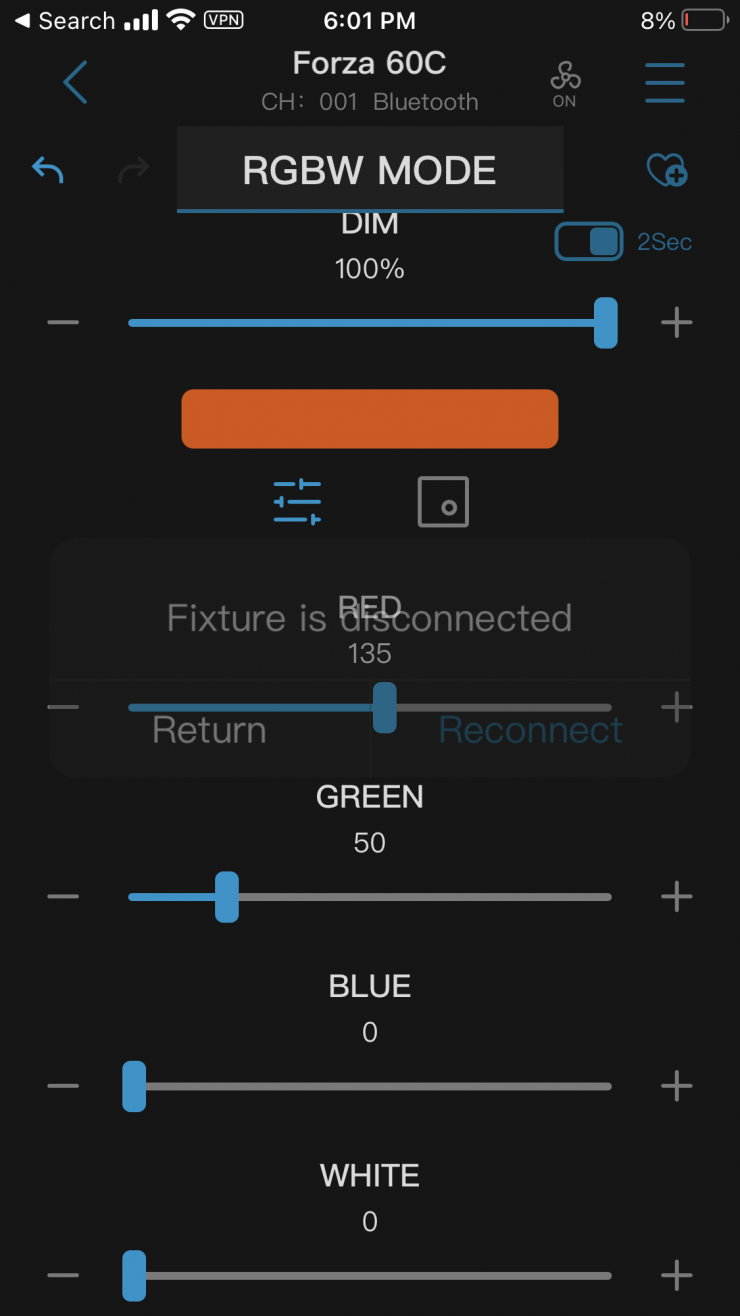
What is a little odd is that because Nanlite has so many different lights that you can use with this same app it hasn’t really been customized to work with the 60C. For instance, there is still a mode called RGBW, even though this light is RGBLAC. If you enter this mode you only have the ability to adjust RGBW values. You can’t adjust individual values for LAC. This is an issue because if you use the app it seems to only allow you to generate colors that are well below what an RGBLAC light is capable of. This is presumably because no one has bothered to change the app and it hasn’t been set up for an RGBLAC light.
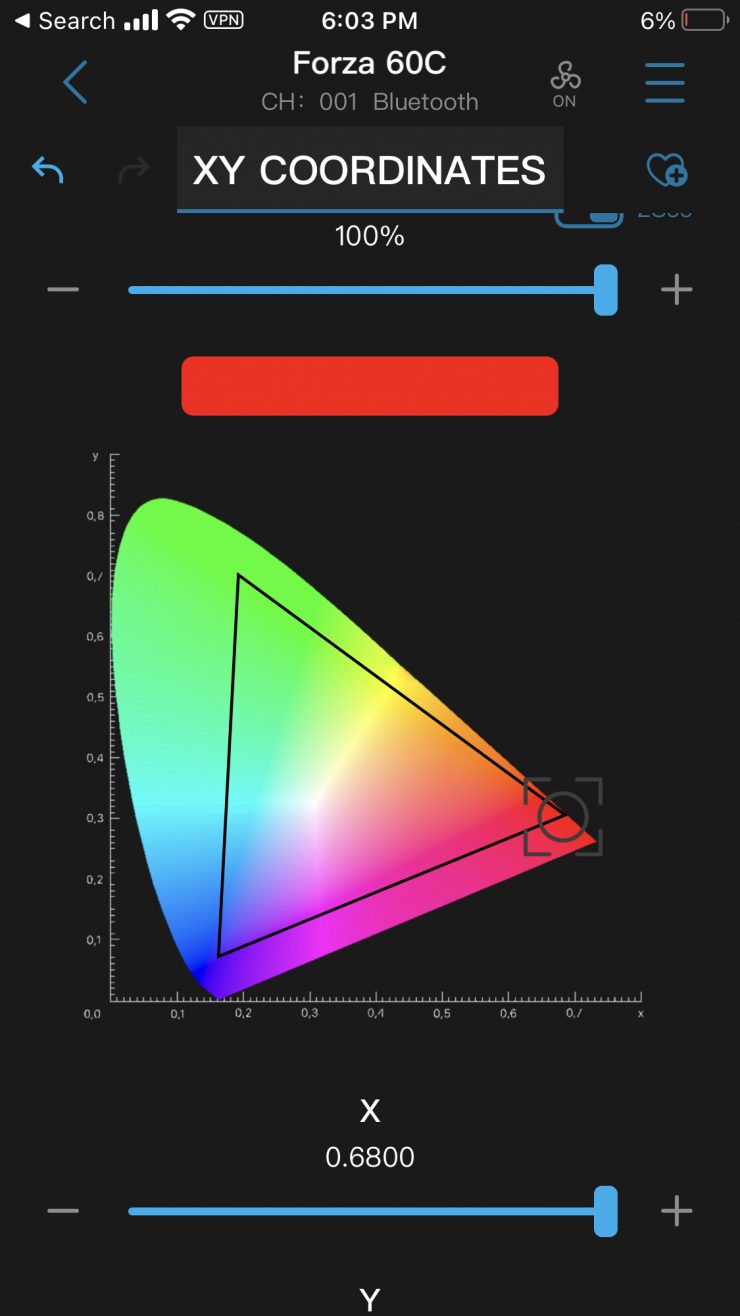
The same issue happens if you try and use the XY COORDINATE mode. If you look at where you can move the XY COORDINATES they are constrained within a smaller-sized space gamut.
The devil is in the details and although Nanlite makes some really good lights, it is little things like this that often upset customers.
Apart from those complaints, the app is straightforward and reasonably easy to use, however, they haven’t made it as intuitive or visually appealing as some other companies lighting control apps. This is something I would like to see Nanlite work on.
The only other downside when using the app is that when you make changes they don’t happen instantaneously, there is a slight delay.
How does it stay cool?
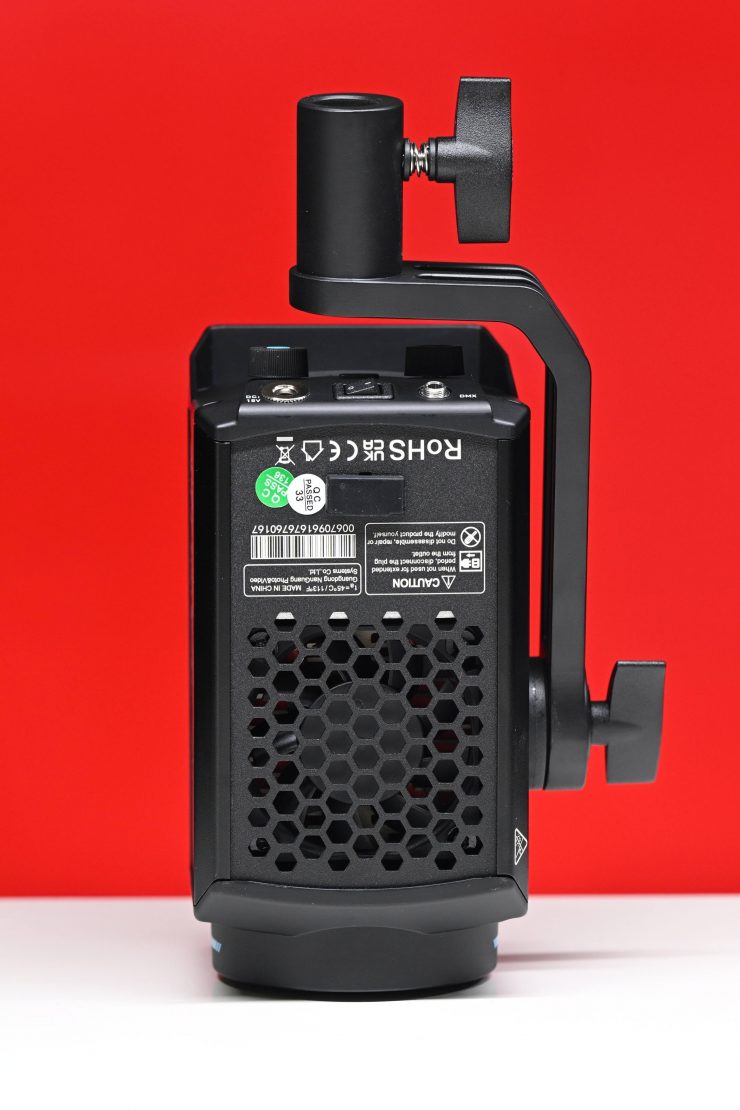
COB lights get very hot, and keeping them cool is not an easy task. The Forza 60C, as I mentioned earlier in the review, does utilize a fan.
In the menu settings on the light, you have the choice of turning the fan on or off. If you turn the fan off the maximum output is capped at just 25%.
You can also turn the fan on or off using the NANLINK app. The trouble when doing this with the app, is that the intensity slider will still show you values that are way above 25% even though the light is only at 25% output. This is where I think NANLITE needs to pay more attention to small details. Little quirks like this could easily be addressed by updating the app, but unfortunately, a lot of lighting companies release apps, and then very rarely ever update them.
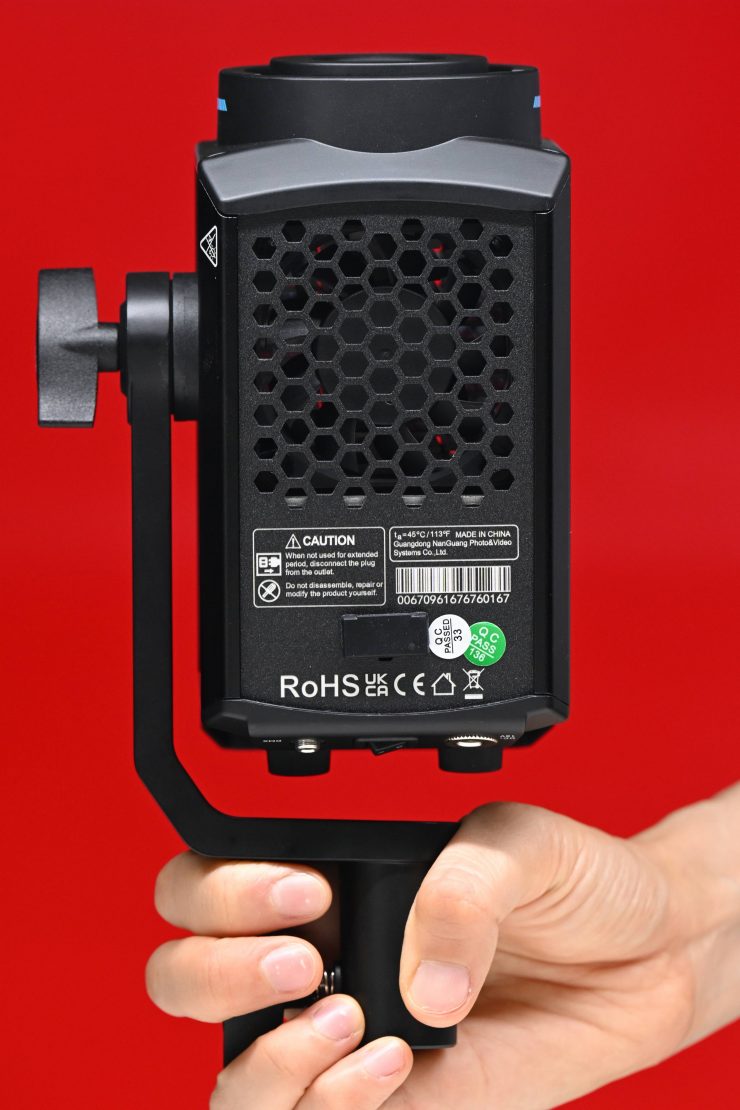
The fan in the light is fairly quiet and that allows you to use it close to where audio is being recorded.
Photometrics
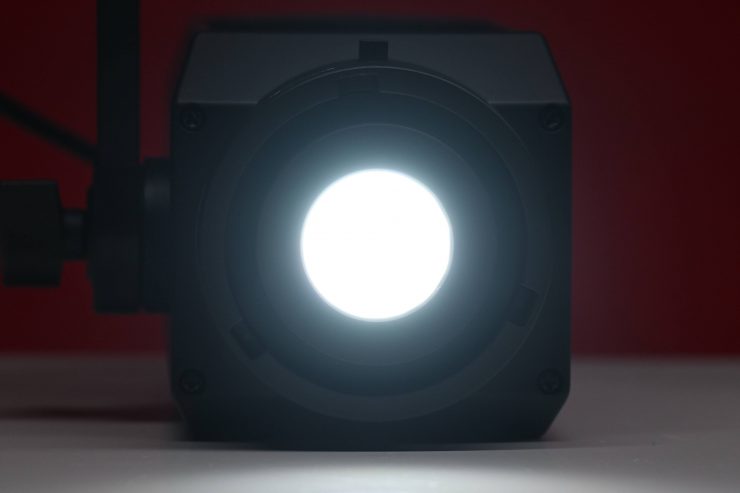
So now let’s get to the photometric results. I always test lights in this way so that I get a reference to how they compare to other fixtures. Results only tell part of the story and should never be used alone to judge a light. I have found from extensive testing over the years that certain lights that have good photometric results don’t always look good, and lights that have worse photometric scores can sometimes look better than their results indicate.
You can’t judge a light from one set of photometric results. You have to look at all of the different results to be able to come to a conclusion.
Different lights can also look different depending on what camera you happen to be using.
Output & Color Temperature Accuracy
I tested the Nanlite Forza 60C at a variety of Kelvin color temperatures with a Sekonic C-800 Spectrometer to find out how much output the light had and how accurate the Kelvin color temperature reproduction was. All readings are taken at a distance of 1m (3.28ft) in a controlled environment. The readings were also taken directly from the lighting source. In the case of using the light with the Reflector, F-11 Fresnel, and PG-FMM-19, they were taken from the edge of those attachments.
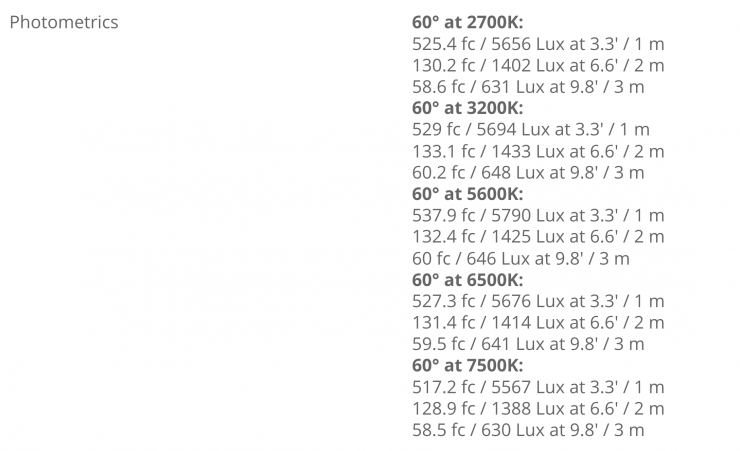
Above are the claimed photometric data that Nanlite lists for the Forza 60C.
5600K (open face 56.5°)
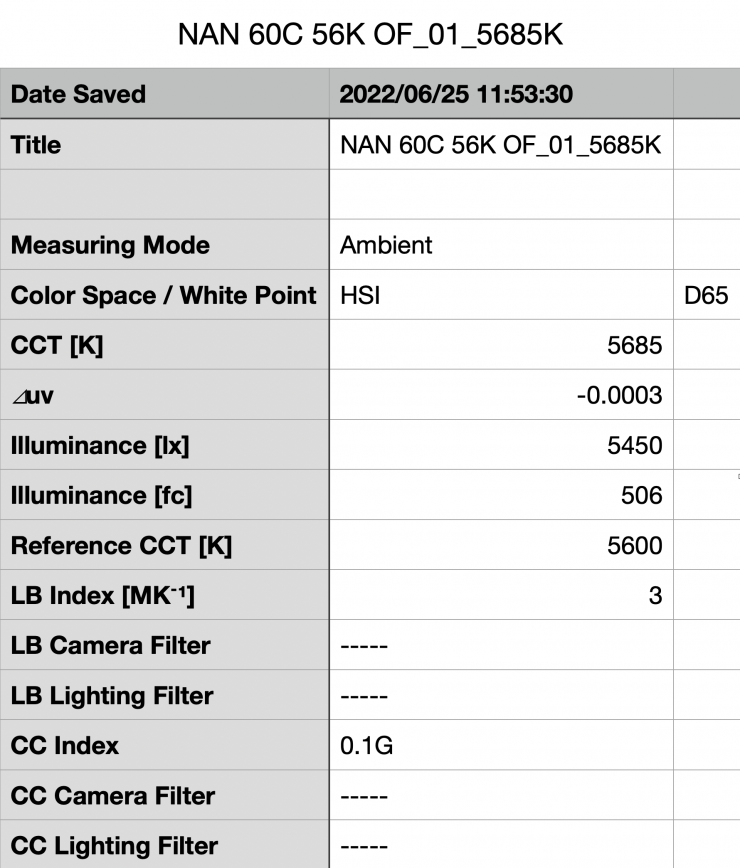
Above you can see the Forza 60C recorded an output of 5450 lx (506 fc) when set at 5600K and used open face. Nanlite lists a figure of 5790 lx, so the result I got was fairly close to their claimed figure.
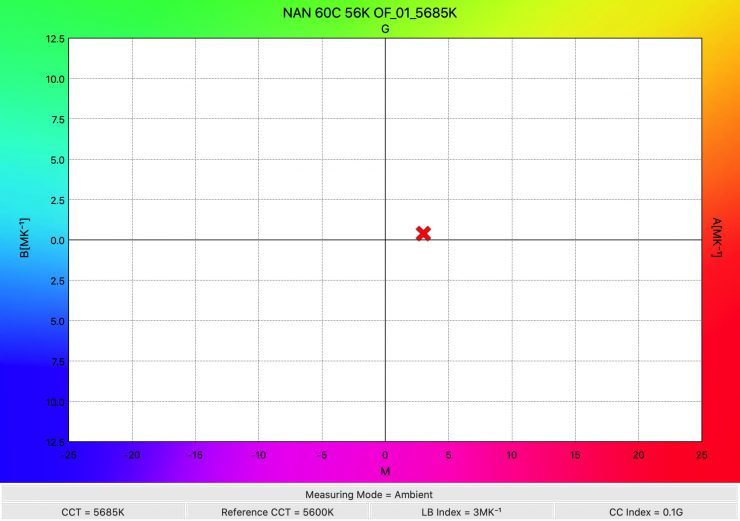
The light recorded a Kelvin color temperature reading of 5685K which was pretty good.
3200K (open face 56.5°)
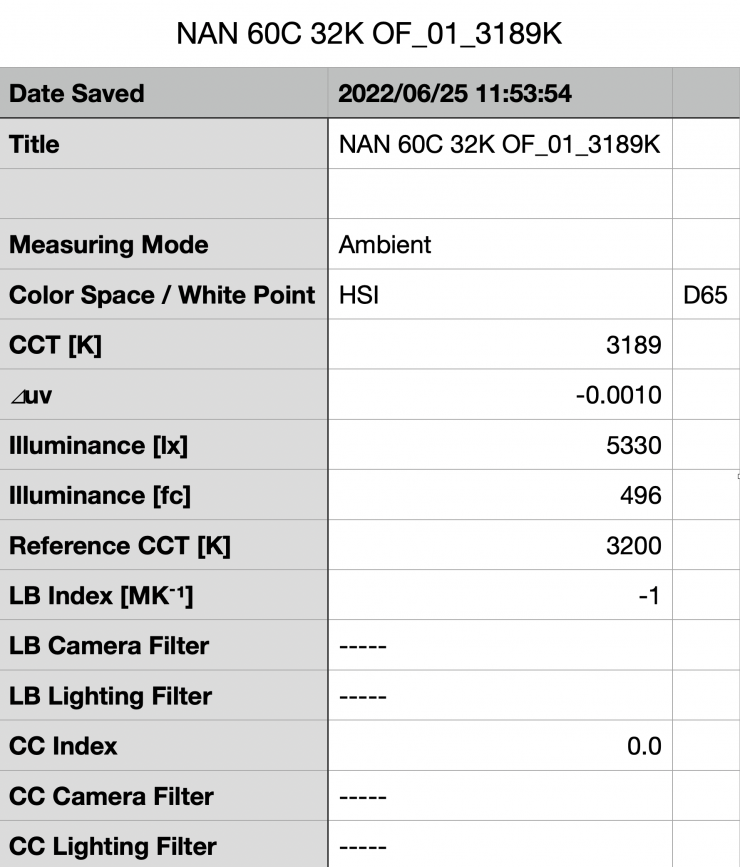
Above you can see the output when it was set at 3200K in the open face configuration was 5330 lx (496 fc), which was just 2.2% less than the 5450 lx it produced at 5600K. Nanlite lists a figure of 5694 lx, so the result I got was not too far away from their claimed figure.
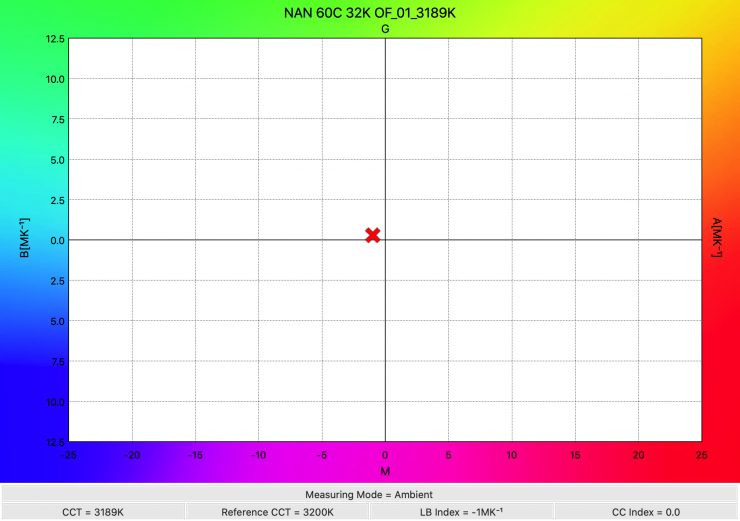
As far as Kelvin color temperature accuracy goes, it recorded an extremely accurate reading of 3194K.
Reflector
So, now let’s see how much output the light has when used with its 45° reflector.
5600K (Reflector 45°)
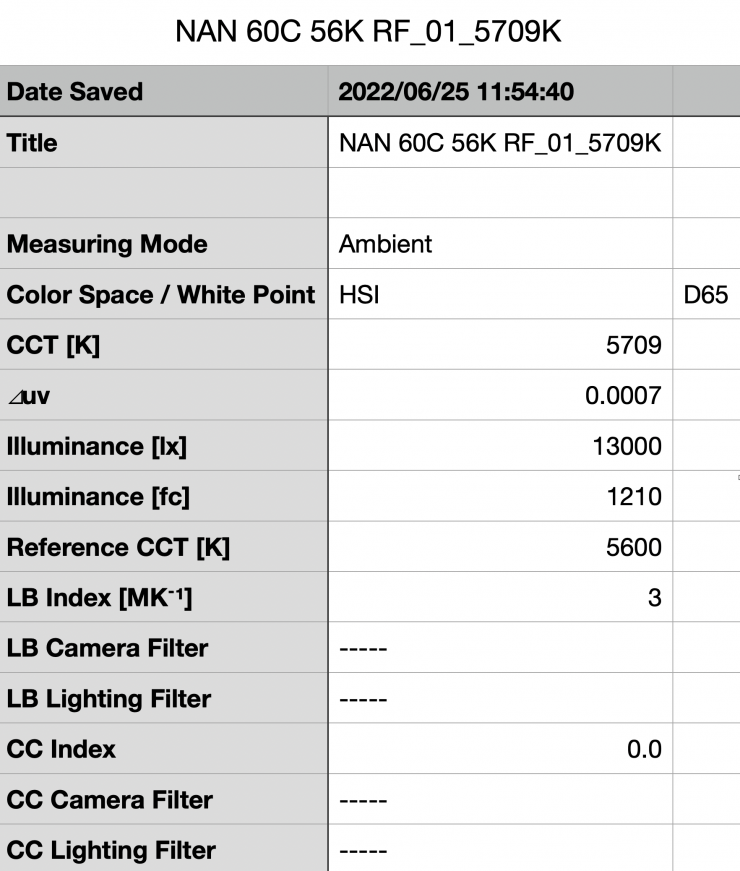
Above you can see the lights output when it was set at 5600K with the reflector was 13000 lx (1210 fc). This was 138.5% more than the 5450 lx it produced at 5600K when used open face. It is important to note that this measurement was made from the edge of the reflector. This is a lot of output from a fixture that was just 88W, but it is at a fairly tight beam angle of 45 degrees.
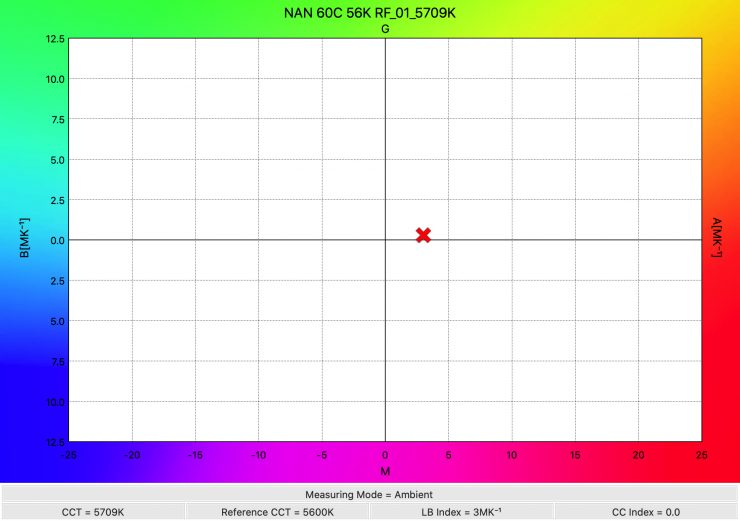
As far as Kelvin color temperature accuracy goes, it recorded a reading of 5709K. The Kelvin color temperature accuracy when using the reflector was fairly similar to when the light is used open face. It is nice to know that when using the reflector the light’s Kelvin color temperature won’t change by any real noticeable difference.
3200K (Reflector 45°)
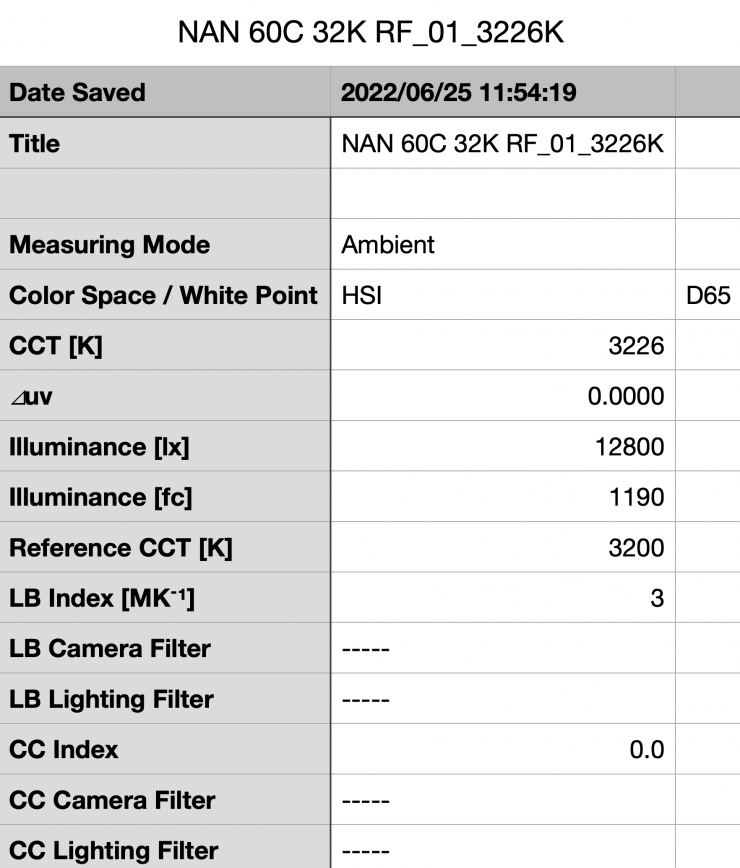
Above you can see the output when it was set at 3200K with the standard reflector was 12800 lx (1190 fc), which was 1.56% less than what it output at 5600K using the reflector.
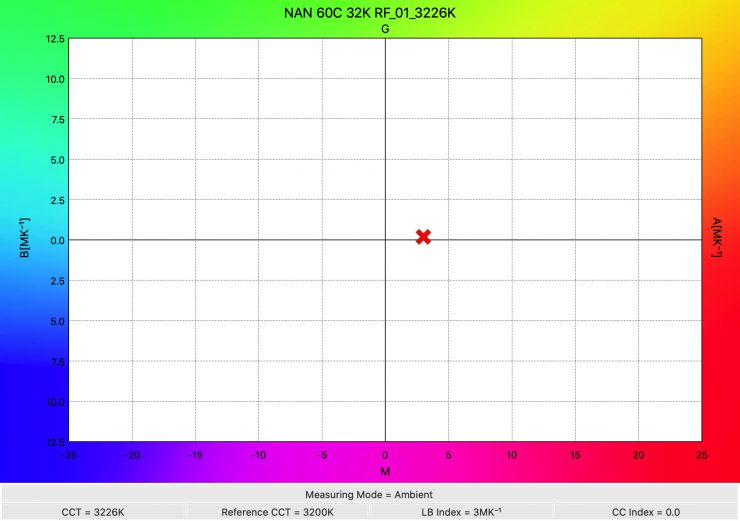
As far as Kelvin color temperature accuracy goes, it recorded an exceptionally good reading of 3226K which was a very good score.
How does it perform at various Kelvin color temperatures?
Summary of results (Reflector)
| SETTING | OUTPUT | CCT READING |
| 2500K | 11,400 lx | 2470K |
| 3200K | 12,800 lx | 3226K |
| 4500K | 12,600 lx | 4611K |
| 5600K | 13,000 lx | 5709K |
| 6500K | 12,600 lx | 6612K |
| 8000K | 12,400 lx | 8078K |
| 10000K | 12,300 lx | 9952K |
These results show me that the light’s output varies by just 14% across the Kelvin color temperature range I was able to test. If you look at 3200K to 10,000K the output difference only varied by 5.69%. The consistency of the output across the CCT range is really good.
The Kelvin color temperature accuracy across the range is very good from 2500K to 10,000K. It was no more than 120K off being correct at any measurement I took.
Kelvin color consistency & linear output when dimming the light
Now, what you should always do when testing lights is to see if the Kelvin color temperature remains consistent when dimming the light. Just because you set a light at say 5600K, that doesn’t mean that the Kelvin color temperature will remain stable as you start dimming the fixture down. I also wanted to see how linear the dimming curve was.
I decided to do a series of tests at 100%/75%/50%/25%10% to see if the Kelvin color temperature being recorded changed. This was done at a distance of 1m using a Sekonic C-800. These tests were done at 5600K with the reflector.
| CCT READING | OUTPUT | INTENSITY % |
| 5709K | 13,000 lx | 100 |
| 5788K | 9,830 lx | 75 |
| 5825K | 6,910 lx | 50 |
| 5869K | 3,830 lx | 25 |
| 5897K | 1,730 lx | 10 |
The Nanlite Forza 60C could be slightly better at maintaining Kelvin color consistency as you start dimming the fixture. My testing showed that the Kelvin color temperature varied by 188K. These are hardly terrible results, but not as good as other lights that I have tested.
As far as how linear the output is when you start dimming the light, at 50% output it had 46.84% less output than when used at 100%. At 25% it had 70.53% less output than when used at 100%. At 10% output, it had 86.69% less output than when used at 100%. This shows me that the light’s dimming curve is reasonably linear.
Output when creating super saturated colors
I also wanted to test the light to see how much output it could produce when creating super-saturated colors. All readings are taken at a distance of 1m (3.28ft) in a controlled environment. The readings were also taken from the edge of the Reflector.
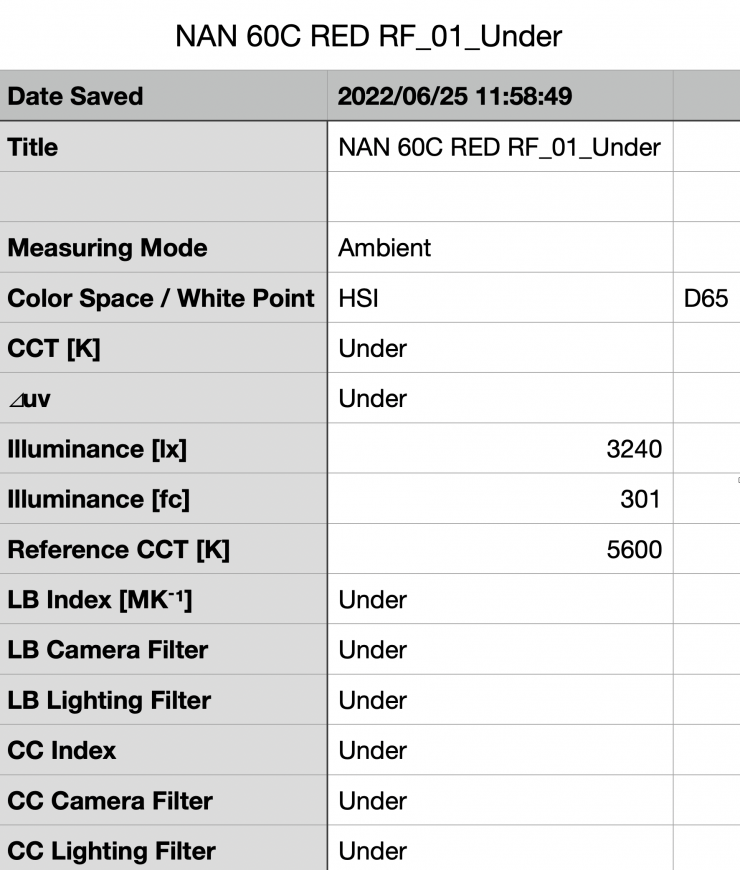
Above you can see that the light when using its reflector and creating a super saturated red with a HSI value of 0 degrees recorded an output of 3240 lx (450 fc). What you clearly need to know when using full color lights like this is that the output levels you can produce when creating super saturated colors (depending on the color) are generally going to be a lot less than when using the light in a CCT mode.
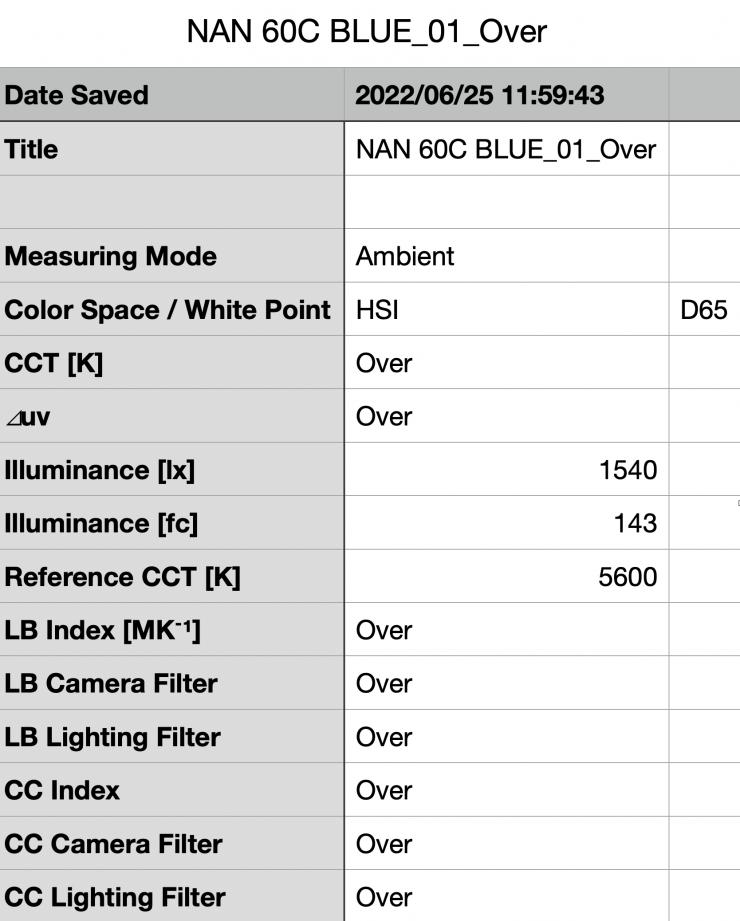
Above you can see that when the light was set to create a super saturated blue with an HSI value of 240 degrees it produced an output of 1540 lx (143 fc).
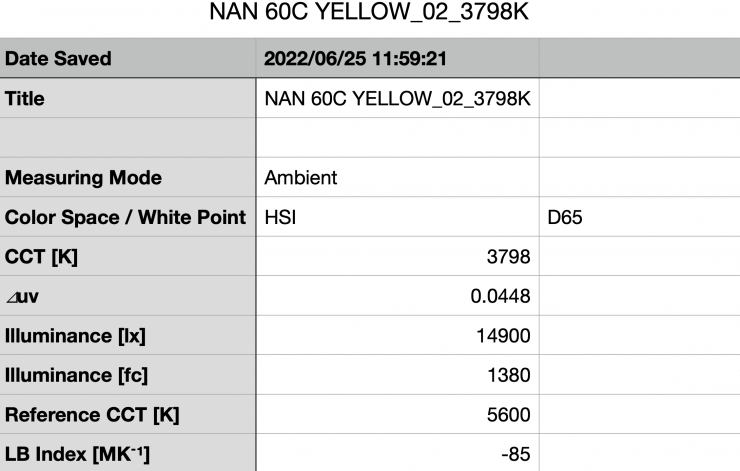
Above you can see that when the light was set to create a super saturated yellow with an HSI value of 60 degrees it produced an output of 14,900 lx (1380 fc). Saturated yellows are very hard for RGBWW lights to produce. Because the Forza 60C is using RGBLAC it does a really good job of producing colors like this.
Output when using the Nanlite Projector Mount (19°)
I also wanted to test the light when using the optional Nanlite Projector Mount for Forza 60 and 60B LED Monolights (19°) to see how much output it had and if the Kelvin color temperature gets altered in any way.
5600K
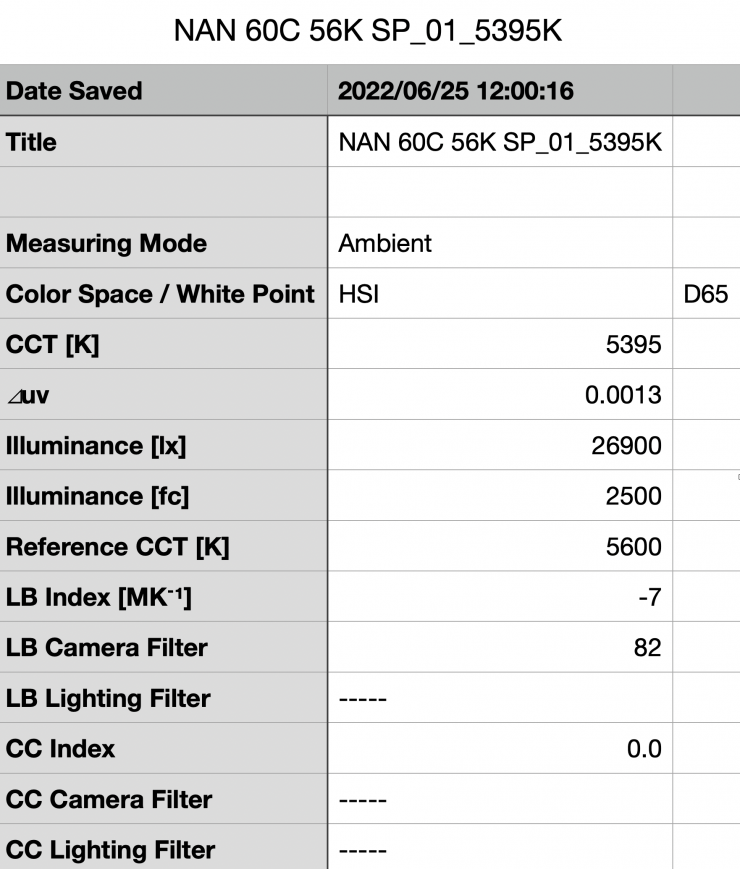
Above you can see the light’s output when it was set at 5600K with the Nanlite Projector Mount for Forza 60 and 60B LED Monolights (19°) was 26,900 lx (2770 fc). This is a good amount of output, even though it is at a very tight beam angle. It is important to note that this measurement was made from the edge of the Projector mount.
The Nanlite Projector Mount for Forza 60 and 60B LED Monolights (19°) works really well if you need to concentrate light in a very small area, or even to use with lighting modifiers such as the CRLS reflectors.
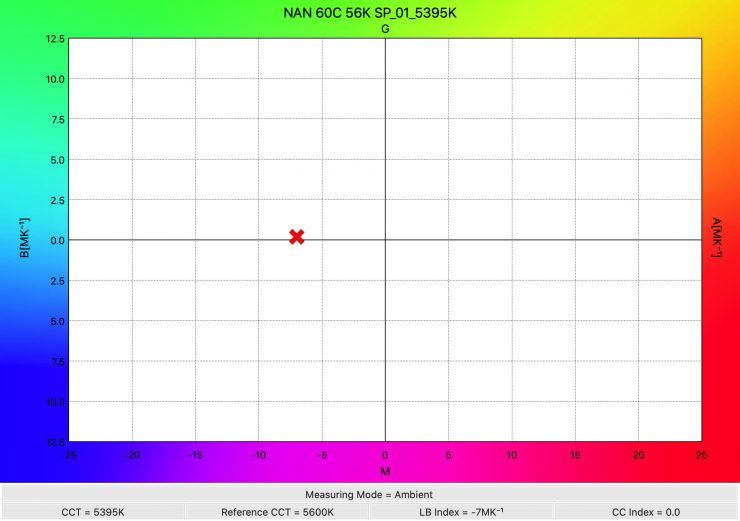
As far as Kelvin color temperature accuracy goes, it recorded a reading of 5395K which was not nearly as good as the reading it recorded when used open face or with its reflector.
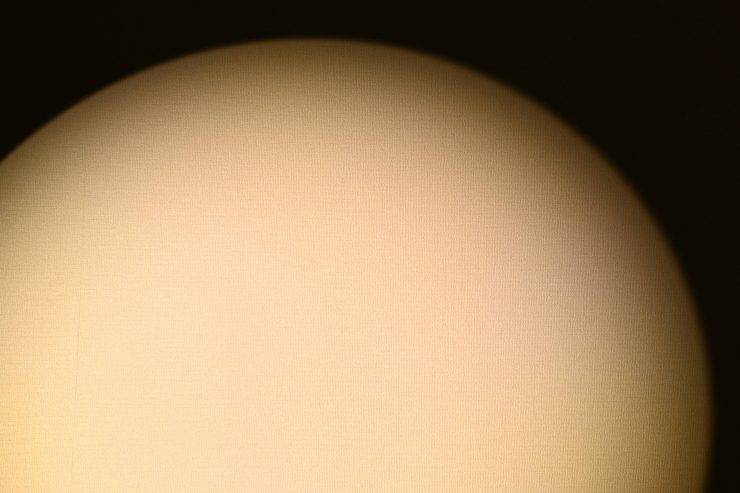
The only caveat with using the Nanlite Projector Mount for Forza 60 and 60B LED Monolights (19°) is that as its name suggests, it wasn’t designed for the 60C. As the 60C has a narrower beam angle, it isn’t going to illuminate all of the projector mount. What this means is that you will get some drop-off in illumination on the edges of the beam. Now, this isn’t as terrible as it may sound because if you put a gobo inside the projector mount, the gobo is going to get fully illuminated. These are very minor nit-picks, but they are still worth mentioning.
The biggest issue I found is that if you are using the projector mount without gobos to create crisp edges on a circle you can’t, but on a square, it doesn’t seem to be an issue.
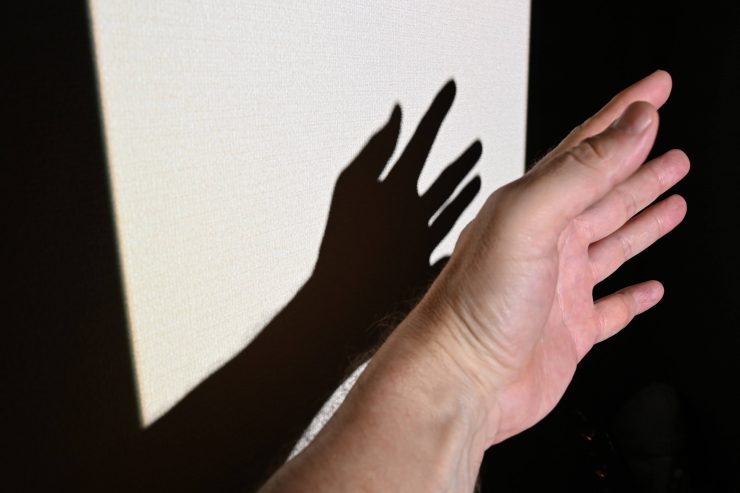
The projector mount is very capable of creating crisp edges and shadows.
With the included gobos it is easy to create patterns and make them either sharp or diffused by adjusting the focus mechanism on the projector mount.
Output when using the FL-11 Fresnel
I also tested the light with the optional Nanlite FL-11 Fresnel ($79 USD) to see how much output it had, and if the Kelvin color temperature gets altered in any way.
5600K (10°)
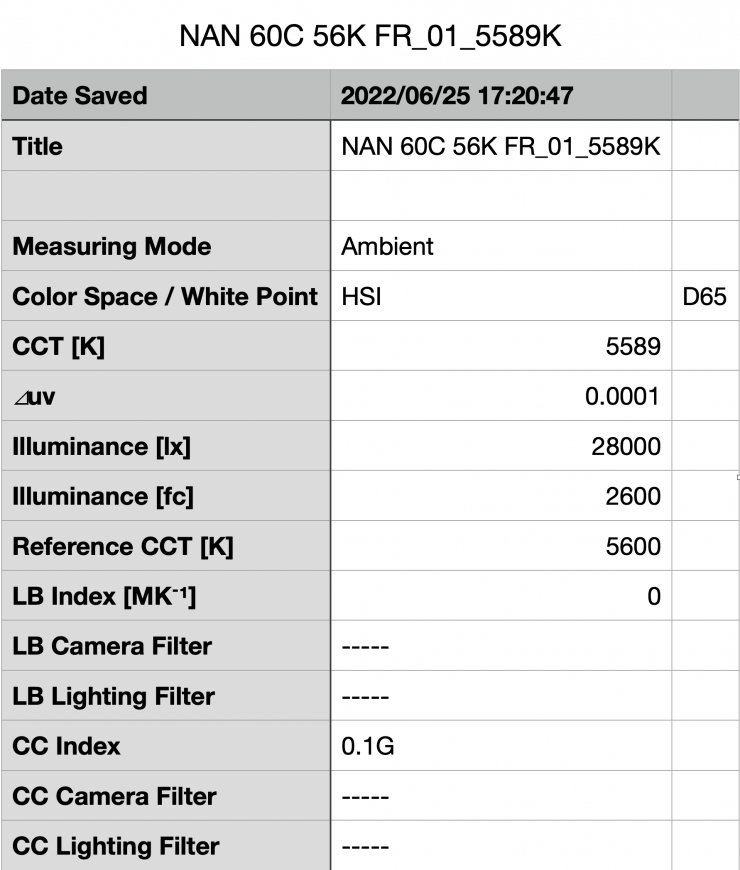
Above you can see the light’s output when it was set at 5600K with Nanlite FL-11 Fresnel Lens for Forza 60 set at 10 was 28,000 lx (2600 fc). This is a good amount of output, even though it is at a very tight beam angle. It is important to note that this measurement was made from the edge of the Fresnel.
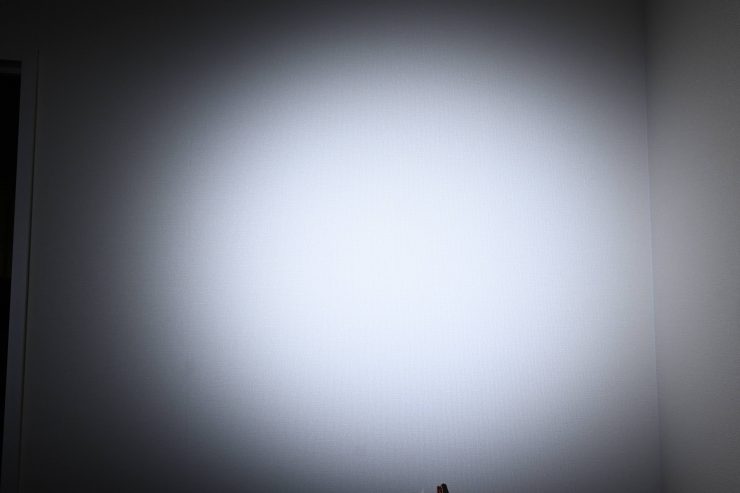
The caveat with using the FL-11 Fresnel Lens for Forza 60, just like the Nanlite Projector Mount for Forza 60 and 60B LED Monolights (19°) is that it wasn’t designed for the 60C. As the 60C has a narrower beam angle, it isn’t going to illuminate all of the Fresnel. What this means is that you will get a drop-off in illumination out towards the edges of the beam. You need to be aware of this, especially when using it at 10°.
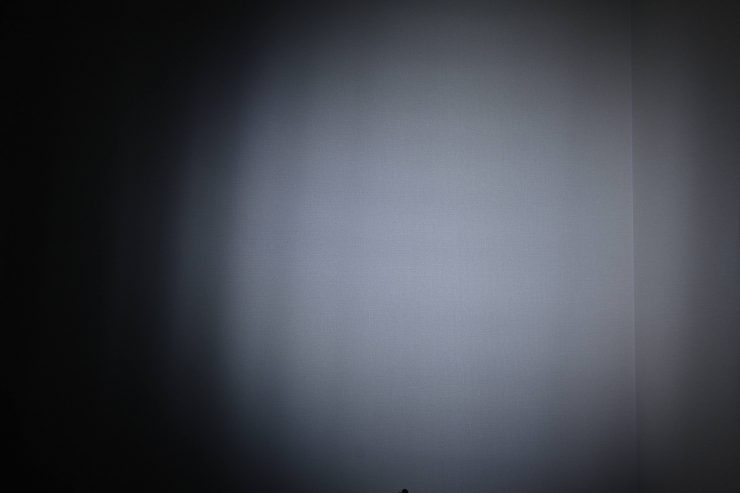
If you also use the Fresnel at 10° with the included barndoors and you try and close the barn doors down it does introduce some bad pattern effects. This is fairly common on most of these COC spot light Fresnels.
For the most part, the FL-11 Fresnel Lens for Forza 60 works really well and most importantly it is dirt cheap at just $79 USD. Just like the projector, if you need to concentrate light in a smaller area, or even to use with lighting modifiers such as the CRLS reflectors it works well.
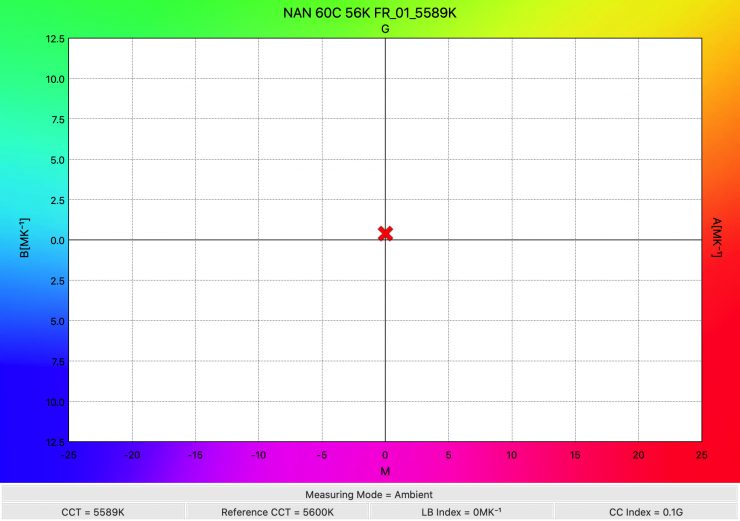
As far as Kelvin color temperature accuracy goes, it recorded an exceptionally good reading of 5589K which was a lot better than the reading it recorded when used open face or with its reflector.
Color Rendering
5600K (Reflector)
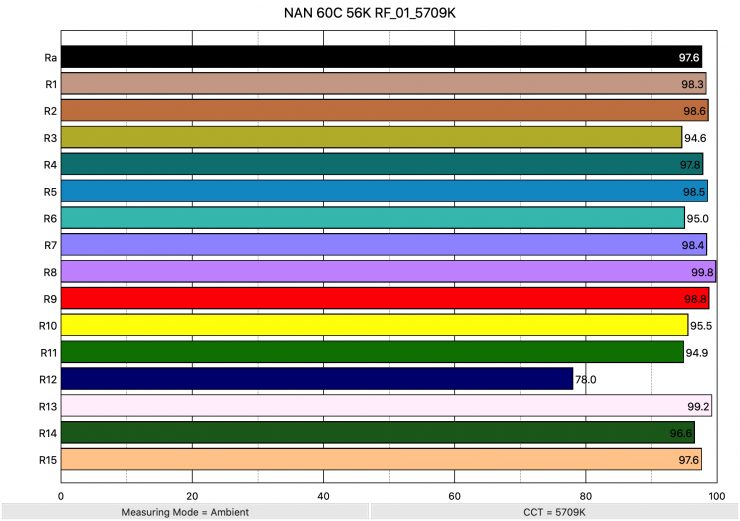
So now that we have seen how much output the Nanlite Forza 60C produces, how does it perform when it comes to replicating accurate colors? Above you can see that when the light was set at 5600K using the standard reflector it recorded an average CRI (R1-R8) of 97.6 and an extended CRI (R1-R15) of 96.10. For replicating accurate skin tones it recorded for R9 98.8 (red), 99.2 for R13 (closest to caucasian skin tones), and 97.6 for R15 (closest to Asian skin tones). These are excellent results, although the light struggles to produce R12 (Blue) with a score of just 78.0.
| CRI | EXTENDED CRI | R9 | R13 | R15 | |
| Forza 60C | 97.6 | 96.10 | 98.8 | 99.2 | 97.6 |
| 600c Pro | 96.8 | 95.14 | 95.8 | 99 | 98.5 |
As a color rendering accuracy comparison, the Aputure LS 600c Pro recorded an average CRI (R1-R8) of 96.8 and an extended CRI (R1-R15) of 95.14. Yes, these are completely different lights, but I just wanted to show you how the color rendering accuracy compared when creating a 5600K source from both an RGBWW and an RGBACL lights.
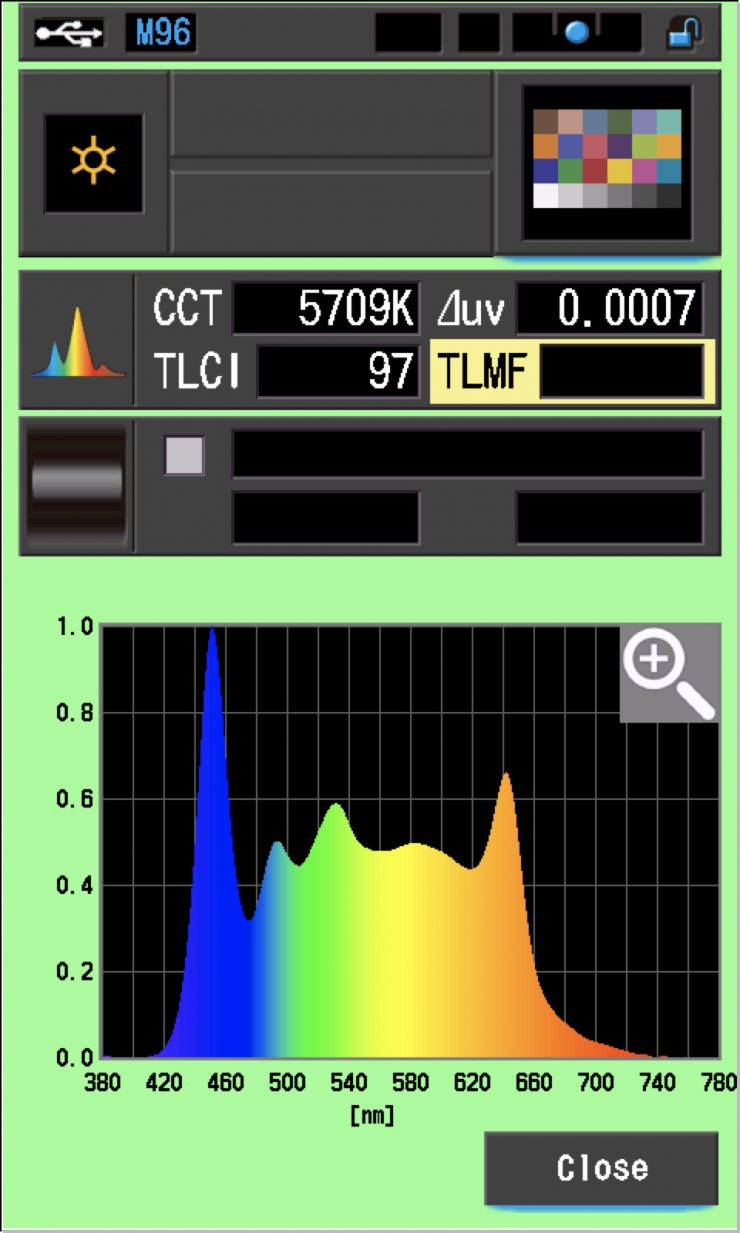
The Forza 60C, when set at 5600K, recorded a TLCI score of 97.
3200K (Reflector)
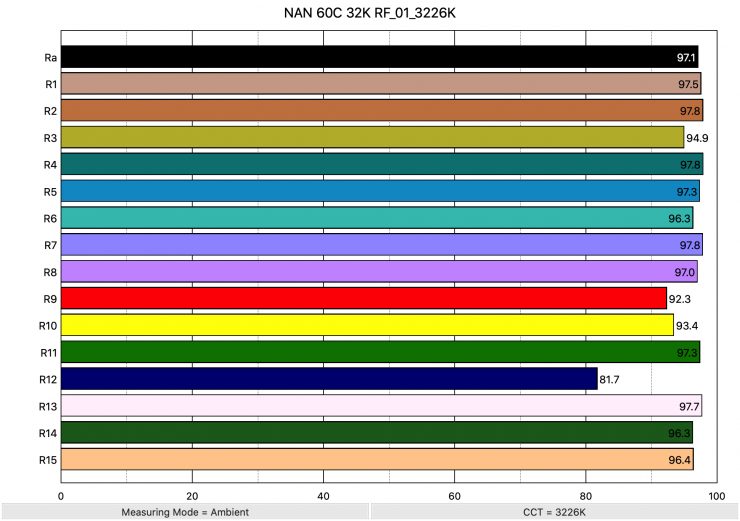
Above you can see the scores for when the light was used at 3200K. It recorded an average CRI (R1-R8) of 97.1 and an extended CRI (R1-R15) of 95.43. For replicating accurate skin tones it recorded 92.3 for R9 (red), 97.7 for R13 (closest to caucasian skin tones), and 96.4 for R15 (closest to Asian skin tones). These were good results, but not quite as good as when the light is used at 5600K.
| CRI | EXTENDED CRI | R9 | R13 | R15 | |
| Forza 60C | 95.43 | 96.10 | 92.3 | 97.7 | 96.4 |
| 600c Pro | 98.2 | 96.78 | 91.5 | 99.1 | 99 |
As a color rendering accuracy comparison, the Aputure 600c Pro recorded an average CRI (R1-R8) of 98.2 and an extended CRI (R1-R15) of 96.78. Just to reiterate again, these are completely different lights, but I just wanted to show you how the color rendering accuracy compared when creating a 3200K source from both an RGBWW and an RGBACL light.
These results were slightly better than when the light is used at 5600K.
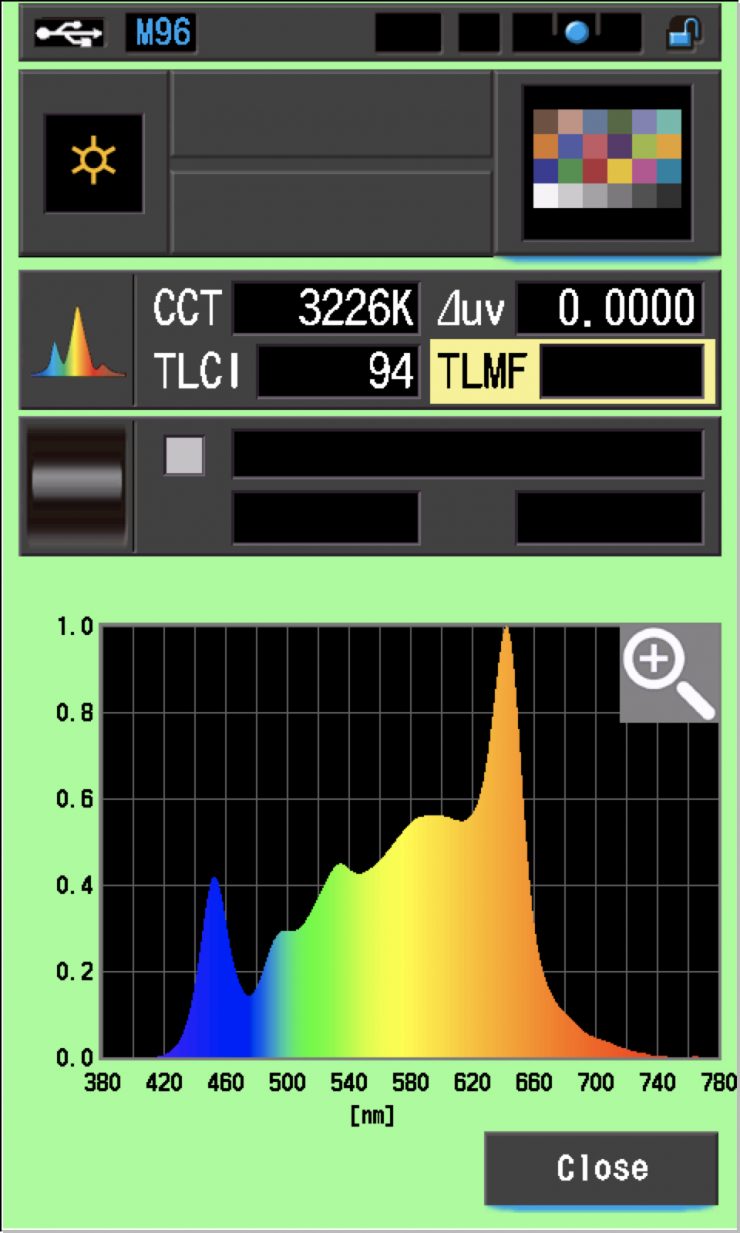
The light, when set at 3200K, recorded a TLCI score of 94, which was a little low.
CC Index & ⊿uv
The CC Index displays the CC correction value and whether any magenta or green need to be added or subtracted. 1 CC corresponds to 035 Kodak CC values or 1/8 Rosco filter values. Any reading less than +1.00 or -1.00 and you’re probably not going to need to make any kind of adjustment. The ⊿uv is the value to show how much this light is away from being an ideal light source (black body radiation = incandescent lamp). As with the CC Index you want this number to theoretically be zero. Kelvin is not a linear value, so we need to convert from Kelvin to MK-1 to compare the values of color temperature. To calculate from Kelvin to Mired is MK-1= 1*1000000/Kelvin. While this may sound confusing, it is the only way of measuring if the Kelvin shift is significant enough to warrant having to use a filter for correction. Below are the results for the Nanlite Forza 60C:
Kelvin Vs MK-1
| Kelvin | Difference in K | MK-1 | Difference in MK-1 | |
| SET VALUE | 2500K | 0 | 400 | 0 |
| ACTUAL READING | 2470K | 30 | 404.85 | -4.85 MK-1 |
| SET VALUE | 3200K | 0 | 312.5 | 0 |
| ACTUAL READING | 3226K | 26 | 309.98 | 2.52 MK-1 |
| SET VALUE | 4500K | 0 | 222.22 | 0 |
| ACTUAL READING | 4611K | 111 | 216.87 | 5.35 MK-1 |
| SET VALUE | 5600K | 0 | 178.57 | 0 |
| ACTUAL READING | 5709K | 109 | 175.16 | 3.41 MK-1 |
| SET VALUE | 6500K | 0 | 153.84 | 0 |
| ACTUAL READING | 6612K | 112 | 151.24 | 2.60 MK-1 |
| SET VALUE | 8000K | 0 | 125 | 0 |
| ACTUAL READING | 8078K | 78 | 123.79 | 1.21 MK-1 |
| SET VALUE | 10000K | 0 | 100 | 0 |
| ACTUAL READING | 9952K | 48 | 100.48 | -0.48 MK-1 |
These figures might look confusing, but what it tells me is that the light is very Kelvin color accurate at all temperatures. Any MK-1 score that is under -9/9 means you wouldn’t have to use any color correction gels. The MK-1 scores for this light were very good. Any MK-1 score that is under -6/6 is a very good result.
CC INDEX & ⊿uv
| CC INDEX | ⊿uv | |
| 2500K | 0.1G | 0.0005 |
| 3200K | 0 | 0.0000 |
| 4500K | 0 | -0.0004 |
| 5600K | 0 | 0.0007 |
| 6500K | 0.2G | 0.0005 |
| 8000K | 0.5G | 0.0005 |
| 10000K | 0.8G | 0.0006 |
Again, these were excellent results across the board., although the light does start to push a little green once you get above 5600K, however, that is nothing you couldn’t dial out using the +/- G/M.
The ⊿uv at 3200K was a perfect 0.0000. There have only been a handful of lights that I have ever reviewed that have had a perfect ⊿uv score at any Kelvin color temperature setting. The consistency of the ⊿uv scores across the Kelvin color temperature range that I tested was exceptionally good.
TM-30
TM-30 is a relatively new color rendering standard that was developed to deal with the limitations of CRI. TM-30 looks at 99 individual colors. These 99 colors are categorized into seven groups: nature, skin color, textiles, paints, plastics, printed material, and color systems.
TM-30 scores go from 0 – 100. The higher the score, the more accurate a light is at producing colors. Any TM-30 Rf score in the ’90s is considered to be good. What is interesting and something that you need to be very aware of is that two separate light sources with the exact same CRI scores can render colors very differently. A light with a high CRI rating could have a low TM-30 score. Conversely, a light with a good TM-30 score could have a bad CRI score.
Now, there are two measurements associated with TM-30, Rf and Rg.
Rf (Color Fidelity)
Rg (Color Gamut)
With Rf value, ideally, you want a score in the 90’s.
With Rg value, a score below 100 indicates that the light source renders colors with less saturation than the reference source. So ideally you want this score to be above 100.
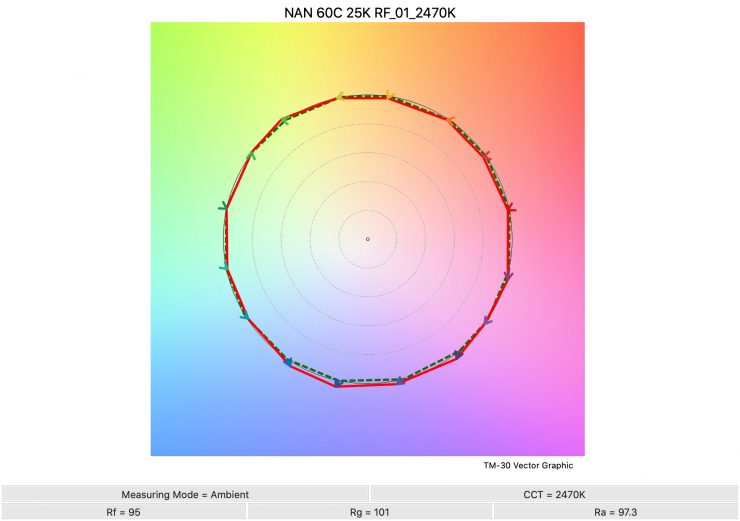
2500K 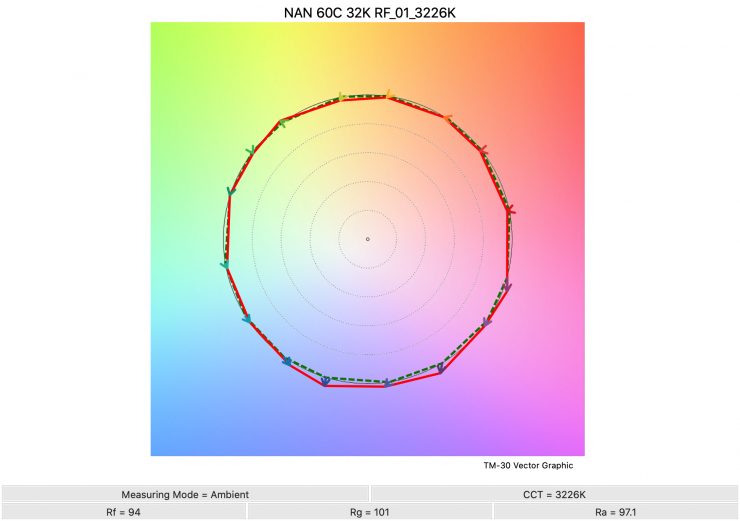
3200K 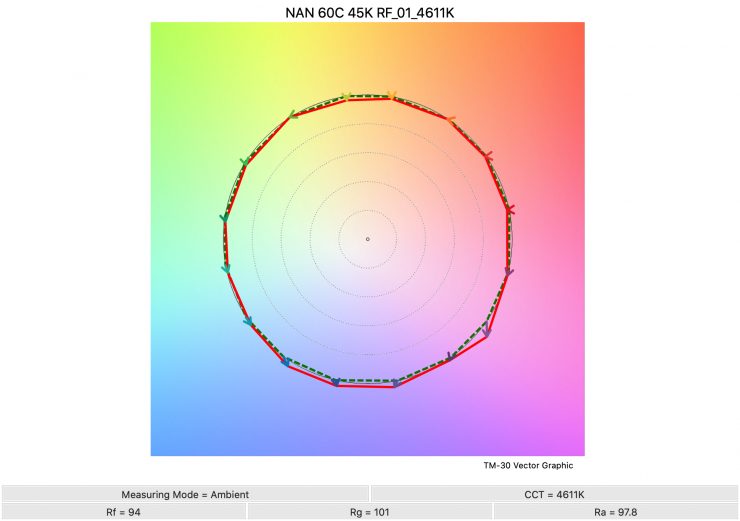
4500K 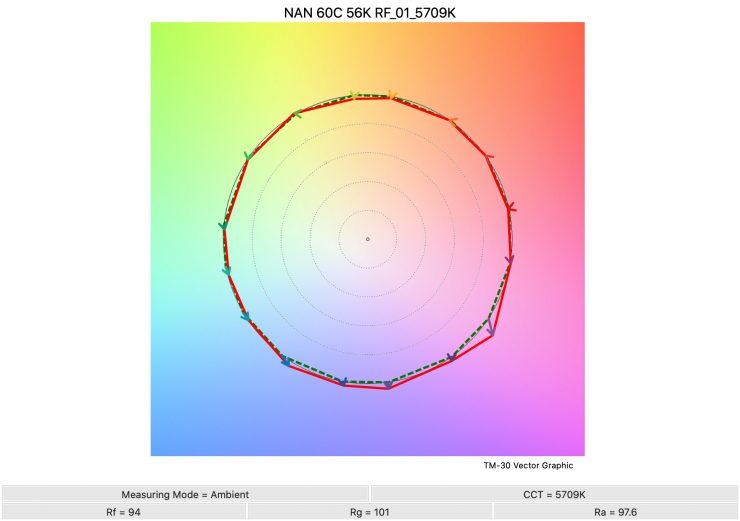
5600K 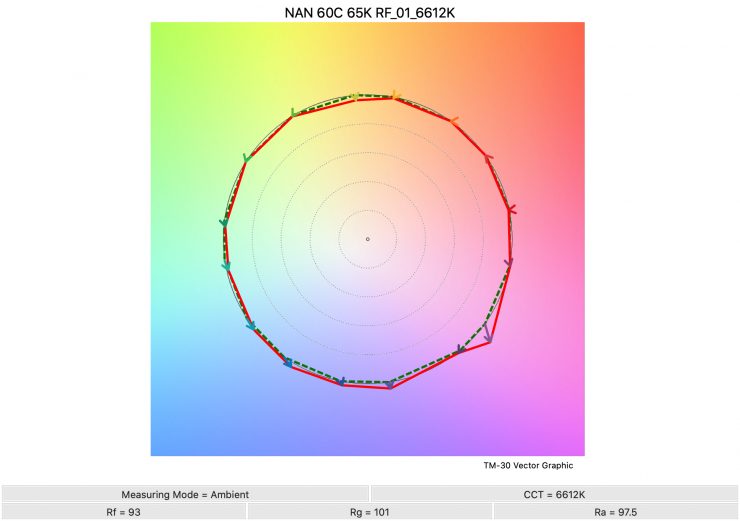
6500K 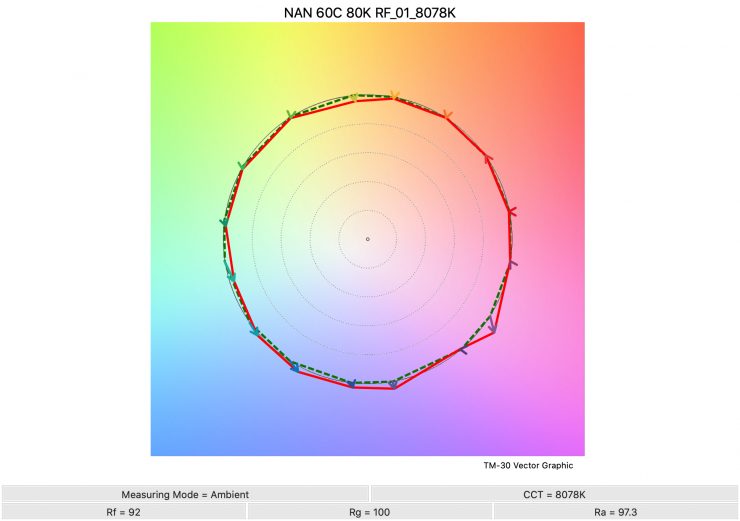
8000K 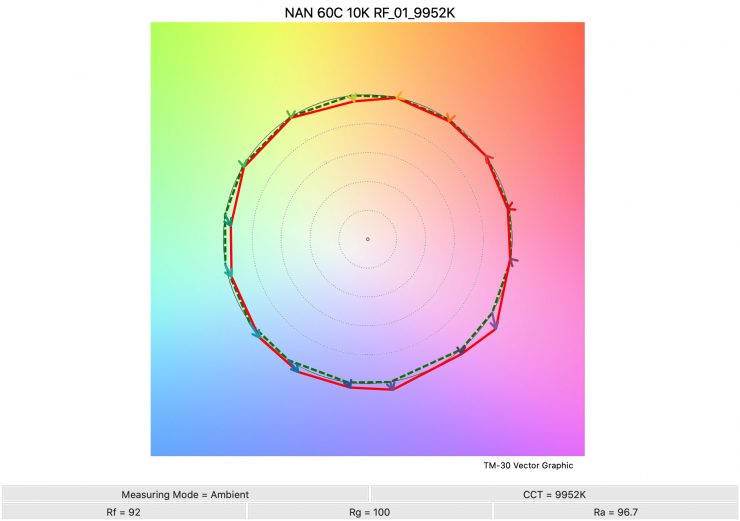
10000K
Above you can see the scores for the Forza 60C at various Kelvin color temperatures. Below I have listed the figures as well.
Here are the results:
| Rf | Rg | |
| 2500K | 95 | 101 |
| 3200K | 94 | 101 |
| 4500K | 94 | 101 |
| 5600K | 94 | 101 |
| 6500K | 93 | 101 |
| 8000K | 92 | 100 |
| 10000K | 92 | 100 |
The TM-30 scores are all excellent and it shows me that the light is pretty consistent at replicating accurate colors with full saturation. The consistency of their scores was very impressive. Again the benefit of using RGBWACL is clear from these tests. Most RGBWW lights values for Rg fall below 100 once the light hits 8000K and above.
SSI
SSI (Spectral Similarity Index) was developed by the Sci-Tech Council of the Academy. SSI gives me the ability to set any light as a standard, or use predefined standards (such as CIE D55), and then give other lights an SSI score based upon how well they will match standards such as CIE D55. This way I can measure spectral response and compare it directly against an ideal light source. This is actually a much better test than recording CRI scores.
3200K
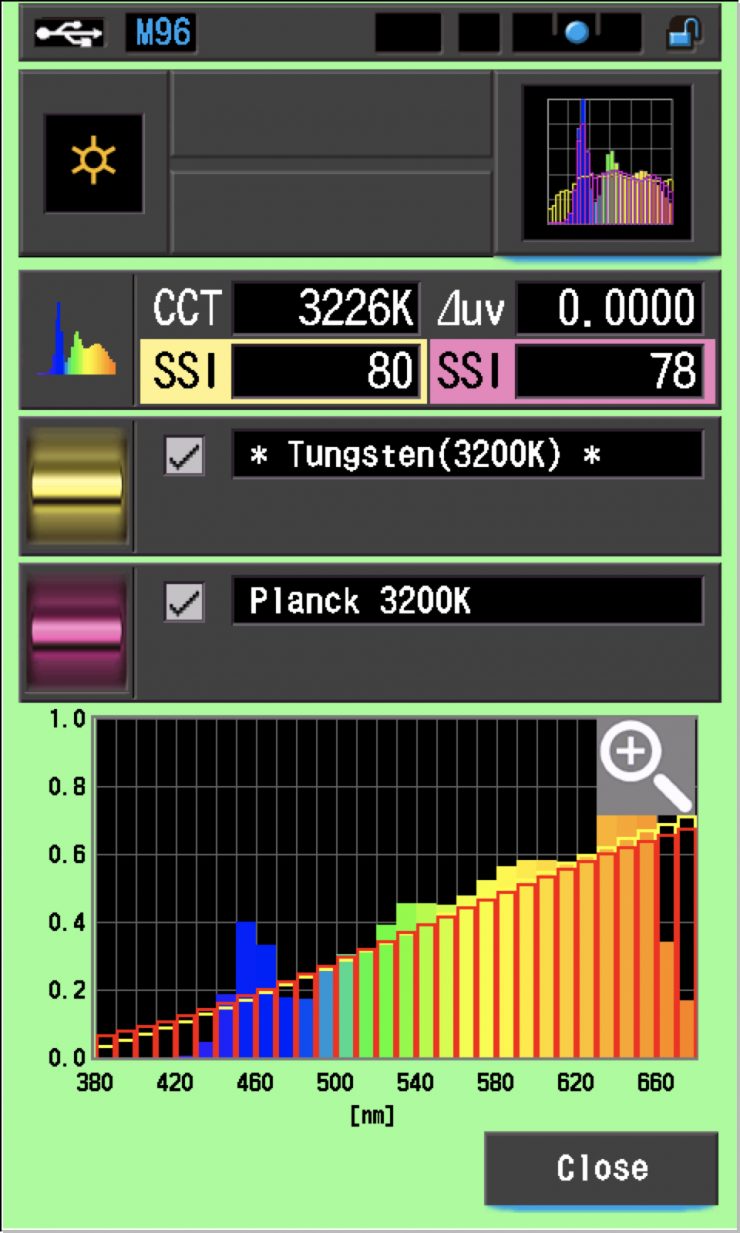
In this graph, the red bars indicate a perfect Planck 3200K source. The gold bars indicate a perfect 3200K Tungsten source. This lets us compare how close to a perfect 3200K lighting source the Forza 60C is. Any SSI score in the high 70’s, low ’80s is very good for a 3200K LED light. The results for the Forza 60C were reasonably good when used at 3200K. As you can see, LED lights have a hard time replicating colors below about 450nm.
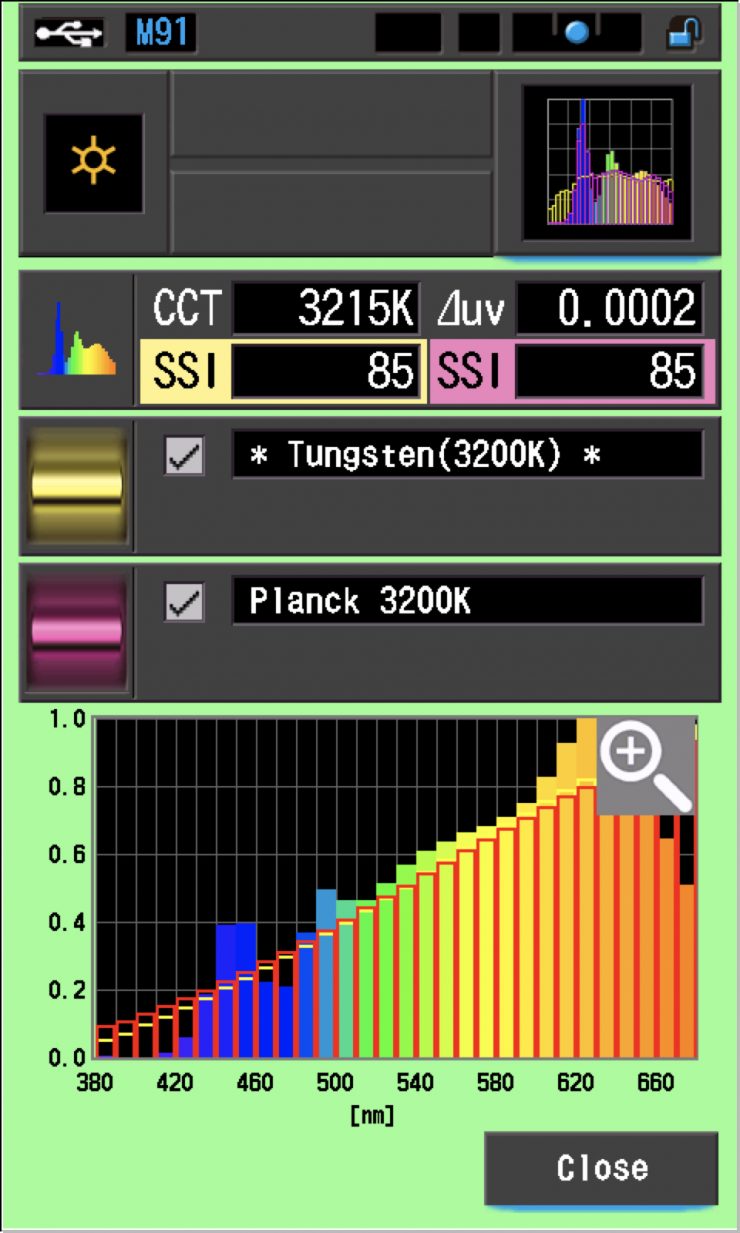
As a comparison, above is the results for the ARRI Orbiter. I have included the ARRI Orbiter because it recorded the highest SSI scores I have ever seen.
5600K
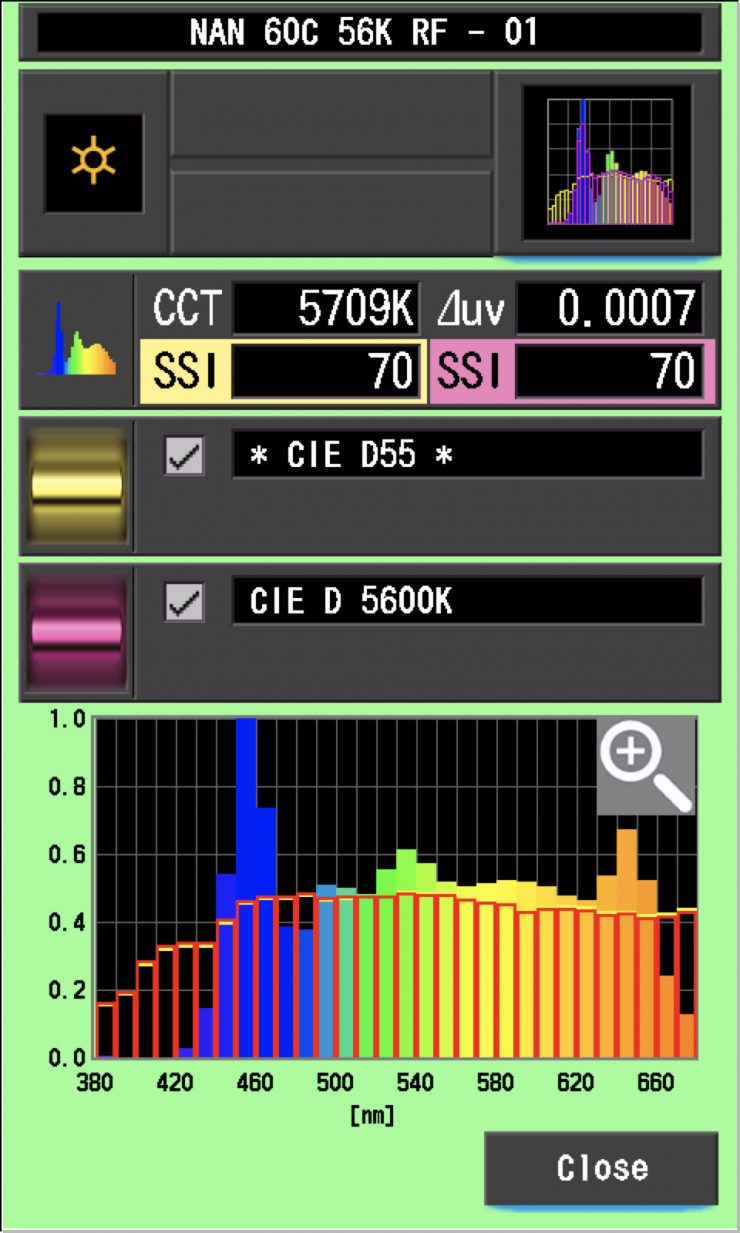
In the graph above the gold bars indicate a perfect CIE D55 source. The red bars indicate a perfect CIE D 5600K source. This lets us compare how close to a perfect 5600K lighting source the Forza 60C is. A score in the low 70’s is typical for a 5600K LED source.
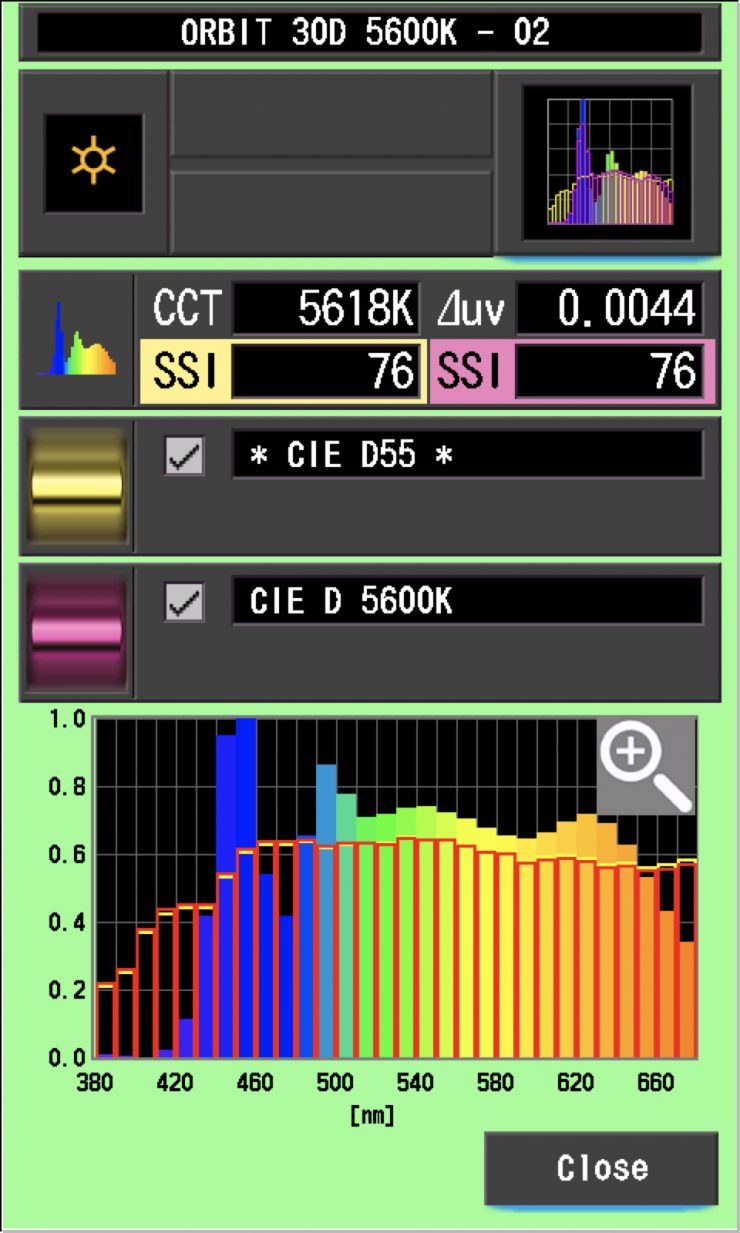
As an SSI comparison, above is the results for the ARRI Orbiter.
The main reason we want to record SSI scores is so we can see how well they match with other lights. As an example, I wanted to see how well the Forza 60C matched the Aputure LS 600c Pro and Nanlite Forza 700B. Below you can see the results.
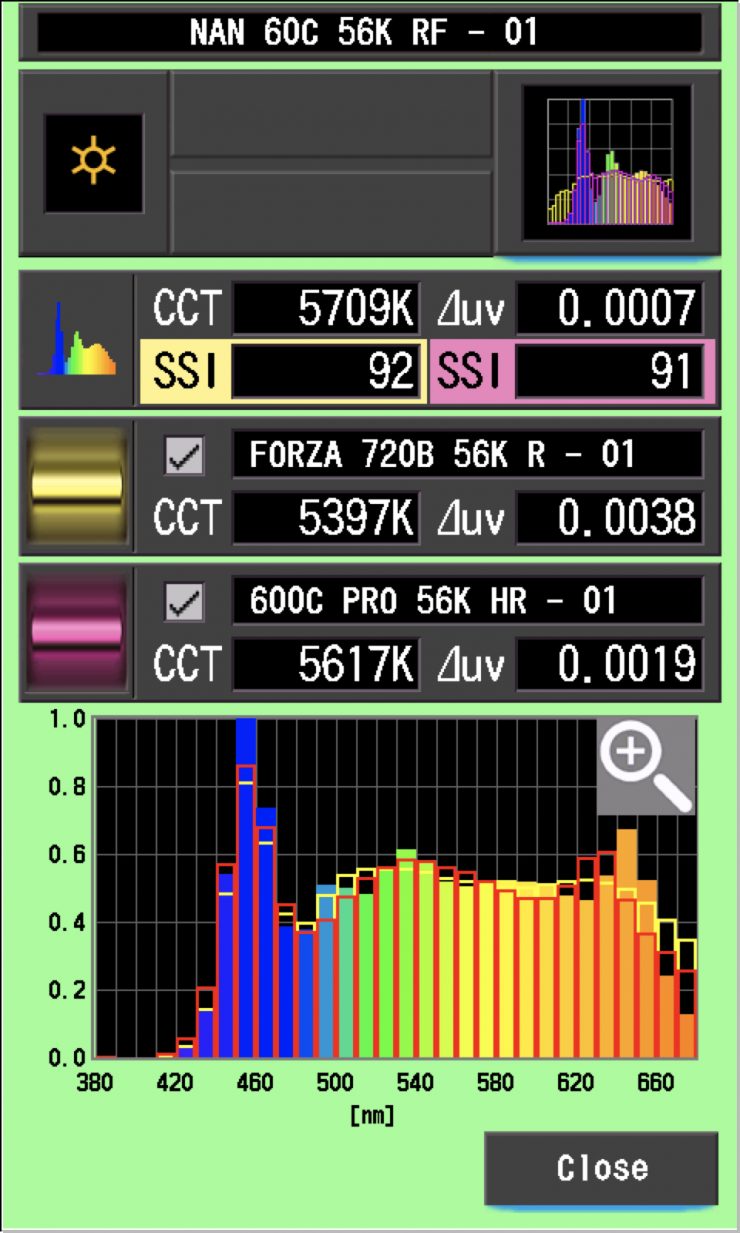
As you can see neither lights are not a perfect match to the Nanlite Forza 60C, but they are reasonably close. You could fine-tune the lights to try and get them to match more closely. In saying that, a score in the high ’80s and low 90s is still reasonably good and the Forza 60C would work well with both of these lights.
As another test, I thought I would compare the Aputure LS 600c Pro and ARRI Orbiter against the Nanlite Forza 60C at 3200K. Below you can see the results.
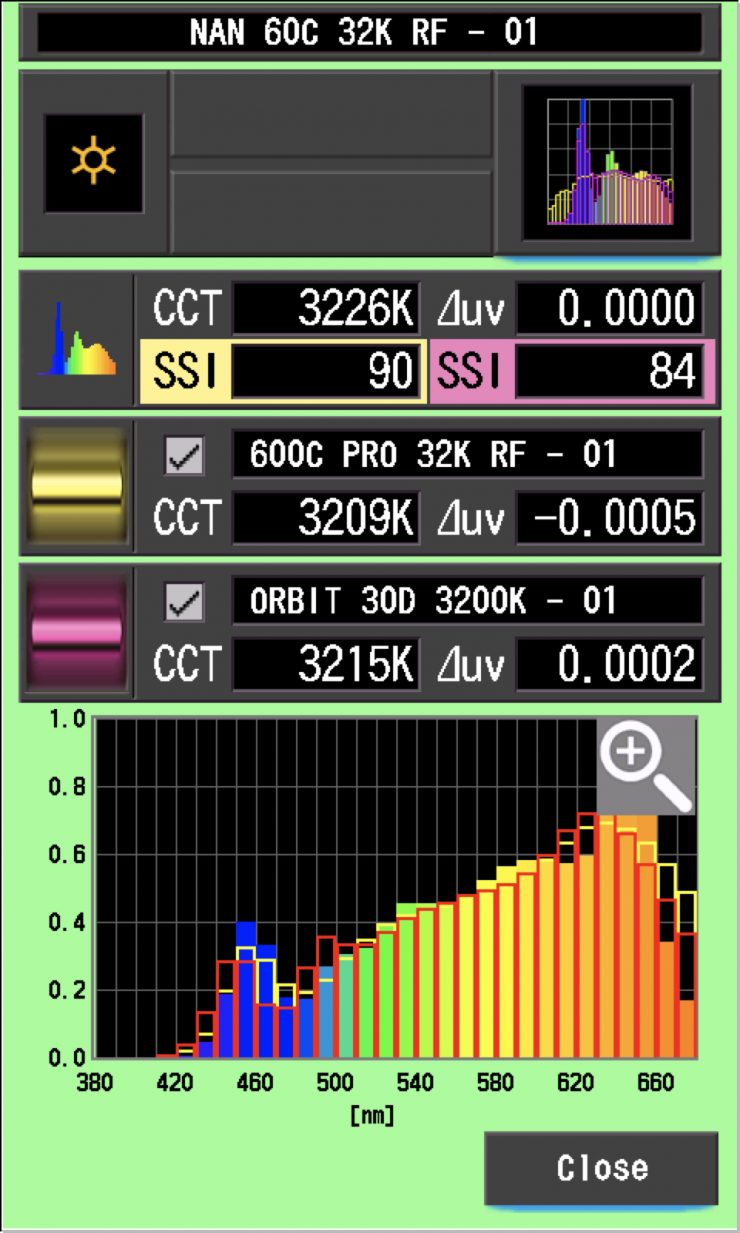
As you can see, the Forza 60C is still a reasonably close match to the Aputure 600c Pro, but not with the ARRI Orbiter. Very few lights from different manufacturers are ever going to be an exact match, but ideally, in a lot of scenarios, you want to use lights that match as closely as possible.
SSI tests are a great way of telling you what lights you own or use will work well together.
Spectral Distribution
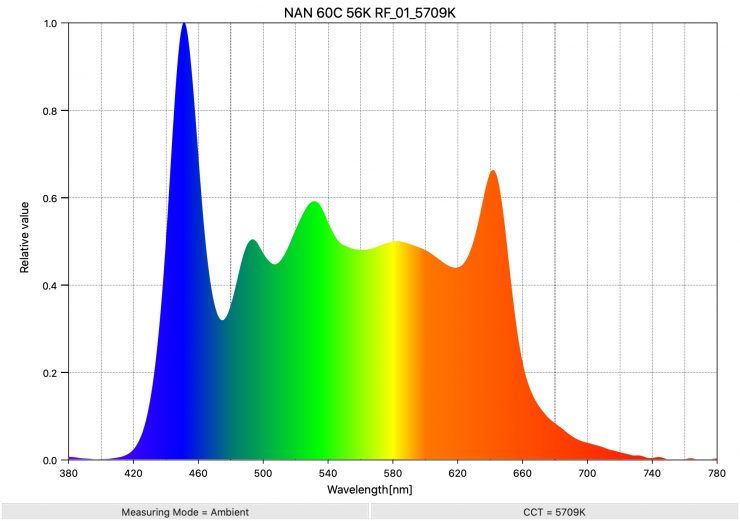
Above you can see the spectral distribution of the Forza 60c when it is set at 5600K. The spectral distribution isn’t overly full, and there are quite a few spikes.
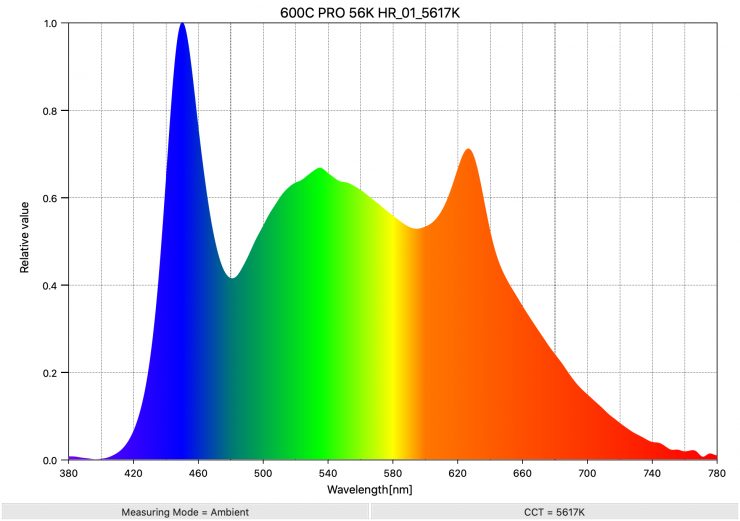
As a comparison, above you can see the spectral distribution of the Aputure 600c Pro. It is considerably fuller and it doesn’t have as many spikes.
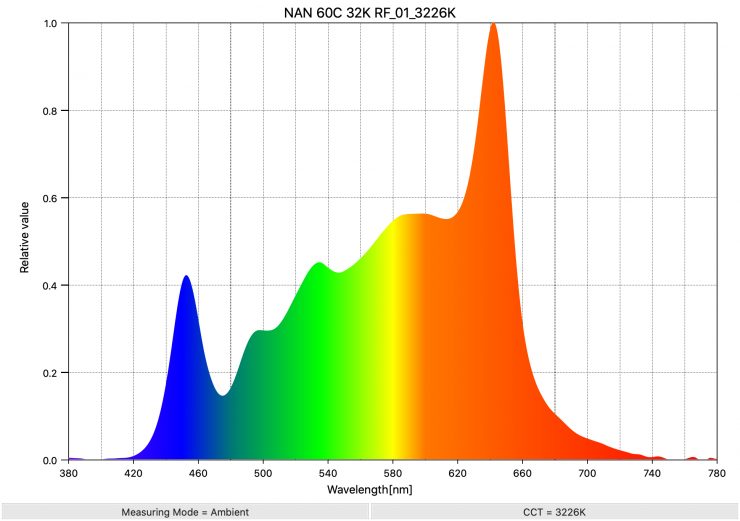
Above you can see the spectral distribution of the Forza 60C when it is set at 3200K. Again, the spectral distribution of the light isn’t that great and it isn’t overly full.
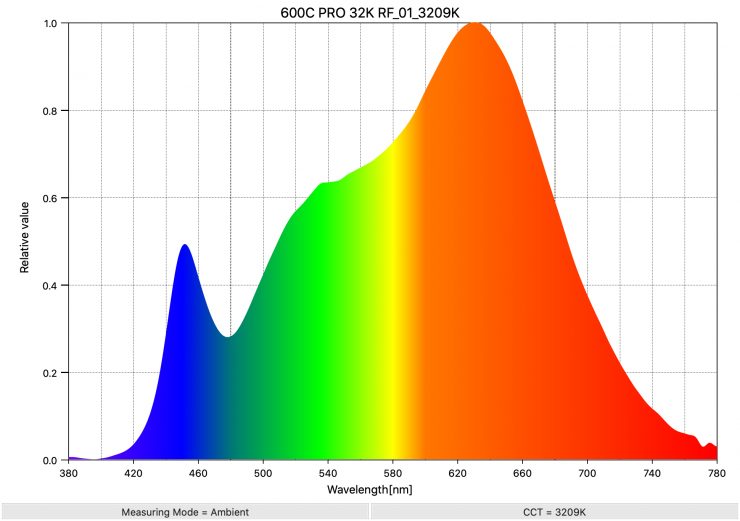
As a comparison, above you can see the spectral distribution of the Aputure LS 600c Pro.
Real-World Performance & Quality of Light
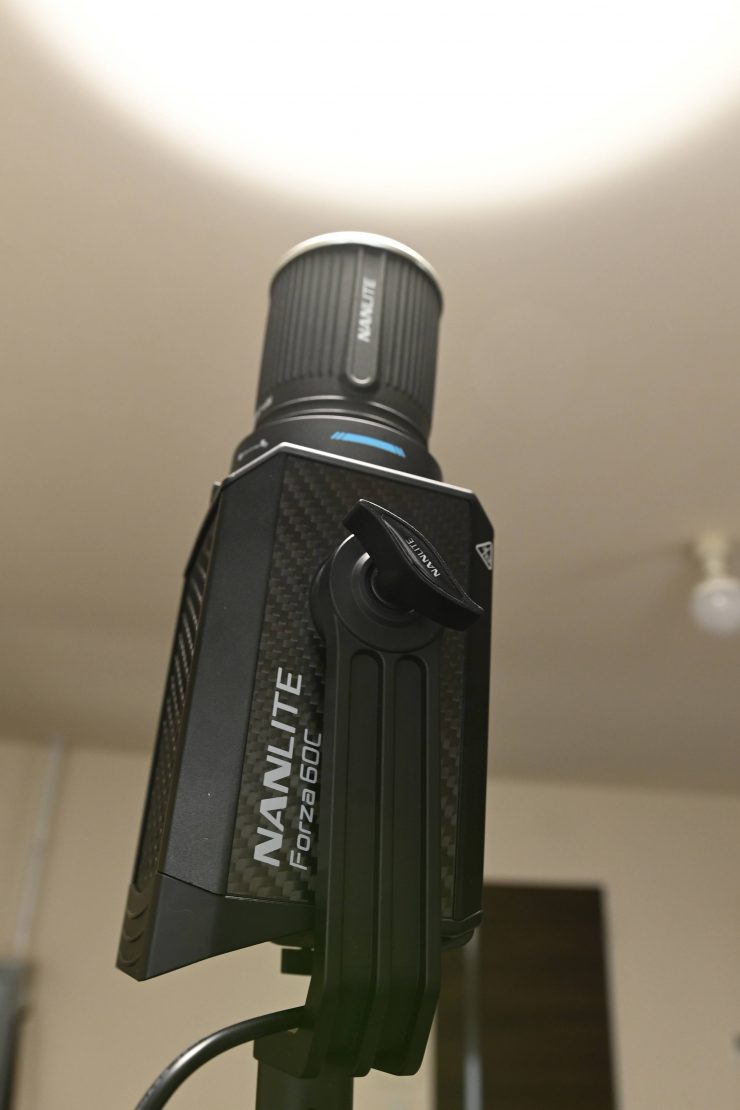
As I always say, photometric scores only tell you part of the story. So let’s how the Forza 60C performs in the real world.
The photometric results can only give me scientific data and it is much more important for me to see how the light looks and performs.
The Forza 60C produces great results and most importantly it is easy to use, and easy to power. With the optional lighting modifiers like the Fresnel and Projection Attachment, you can create a very versatile lighting solution that doesn’t take up a ton of space. In saying that, I am still not sure why lighting companies don’t make bags that can hold the light and a lot of the optional lighting modifiers. There is really no need to be carrying around 3-4 separate bags when you could put everything into one.
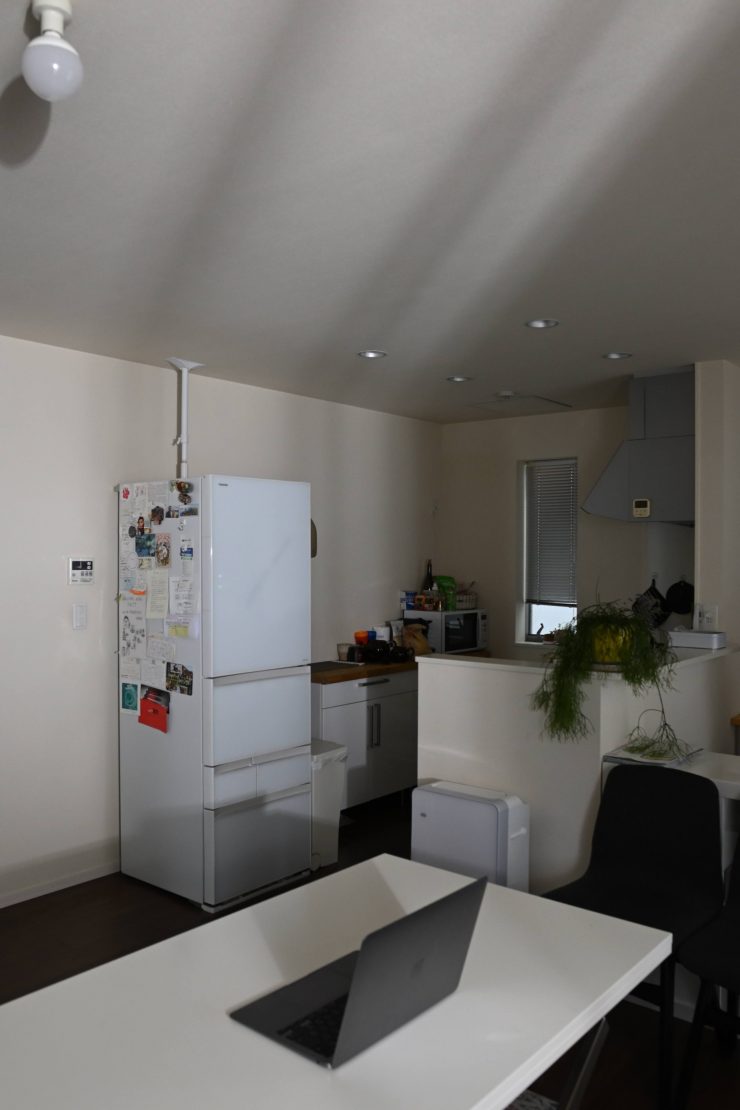
Light with relector 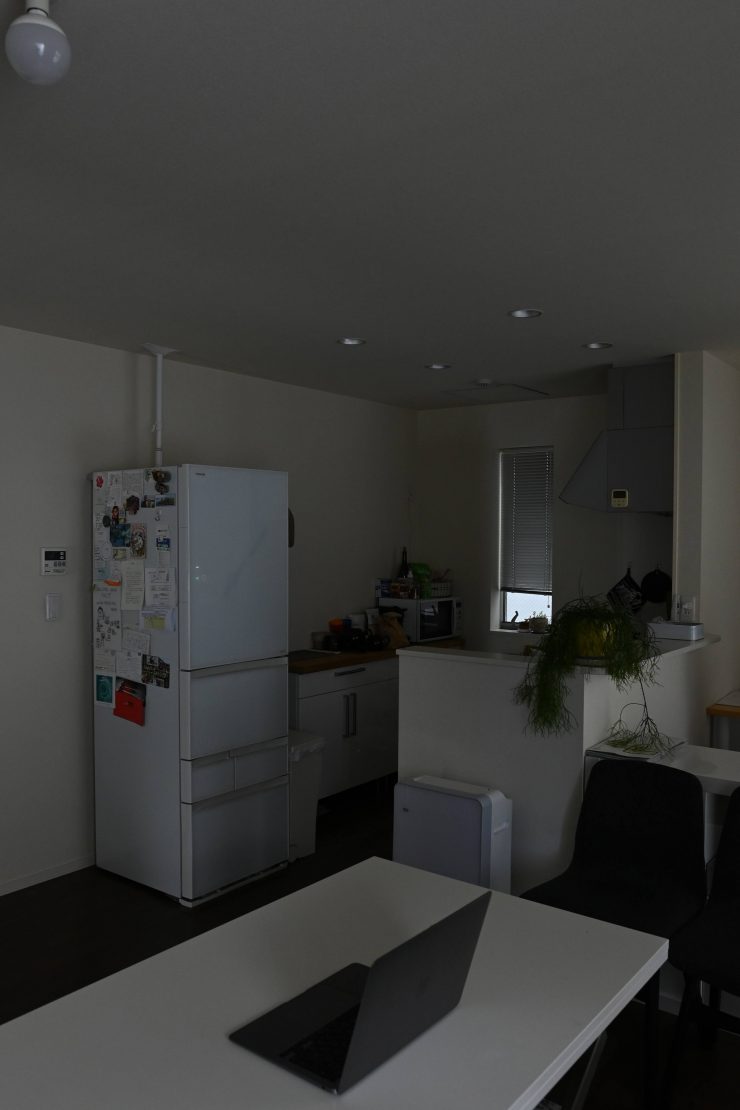
Light off
Despite its small size and low power draw, this light packs a punch. It has a lot of output and this allows it to be used for a lot of lighting applications. Above you can see how much output the light has when used with its reflector and placed outside and pushed through a sheer curtain. For a small-sized, lower power draw fixture it certainly packs a punch.
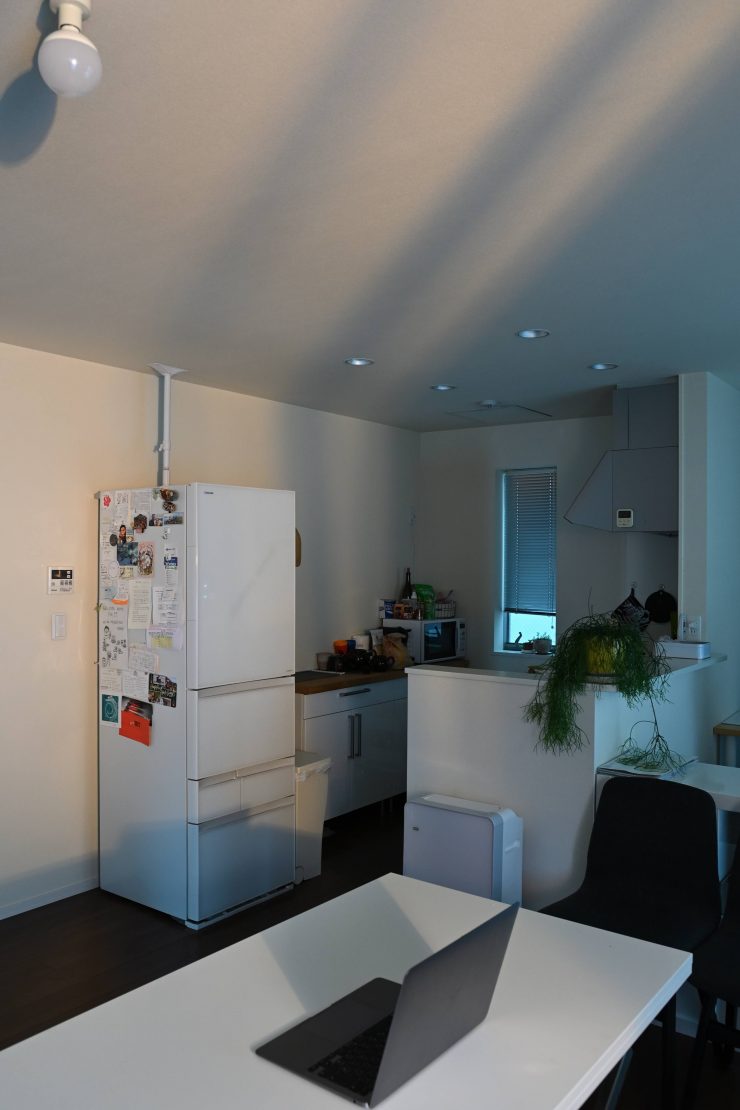
With reflector 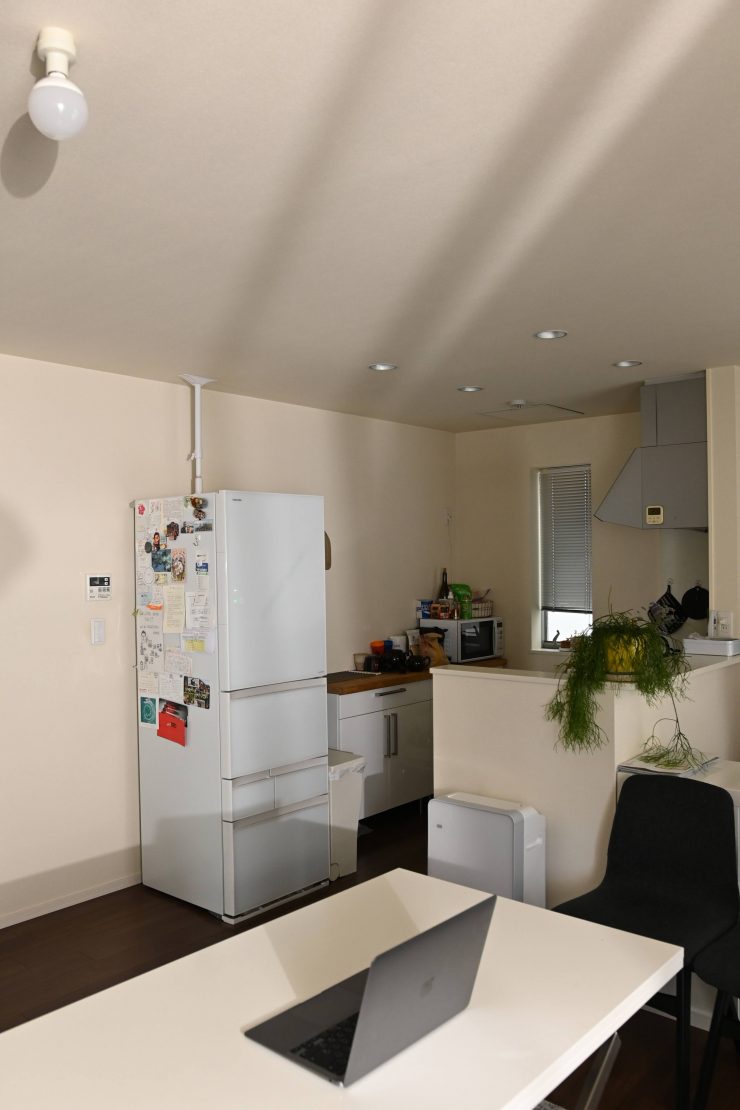
With reflector 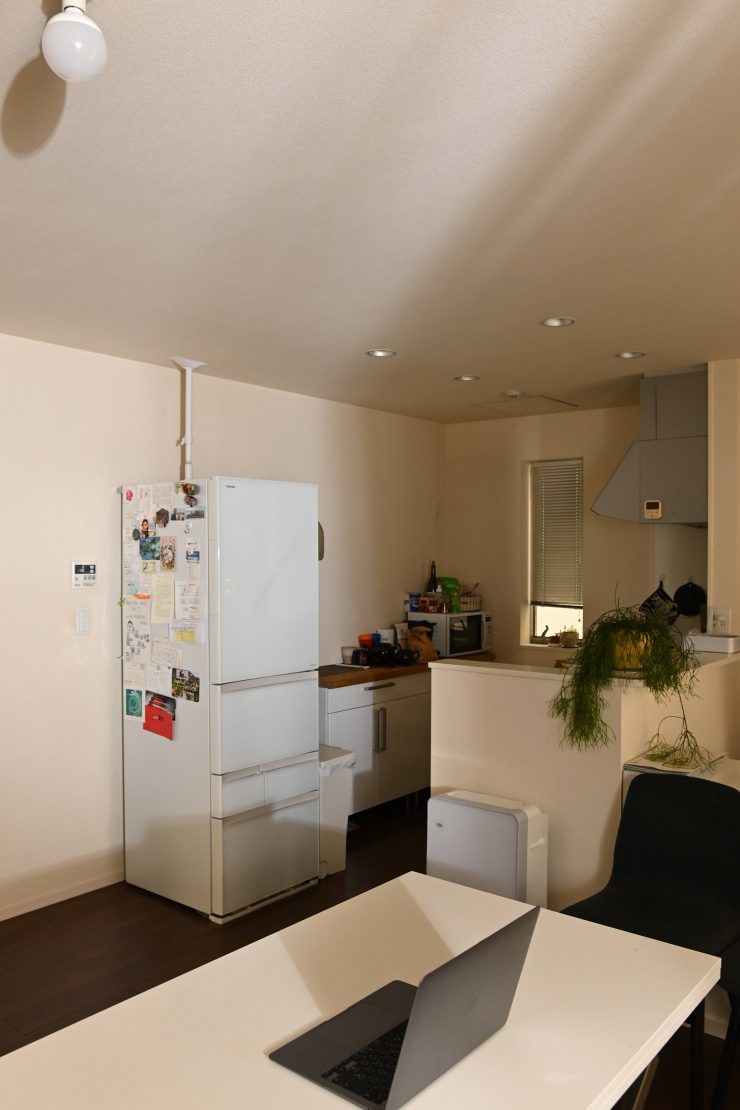
With relector 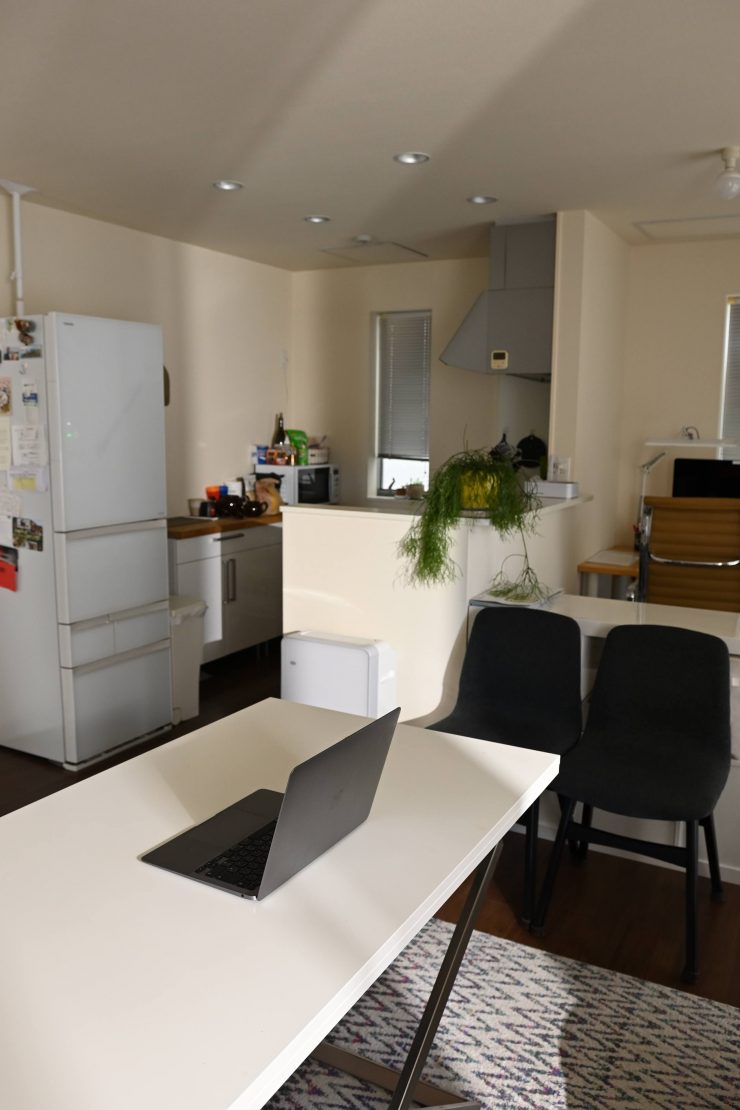
With reflector 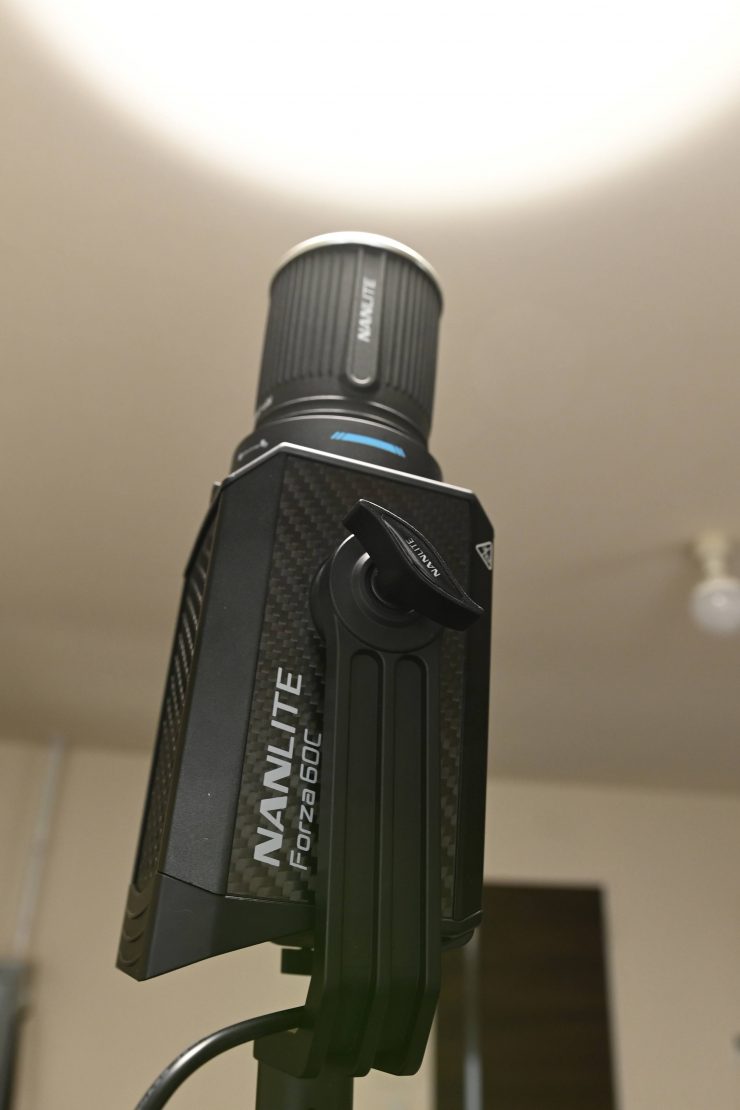
With reflector being punched into the ceiling 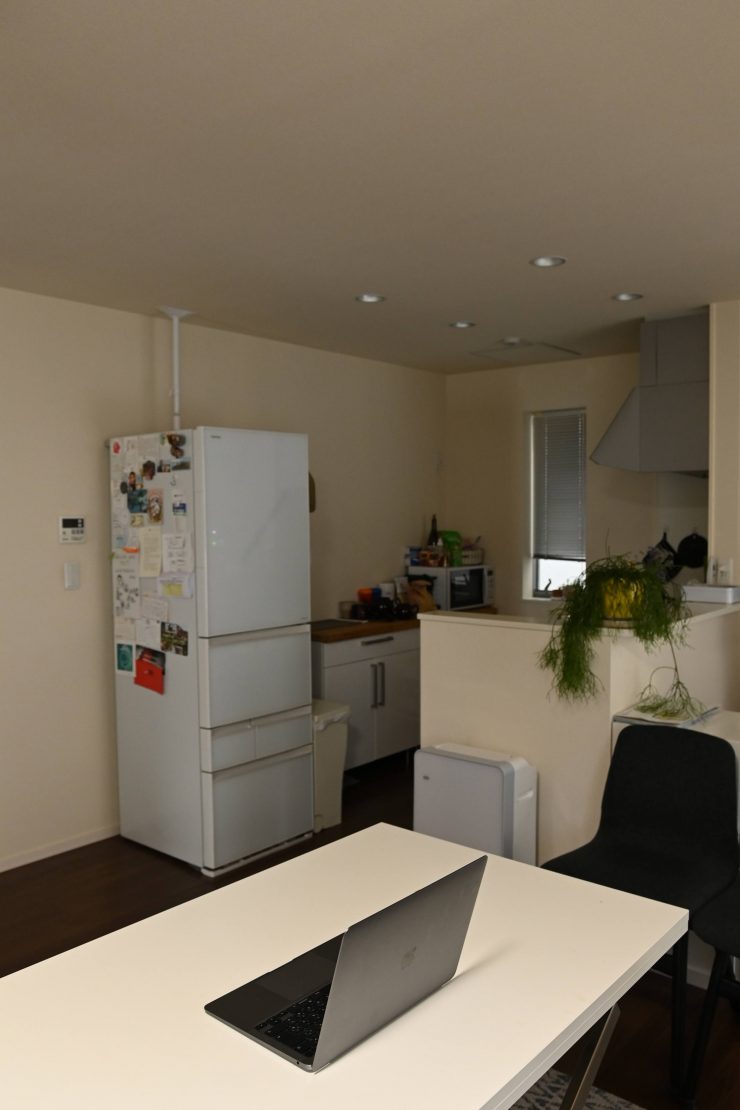
With reflector being punched into the ceiling 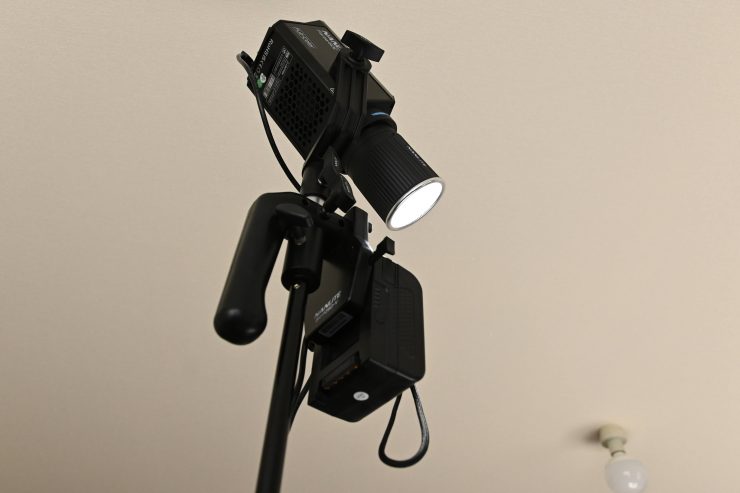
Light with reflector being punched into the table 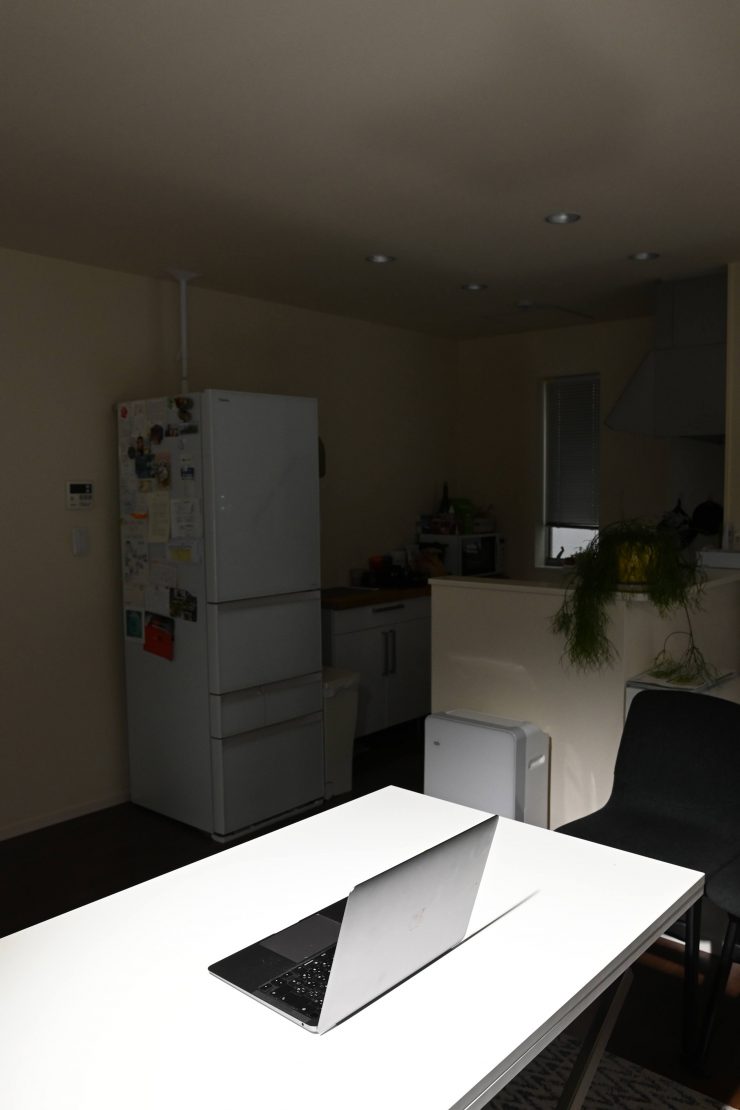
Light with reflector being punched into the table 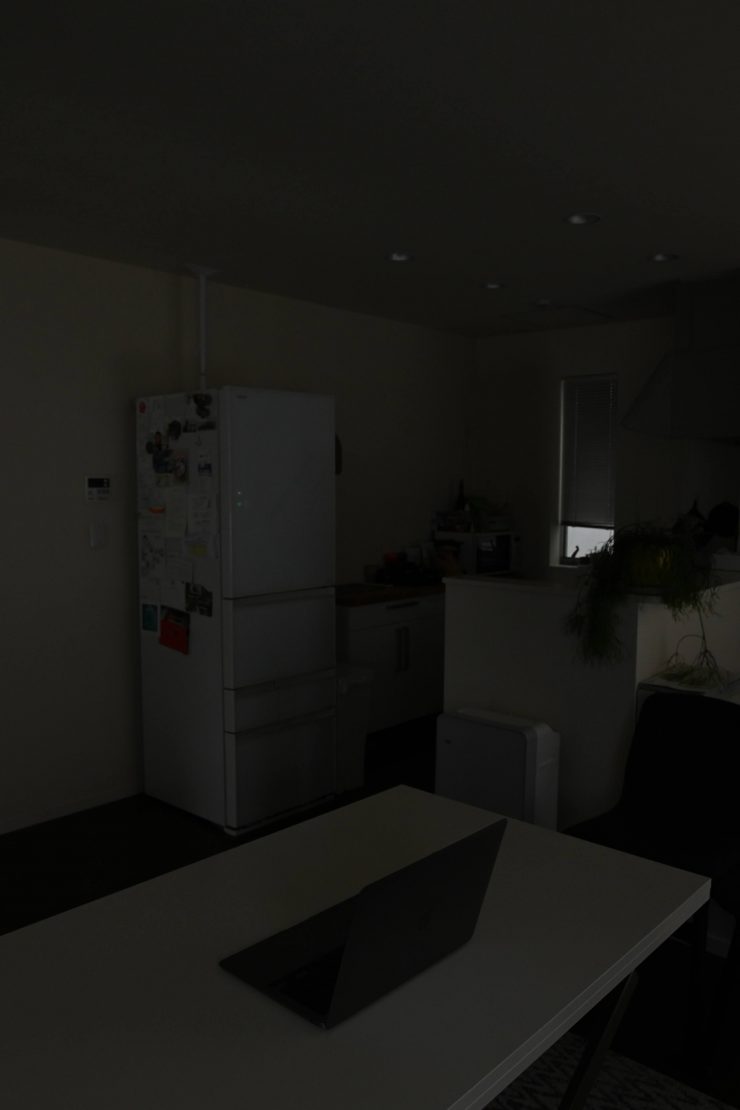
Light off
Above you can see some photos I took when placing the light outside and punching it through a sheer curtain into a room using the included reflector. As the light is RGBCAL you can create numerous different lighting looks.
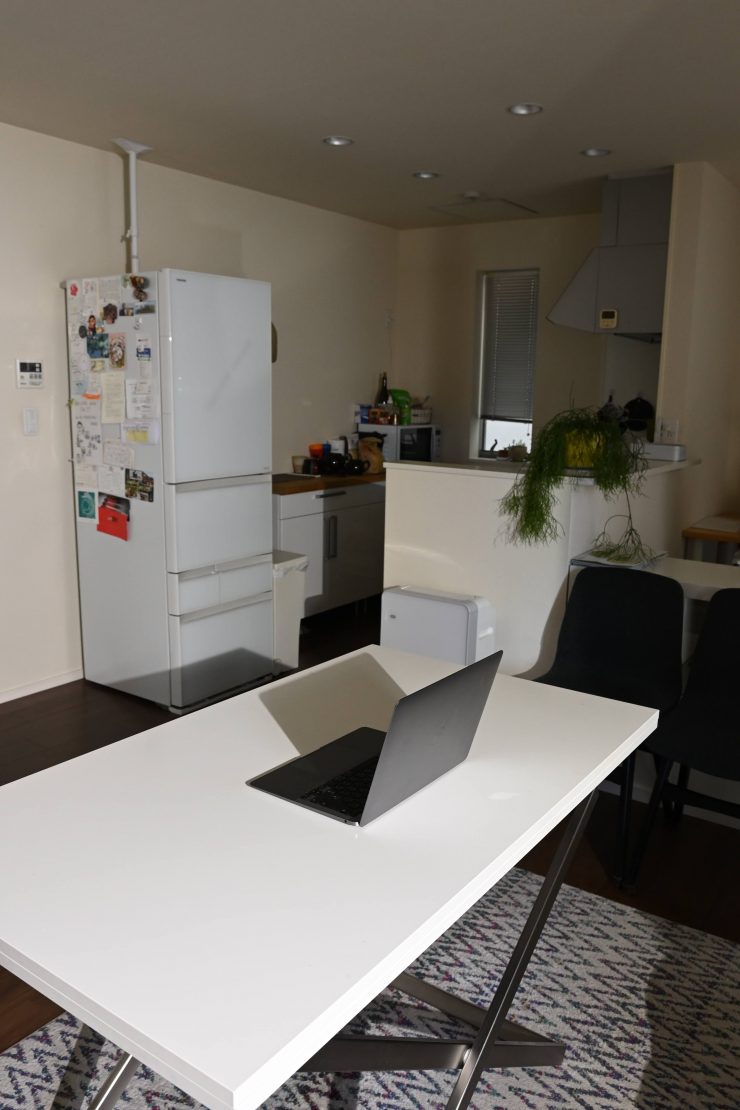
Open face 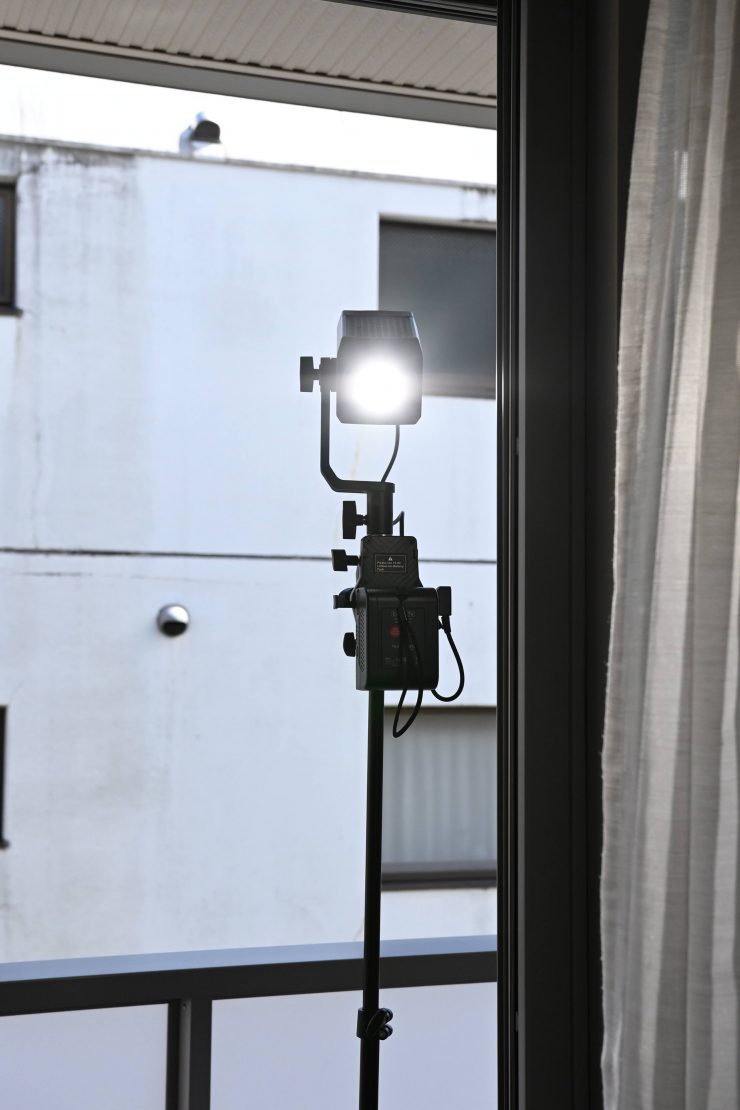
Position of the light 
Shadows 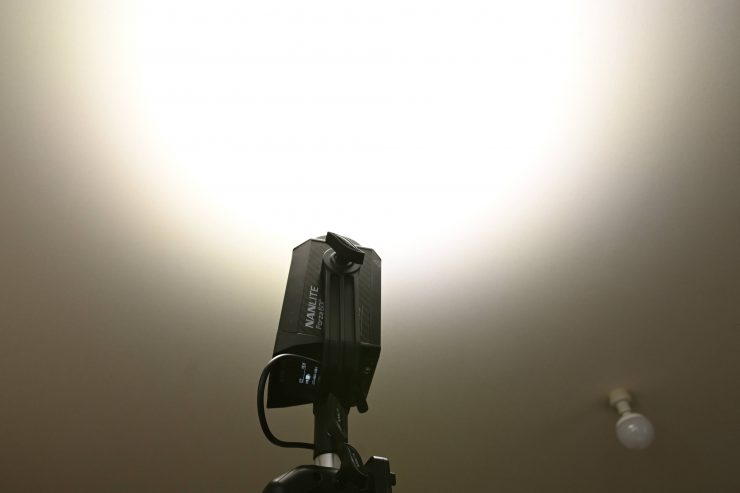
Punched into the ceiling 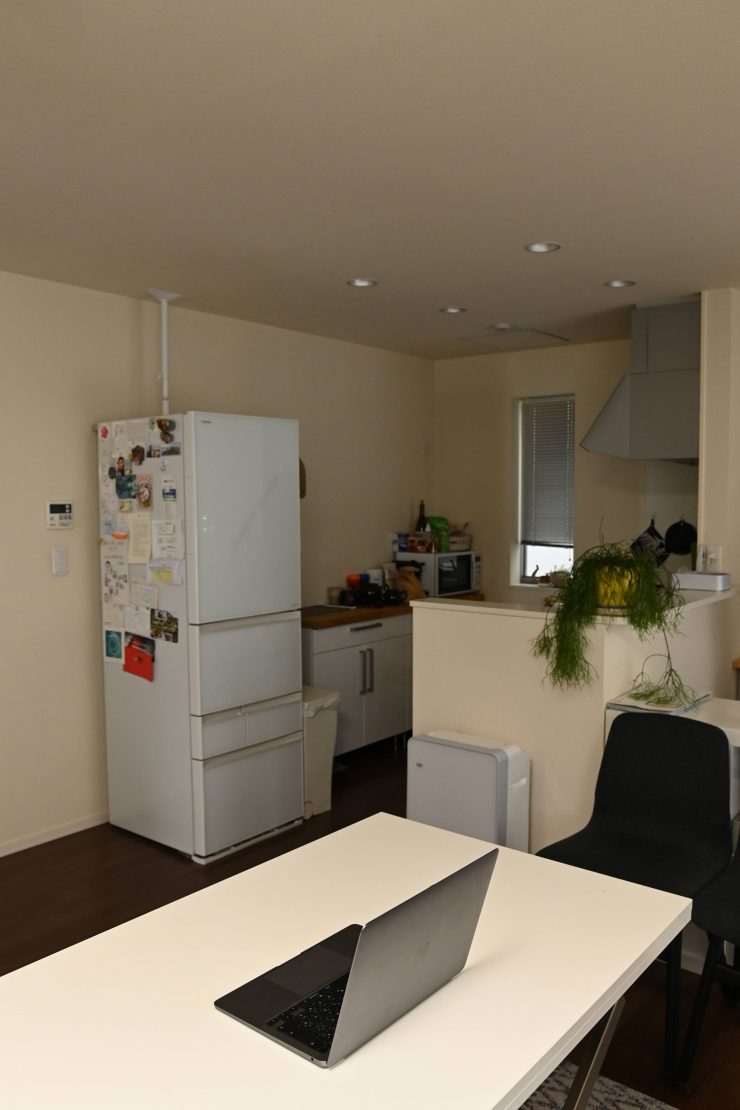
Light punched into the ceiling 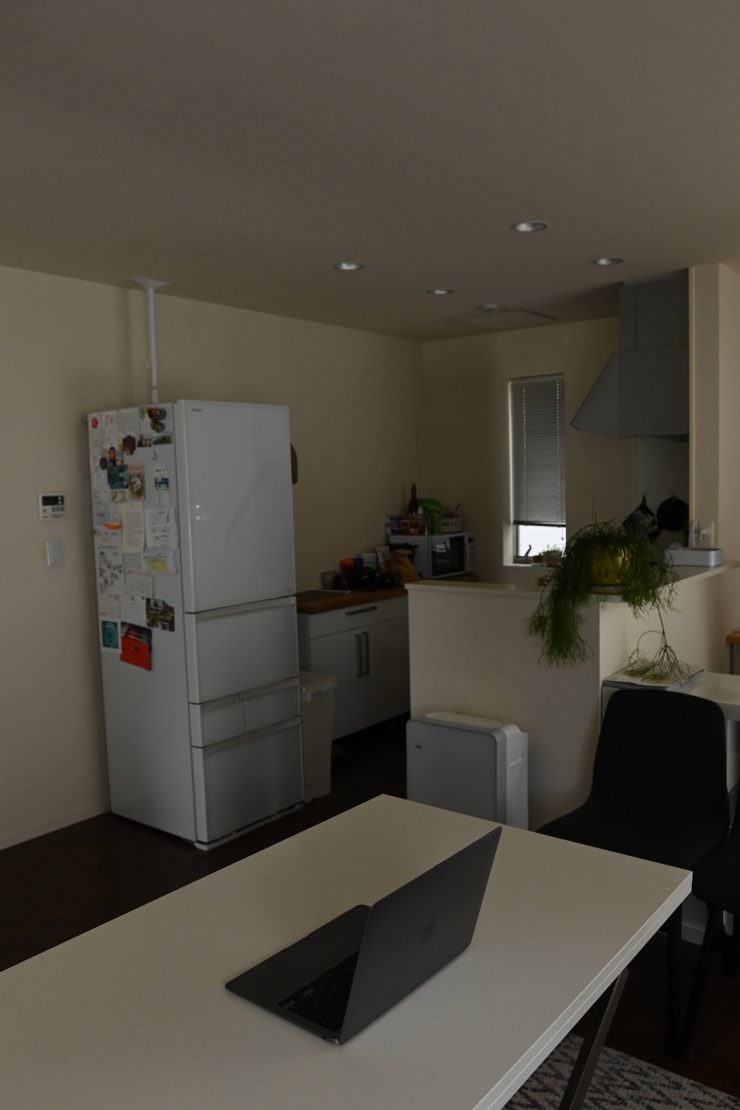
Light off
Above you can see some more example shots of the light being used open face.
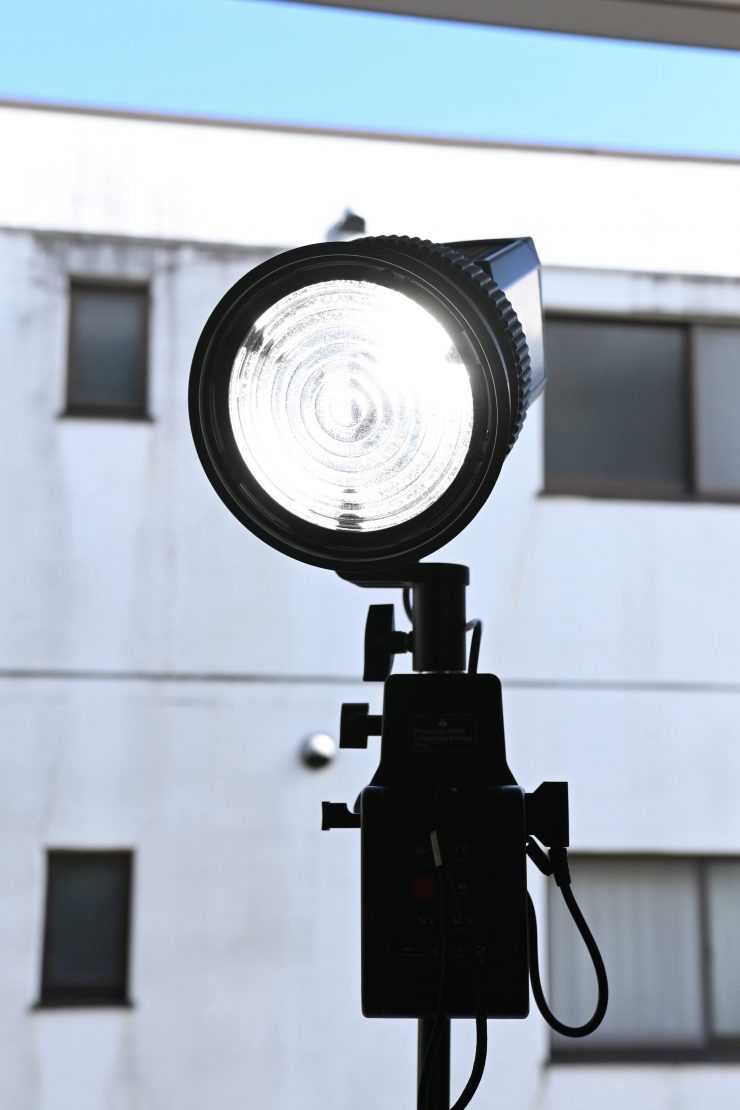
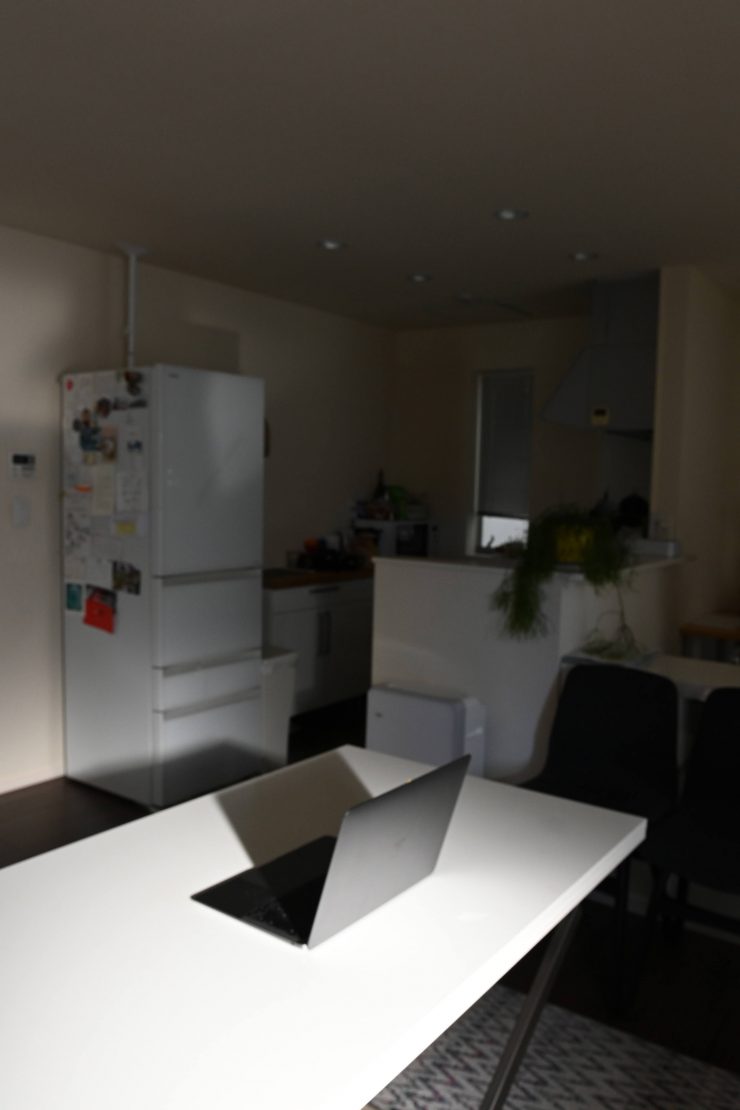
With Fresnel
Above you can see the light used with the optional F-11 Fresnel.
Above you can see the light used with the optional Projection Mount. The Projection mount works really well and it allows you to really concentrate light into a tiny area.
You can create a softer source by utilizing something like the optional Nanlite Forza 60 Softbox ($119 USD). I wouldn’t recommend using the Bowens mount adapter and a Bowens mount softbox, because the beam angle and spread of this light are far too narrow to fill up those types of softboxes.
What you also clearly need to remember with point source lights such as this one is that even though they can generate a decent amount of output when not used with diffusion, once you add diffusion they lose a ton of output because that output is coming from a very small concentrated source.
The light also works well when used with bounce boards or the CRLS reflector system when you combine it with the F-11 Fresnel or Nanlite Projector Mount for Forza 60 and 60B LED Monolights (19°).
Who is the Forza 60C aimed at?
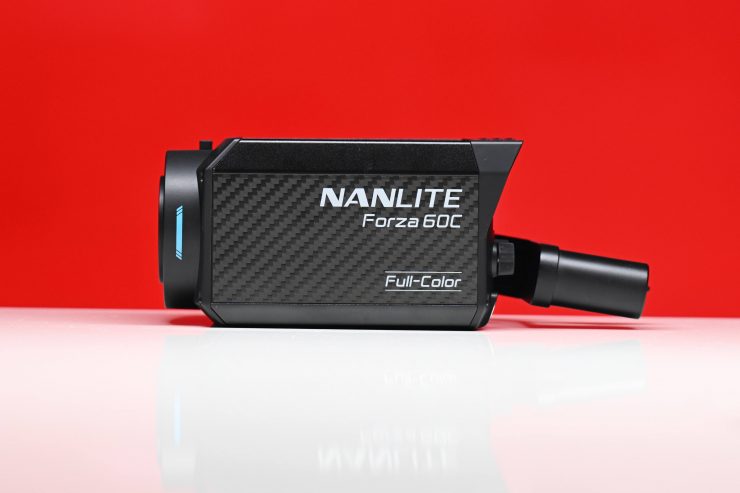
As this is a very versatile lighting source I don’t think that this light is being pigeonholed into being targeted at any specific audience because it could be used for lots of different applications, by lots of different people. I think a lot of people who are in the market for a compact-sized full color light that can easily be run via batteries will be looking closely at this light, especially given the affordable lighting modifiers that are available for it.
It is certainly priced to appeal to owner-operators who are looking for a small-sized jack-of-all-trades lighting solution. The versatility of the Forza 60C allows it to be used as a hard light source, a soft source, a fresnel, a gobo, or just about anything else you want it to be with the correct modifier.
I personally think this is one of the most intriguing small-sized full-color fixtures that are currently on the market. It has good color accuracy, and it has consistent output and performance across its wide CCT range.
Price & Availability
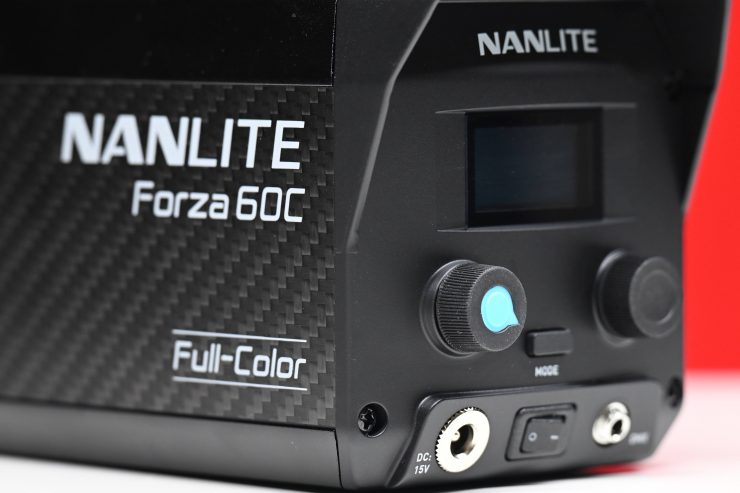
The Nanlite Forza 60C retails for $699 USD and it is available to buy. This makes it a very appealing prospect for those shooters who are looking for a light that offers features and functionality that are usually only found in much more expensive fixtures.
To my knowledge, there really isn’t anything in the way of competition given the power draw, RGBACL color engine, and size of this fixture.
What do you get?
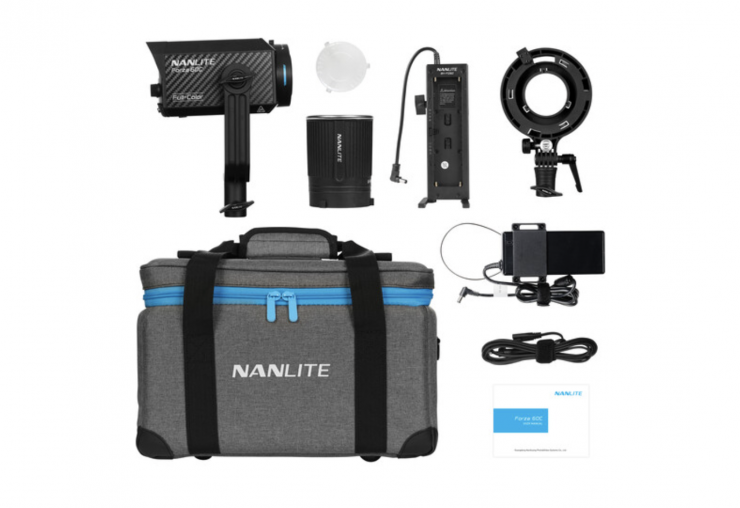
- Nanlite Forza 60C RGBLAC LED Spot Monolight Kit
- Nanlite Forza 60 Bowens Mount Adapter
- Nanlite Forza 60 Battery Grip (NP-F750)
- Nanlite Power Adapter for Forza 60
- Protective COB Cap
- AC Power Cable (10′)
- 45° Reflector
- Carrying Case
- Limited 2-Year Warranty, 1-Year Extension with Registration
Optional Extras
The Nanlite Forza 60C can be used with Nanlite’s own accessories, but because it also comes with a Bowens mount adapter, there are a ton of affordable accessories you could also use. Below you can see how much the key accessories that Nanlite makes sell for:
- Nanlite V-Mount Battery Grip for Forza 60/60B $29.99 USD
- Nanlite Projector Mount for Forza 60 and 60B LED Monolights (19°) $299 USD
- Nanlite Forza 60 Softbox $119 USD
- Nanlite FL-11 Fresnel Lens for Forza 60 $79 USD
Conclusion
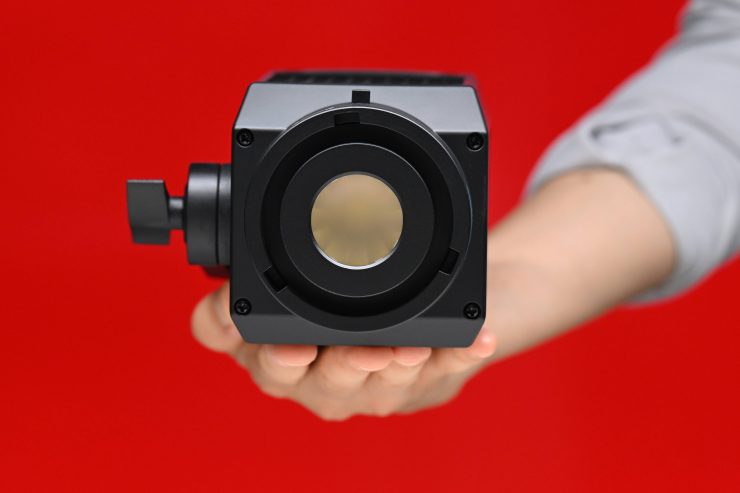
The Nanlite 60C is fully-featured, color-accurate, has a ton of output, and it is easy to use. Its versatility makes it a fixture you can use for so many different applications. As I previously mentioned I don’t know of any other similar fixture that competes with it that you can actually buy.
The output, CCT range, and the ability to run it off flight safe batteries for long periods of time make this light stand out.
Having the ability to use the Forza 60C with the F-11 Fresnel, Projection Mount, and a wide array of lighting modifiers gives the light a lot of versatility.
The interface and operating system could be better, and so could the app. These are two areas I would like to see improved. While the optional Fresnel and Projection Mount are great accessories, they weren’t designed for the 60C and there are a few small caveats when using them that you need to consider carefully, however, there was nothing that I encountered that would make it a deal-breaker.
The fan noise is very minimal and won’t be a concern for most people. The small size and lightweight nature of the fixture make it a great option for anyone who is traveling. A couple of these lights with a few of the modifiers and you could have a small, compact lighting kit that could get you out of trouble.
Yes, the light is substantially more than the Forza 60 and Forza 60B, but in my opinion, it is well priced given its feature set, output, and capabilities. This is the first time Nanlite has used RGBACL, so it will be interesting to see how this light compares to similar RGBWW fixtures that will probably be released in the future. I would imagine it is only a matter of time before Aputure releases a full color version of its LS 60 fixtures. I would also not be surprised to see Nanlite make a full color version of the Forza 720 as well.
Nanlite has certainly stepped things up over the last year or so and the quality of its fixtures has improved a lot. The Forza 60C is an impressive fixture and it does a lot of things really well, but it is far from perfect.
The use of an RGBCAL light engine, coupled with its small size, ability to run off camera batteries, good output, and consistent color rendering, makes this a light that is definitely worth looking at.
Technical Specifications
Like what we do and want to support Newsshooter? Consider becoming a Patreon supporter and help us to continue being the best source of news and reviews for professional tools for the independent filmmaker.

